Blockchain and Cross-Border Payments Industry
VerifiedAdded on 2021/03/03
|43
|14347
|225
AI Summary
The provided assignment is a final year project on blockchain and its application in the cross-border payments industry. It includes a consent form, questionnaire, and references to various research papers and articles on blockchain technology. The questionnaire covers topics such as the aim of implementing blockchain, its impact on security, transparency, and speed of transactions, and the future prospects of blockchain in the cross-border payments sector.
Contribute Materials
Your contribution can guide someone’s learning journey. Share your
documents today.
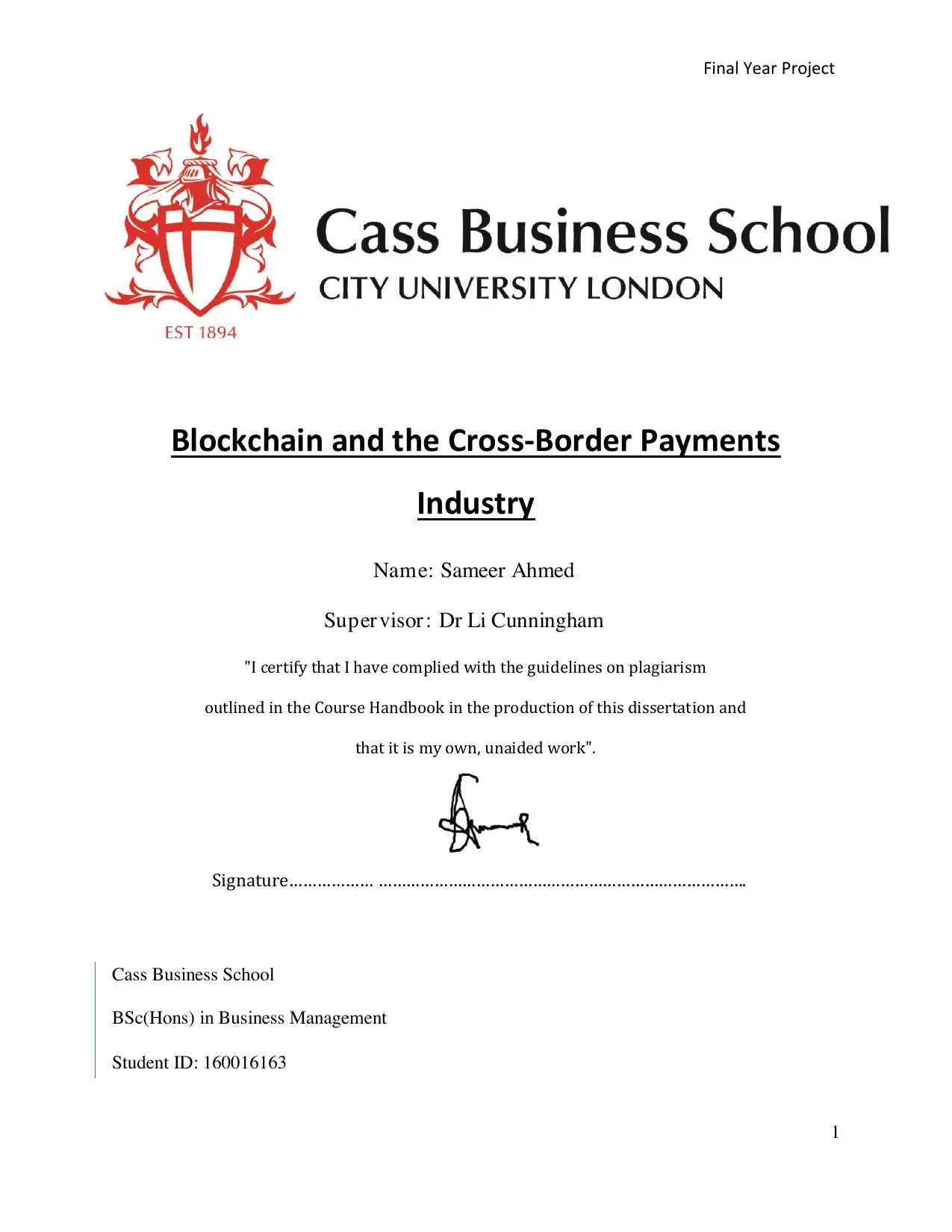
Final Year Project
1
Blockchain and the Cross-Border Payments
Industry
Name: Sameer Ahmed
Supervisor: Dr Li Cunningham
"I certify that I have complied with the guidelines on plagiarism
outlined in the Course Handbook in the production of this dissertation and
that it is my own, unaided work".
Signature……………… …………………………………………………………………….
Cass Business School
BSc(Hons) in Business Management
Student ID: 160016163
1
Blockchain and the Cross-Border Payments
Industry
Name: Sameer Ahmed
Supervisor: Dr Li Cunningham
"I certify that I have complied with the guidelines on plagiarism
outlined in the Course Handbook in the production of this dissertation and
that it is my own, unaided work".
Signature……………… …………………………………………………………………….
Cass Business School
BSc(Hons) in Business Management
Student ID: 160016163
Secure Best Marks with AI Grader
Need help grading? Try our AI Grader for instant feedback on your assignments.
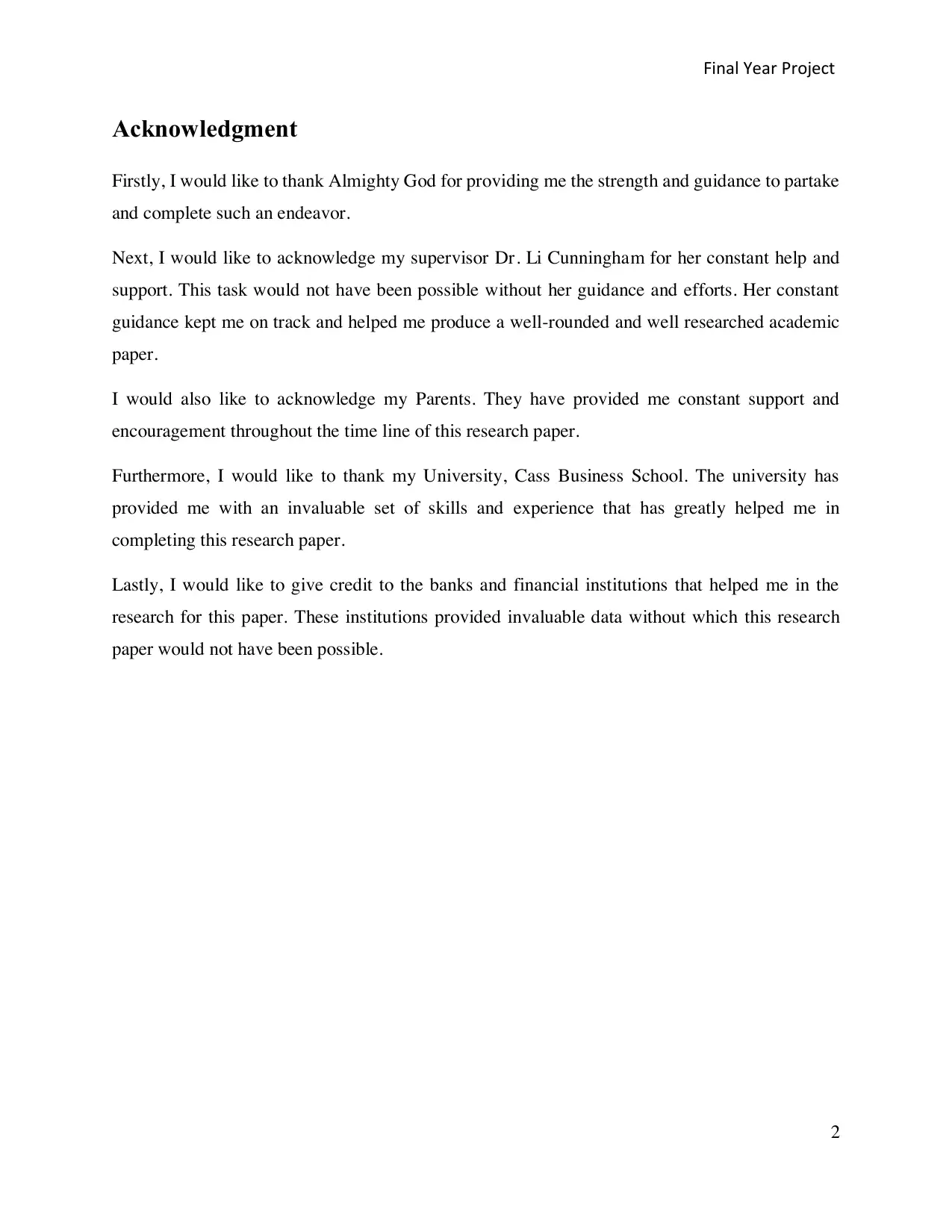
Final Year Project
2
Acknowledgment
Firstly, I would like to thank Almighty God for providing me the strength and guidance to partake
and complete such an endeavor.
Next, I would like to acknowledge my supervisor Dr. Li Cunningham for her constant help and
support. This task would not have been possible without her guidance and efforts. Her constant
guidance kept me on track and helped me produce a well-rounded and well researched academic
paper.
I would also like to acknowledge my Parents. They have provided me constant support and
encouragement throughout the time line of this research paper.
Furthermore, I would like to thank my University, Cass Business School. The university has
provided me with an invaluable set of skills and experience that has greatly helped me in
completing this research paper.
Lastly, I would like to give credit to the banks and financial institutions that helped me in the
research for this paper. These institutions provided invaluable data without which this research
paper would not have been possible.
2
Acknowledgment
Firstly, I would like to thank Almighty God for providing me the strength and guidance to partake
and complete such an endeavor.
Next, I would like to acknowledge my supervisor Dr. Li Cunningham for her constant help and
support. This task would not have been possible without her guidance and efforts. Her constant
guidance kept me on track and helped me produce a well-rounded and well researched academic
paper.
I would also like to acknowledge my Parents. They have provided me constant support and
encouragement throughout the time line of this research paper.
Furthermore, I would like to thank my University, Cass Business School. The university has
provided me with an invaluable set of skills and experience that has greatly helped me in
completing this research paper.
Lastly, I would like to give credit to the banks and financial institutions that helped me in the
research for this paper. These institutions provided invaluable data without which this research
paper would not have been possible.

Final Year Project
3
Abstract
This research paper provides an insight into the concept of blockchain and how it is revolutionizing
the cross border payments industry. This research paper thus sets out to investigate whether a
disruptive technology like blockchain proves to be a more viable and efficient solution to the ever
growing issues faced by the payments industry. Blockchain technology has the potential to
revolutionize the payments industry. While people expect a lot from the technology, the real world
benefits are still not clear. However, the technology is undergoing mass adoption by major
companies because of which its benefits are becoming clearer day by day.
The research method used for this research paper is questionnaires. A number of people from
companies in the banking and finance industry that have adopted Blockchain were chosen to fill
out the questionnaires. This gave the researcher a good overall view about whether Blockchain has
helped or made improvements in the Cross border payments and settlements category.
After a thorough analysis of the authors research findings and an in-depth view of the existing
literature the author has concluded that blockchain technology is overall more efficient than
existing technology in the cross border payments sector and is on track to mass adoption.
3
Abstract
This research paper provides an insight into the concept of blockchain and how it is revolutionizing
the cross border payments industry. This research paper thus sets out to investigate whether a
disruptive technology like blockchain proves to be a more viable and efficient solution to the ever
growing issues faced by the payments industry. Blockchain technology has the potential to
revolutionize the payments industry. While people expect a lot from the technology, the real world
benefits are still not clear. However, the technology is undergoing mass adoption by major
companies because of which its benefits are becoming clearer day by day.
The research method used for this research paper is questionnaires. A number of people from
companies in the banking and finance industry that have adopted Blockchain were chosen to fill
out the questionnaires. This gave the researcher a good overall view about whether Blockchain has
helped or made improvements in the Cross border payments and settlements category.
After a thorough analysis of the authors research findings and an in-depth view of the existing
literature the author has concluded that blockchain technology is overall more efficient than
existing technology in the cross border payments sector and is on track to mass adoption.
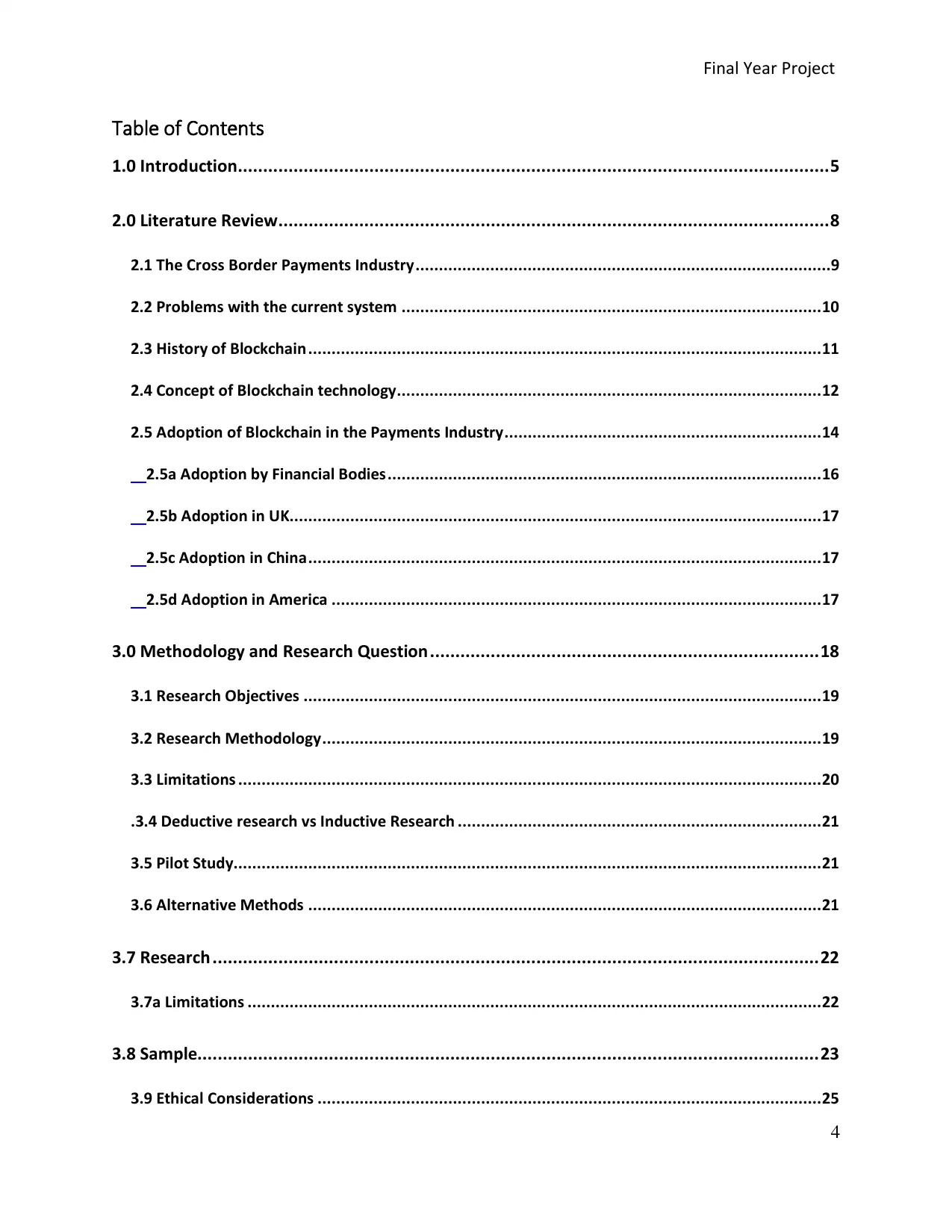
Final Year Project
4
Table of Contents
1.0 Introduction..................................................................................................................... 5
2.0 Literature Review............................................................................................................. 8
2.1 The Cross Border Payments Industry .........................................................................................9
2.2 Problems with the current system .......................................................................................... 10
2.3 History of Blockchain .............................................................................................................. 11
2.4 Concept of Blockchain technology ........................................................................................... 12
2.5 Adoption of Blockchain in the Payments Industry .................................................................... 14
2.5a Adoption by Financial Bodies ............................................................................................. 16
2.5b Adoption in UK.................................................................................................................. 17
2.5c Adoption in China .............................................................................................................. 17
2.5d Adoption in America ......................................................................................................... 17
3.0 Methodology and Research Question ............................................................................. 18
3.1 Research Objectives ............................................................................................................... 19
3.2 Research Methodology ........................................................................................................... 19
3.3 Limitations ............................................................................................................................. 20
.3.4 Deductive research vs Inductive Research .............................................................................. 21
3.5 Pilot Study.............................................................................................................................. 21
3.6 Alternative Methods .............................................................................................................. 21
3.7 Research ........................................................................................................................ 22
3.7a Limitations ........................................................................................................................... 22
3.8 Sample........................................................................................................................... 23
3.9 Ethical Considerations ............................................................................................................ 25
4
Table of Contents
1.0 Introduction..................................................................................................................... 5
2.0 Literature Review............................................................................................................. 8
2.1 The Cross Border Payments Industry .........................................................................................9
2.2 Problems with the current system .......................................................................................... 10
2.3 History of Blockchain .............................................................................................................. 11
2.4 Concept of Blockchain technology ........................................................................................... 12
2.5 Adoption of Blockchain in the Payments Industry .................................................................... 14
2.5a Adoption by Financial Bodies ............................................................................................. 16
2.5b Adoption in UK.................................................................................................................. 17
2.5c Adoption in China .............................................................................................................. 17
2.5d Adoption in America ......................................................................................................... 17
3.0 Methodology and Research Question ............................................................................. 18
3.1 Research Objectives ............................................................................................................... 19
3.2 Research Methodology ........................................................................................................... 19
3.3 Limitations ............................................................................................................................. 20
.3.4 Deductive research vs Inductive Research .............................................................................. 21
3.5 Pilot Study.............................................................................................................................. 21
3.6 Alternative Methods .............................................................................................................. 21
3.7 Research ........................................................................................................................ 22
3.7a Limitations ........................................................................................................................... 22
3.8 Sample........................................................................................................................... 23
3.9 Ethical Considerations ............................................................................................................ 25
Secure Best Marks with AI Grader
Need help grading? Try our AI Grader for instant feedback on your assignments.
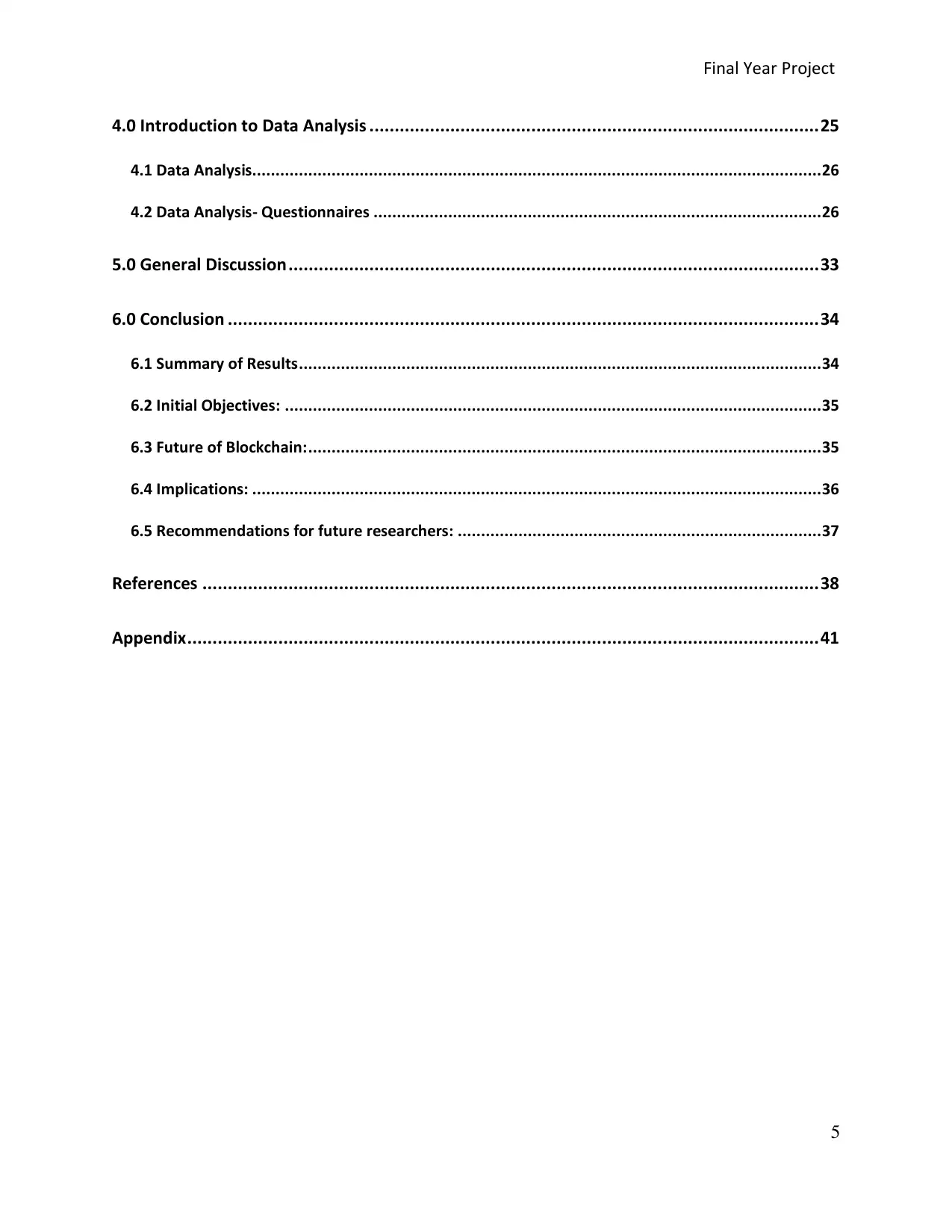
Final Year Project
5
4.0 Introduction to Data Analysis ......................................................................................... 25
4.1 Data Analysis.......................................................................................................................... 26
4.2 Data Analysis- Questionnaires ................................................................................................ 26
5.0 General Discussion ......................................................................................................... 33
6.0 Conclusion ..................................................................................................................... 34
6.1 Summary of Results ................................................................................................................ 34
6.2 Initial Objectives: ................................................................................................................... 35
6.3 Future of Blockchain: .............................................................................................................. 35
6.4 Implications: .......................................................................................................................... 36
6.5 Recommendations for future researchers: .............................................................................. 37
References .......................................................................................................................... 38
Appendix ............................................................................................................................. 41
5
4.0 Introduction to Data Analysis ......................................................................................... 25
4.1 Data Analysis.......................................................................................................................... 26
4.2 Data Analysis- Questionnaires ................................................................................................ 26
5.0 General Discussion ......................................................................................................... 33
6.0 Conclusion ..................................................................................................................... 34
6.1 Summary of Results ................................................................................................................ 34
6.2 Initial Objectives: ................................................................................................................... 35
6.3 Future of Blockchain: .............................................................................................................. 35
6.4 Implications: .......................................................................................................................... 36
6.5 Recommendations for future researchers: .............................................................................. 37
References .......................................................................................................................... 38
Appendix ............................................................................................................................. 41
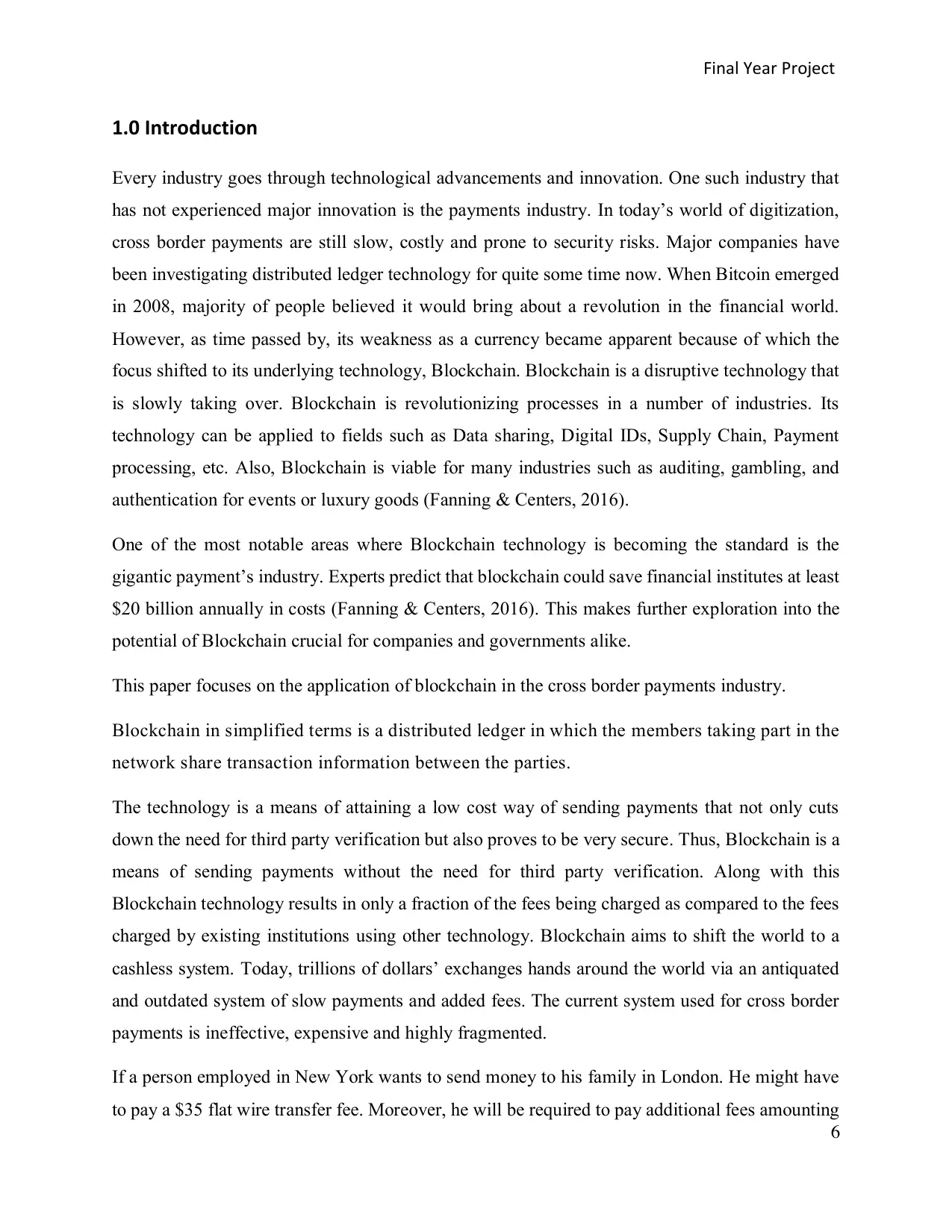
Final Year Project
6
1.0 Introduction
Every industry goes through technological advancements and innovation. One such industry that
has not experienced major innovation is the payments industry. In today’s world of digitization,
cross border payments are still slow, costly and prone to security risks. Major companies have
been investigating distributed ledger technology for quite some time now. When Bitcoin emerged
in 2008, majority of people believed it would bring about a revolution in the financial world.
However, as time passed by, its weakness as a currency became apparent because of which the
focus shifted to its underlying technology, Blockchain. Blockchain is a disruptive technology that
is slowly taking over. Blockchain is revolutionizing processes in a number of industries. Its
technology can be applied to fields such as Data sharing, Digital IDs, Supply Chain, Payment
processing, etc. Also, Blockchain is viable for many industries such as auditing, gambling, and
authentication for events or luxury goods (Fanning & Centers, 2016).
One of the most notable areas where Blockchain technology is becoming the standard is the
gigantic payment’s industry. Experts predict that blockchain could save financial institutes at least
$20 billion annually in costs (Fanning & Centers, 2016). This makes further exploration into the
potential of Blockchain crucial for companies and governments alike.
This paper focuses on the application of blockchain in the cross border payments industry.
Blockchain in simplified terms is a distributed ledger in which the members taking part in the
network share transaction information between the parties.
The technology is a means of attaining a low cost way of sending payments that not only cuts
down the need for third party verification but also proves to be very secure. Thus, Blockchain is a
means of sending payments without the need for third party verification. Along with this
Blockchain technology results in only a fraction of the fees being charged as compared to the fees
charged by existing institutions using other technology. Blockchain aims to shift the world to a
cashless system. Today, trillions of dollars’ exchanges hands around the world via an antiquated
and outdated system of slow payments and added fees. The current system used for cross border
payments is ineffective, expensive and highly fragmented.
If a person employed in New York wants to send money to his family in London. He might have
to pay a $35 flat wire transfer fee. Moreover, he will be required to pay additional fees amounting
6
1.0 Introduction
Every industry goes through technological advancements and innovation. One such industry that
has not experienced major innovation is the payments industry. In today’s world of digitization,
cross border payments are still slow, costly and prone to security risks. Major companies have
been investigating distributed ledger technology for quite some time now. When Bitcoin emerged
in 2008, majority of people believed it would bring about a revolution in the financial world.
However, as time passed by, its weakness as a currency became apparent because of which the
focus shifted to its underlying technology, Blockchain. Blockchain is a disruptive technology that
is slowly taking over. Blockchain is revolutionizing processes in a number of industries. Its
technology can be applied to fields such as Data sharing, Digital IDs, Supply Chain, Payment
processing, etc. Also, Blockchain is viable for many industries such as auditing, gambling, and
authentication for events or luxury goods (Fanning & Centers, 2016).
One of the most notable areas where Blockchain technology is becoming the standard is the
gigantic payment’s industry. Experts predict that blockchain could save financial institutes at least
$20 billion annually in costs (Fanning & Centers, 2016). This makes further exploration into the
potential of Blockchain crucial for companies and governments alike.
This paper focuses on the application of blockchain in the cross border payments industry.
Blockchain in simplified terms is a distributed ledger in which the members taking part in the
network share transaction information between the parties.
The technology is a means of attaining a low cost way of sending payments that not only cuts
down the need for third party verification but also proves to be very secure. Thus, Blockchain is a
means of sending payments without the need for third party verification. Along with this
Blockchain technology results in only a fraction of the fees being charged as compared to the fees
charged by existing institutions using other technology. Blockchain aims to shift the world to a
cashless system. Today, trillions of dollars’ exchanges hands around the world via an antiquated
and outdated system of slow payments and added fees. The current system used for cross border
payments is ineffective, expensive and highly fragmented.
If a person employed in New York wants to send money to his family in London. He might have
to pay a $35 flat wire transfer fee. Moreover, he will be required to pay additional fees amounting
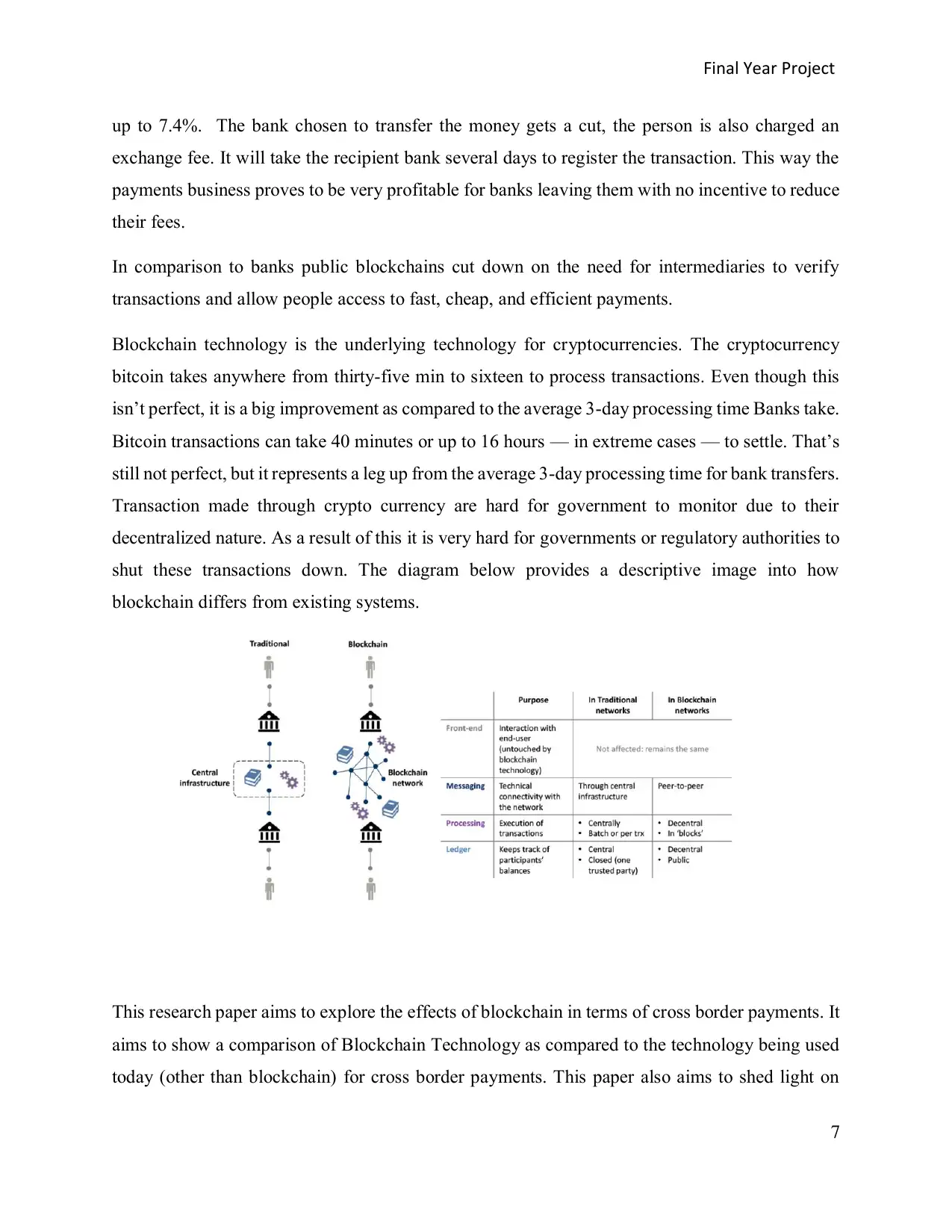
Final Year Project
7
up to 7.4%. The bank chosen to transfer the money gets a cut, the person is also charged an
exchange fee. It will take the recipient bank several days to register the transaction. This way the
payments business proves to be very profitable for banks leaving them with no incentive to reduce
their fees.
In comparison to banks public blockchains cut down on the need for intermediaries to verify
transactions and allow people access to fast, cheap, and efficient payments.
Blockchain technology is the underlying technology for cryptocurrencies. The cryptocurrency
bitcoin takes anywhere from thirty-five min to sixteen to process transactions. Even though this
isn’t perfect, it is a big improvement as compared to the average 3-day processing time Banks take.
Bitcoin transactions can take 40 minutes or up to 16 hours — in extreme cases — to settle. That’s
still not perfect, but it represents a leg up from the average 3-day processing time for bank transfers.
Transaction made through crypto currency are hard for government to monitor due to their
decentralized nature. As a result of this it is very hard for governments or regulatory authorities to
shut these transactions down. The diagram below provides a descriptive image into how
blockchain differs from existing systems.
This research paper aims to explore the effects of blockchain in terms of cross border payments. It
aims to show a comparison of Blockchain Technology as compared to the technology being used
today (other than blockchain) for cross border payments. This paper also aims to shed light on
7
up to 7.4%. The bank chosen to transfer the money gets a cut, the person is also charged an
exchange fee. It will take the recipient bank several days to register the transaction. This way the
payments business proves to be very profitable for banks leaving them with no incentive to reduce
their fees.
In comparison to banks public blockchains cut down on the need for intermediaries to verify
transactions and allow people access to fast, cheap, and efficient payments.
Blockchain technology is the underlying technology for cryptocurrencies. The cryptocurrency
bitcoin takes anywhere from thirty-five min to sixteen to process transactions. Even though this
isn’t perfect, it is a big improvement as compared to the average 3-day processing time Banks take.
Bitcoin transactions can take 40 minutes or up to 16 hours — in extreme cases — to settle. That’s
still not perfect, but it represents a leg up from the average 3-day processing time for bank transfers.
Transaction made through crypto currency are hard for government to monitor due to their
decentralized nature. As a result of this it is very hard for governments or regulatory authorities to
shut these transactions down. The diagram below provides a descriptive image into how
blockchain differs from existing systems.
This research paper aims to explore the effects of blockchain in terms of cross border payments. It
aims to show a comparison of Blockchain Technology as compared to the technology being used
today (other than blockchain) for cross border payments. This paper also aims to shed light on
Paraphrase This Document
Need a fresh take? Get an instant paraphrase of this document with our AI Paraphraser
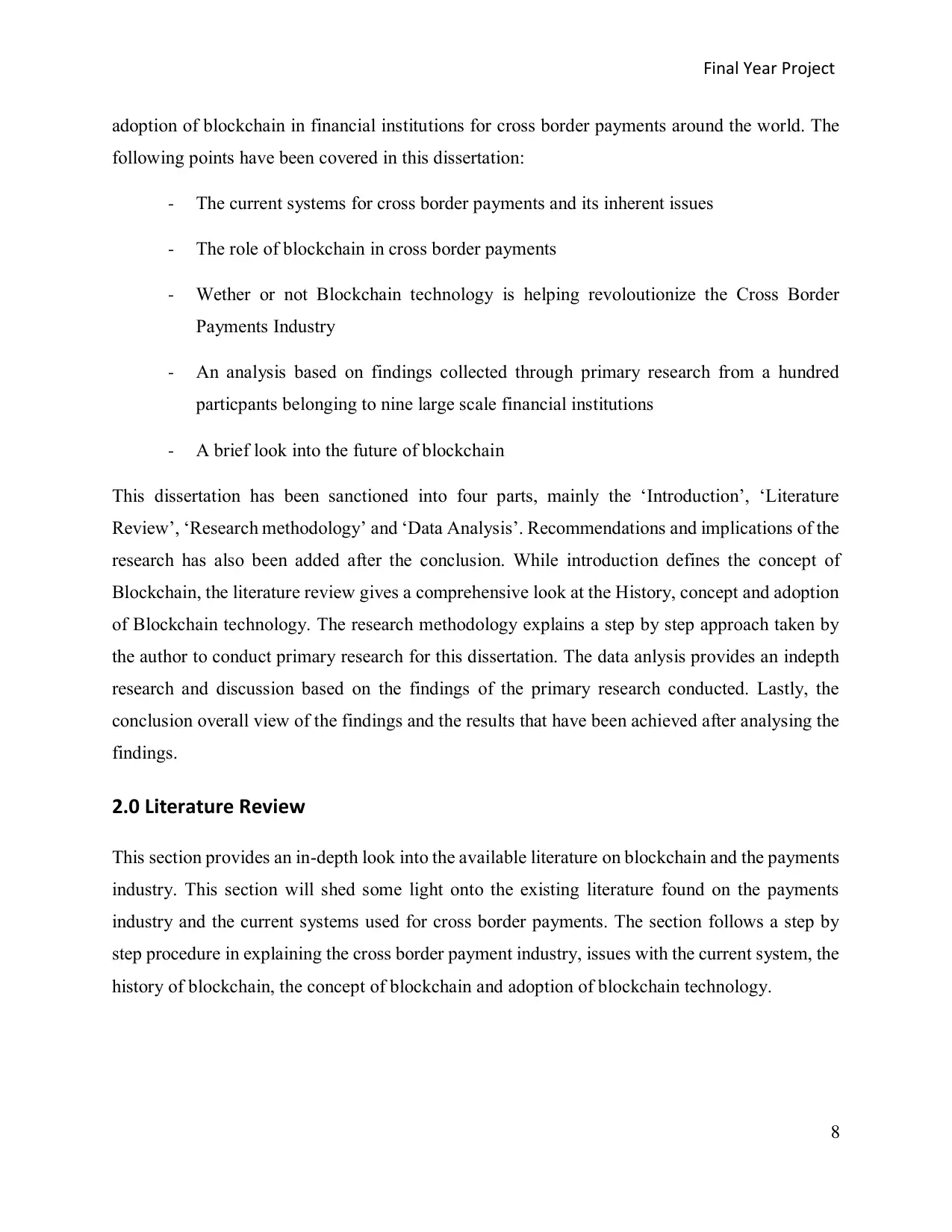
Final Year Project
8
adoption of blockchain in financial institutions for cross border payments around the world. The
following points have been covered in this dissertation:
- The current systems for cross border payments and its inherent issues
- The role of blockchain in cross border payments
- Wether or not Blockchain technology is helping revoloutionize the Cross Border
Payments Industry
- An analysis based on findings collected through primary research from a hundred
particpants belonging to nine large scale financial institutions
- A brief look into the future of blockchain
This dissertation has been sanctioned into four parts, mainly the ‘Introduction’, ‘Literature
Review’, ‘Research methodology’ and ‘Data Analysis’. Recommendations and implications of the
research has also been added after the conclusion. While introduction defines the concept of
Blockchain, the literature review gives a comprehensive look at the History, concept and adoption
of Blockchain technology. The research methodology explains a step by step approach taken by
the author to conduct primary research for this dissertation. The data anlysis provides an indepth
research and discussion based on the findings of the primary research conducted. Lastly, the
conclusion overall view of the findings and the results that have been achieved after analysing the
findings.
2.0 Literature Review
This section provides an in-depth look into the available literature on blockchain and the payments
industry. This section will shed some light onto the existing literature found on the payments
industry and the current systems used for cross border payments. The section follows a step by
step procedure in explaining the cross border payment industry, issues with the current system, the
history of blockchain, the concept of blockchain and adoption of blockchain technology.
8
adoption of blockchain in financial institutions for cross border payments around the world. The
following points have been covered in this dissertation:
- The current systems for cross border payments and its inherent issues
- The role of blockchain in cross border payments
- Wether or not Blockchain technology is helping revoloutionize the Cross Border
Payments Industry
- An analysis based on findings collected through primary research from a hundred
particpants belonging to nine large scale financial institutions
- A brief look into the future of blockchain
This dissertation has been sanctioned into four parts, mainly the ‘Introduction’, ‘Literature
Review’, ‘Research methodology’ and ‘Data Analysis’. Recommendations and implications of the
research has also been added after the conclusion. While introduction defines the concept of
Blockchain, the literature review gives a comprehensive look at the History, concept and adoption
of Blockchain technology. The research methodology explains a step by step approach taken by
the author to conduct primary research for this dissertation. The data anlysis provides an indepth
research and discussion based on the findings of the primary research conducted. Lastly, the
conclusion overall view of the findings and the results that have been achieved after analysing the
findings.
2.0 Literature Review
This section provides an in-depth look into the available literature on blockchain and the payments
industry. This section will shed some light onto the existing literature found on the payments
industry and the current systems used for cross border payments. The section follows a step by
step procedure in explaining the cross border payment industry, issues with the current system, the
history of blockchain, the concept of blockchain and adoption of blockchain technology.
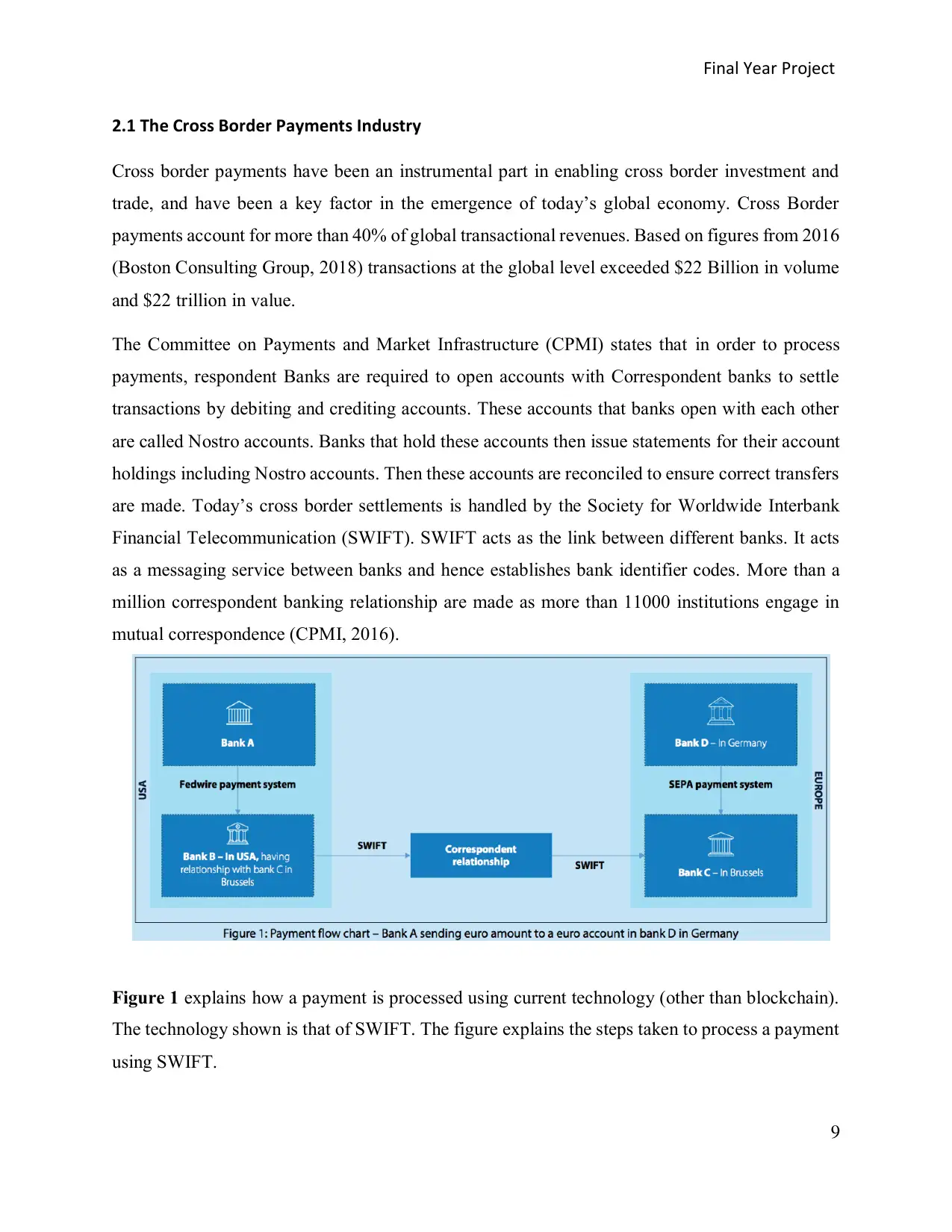
Final Year Project
9
2.1 The Cross Border Payments Industry
Cross border payments have been an instrumental part in enabling cross border investment and
trade, and have been a key factor in the emergence of today’s global economy. Cross Border
payments account for more than 40% of global transactional revenues. Based on figures from 2016
(Boston Consulting Group, 2018) transactions at the global level exceeded $22 Billion in volume
and $22 trillion in value.
The Committee on Payments and Market Infrastructure (CPMI) states that in order to process
payments, respondent Banks are required to open accounts with Correspondent banks to settle
transactions by debiting and crediting accounts. These accounts that banks open with each other
are called Nostro accounts. Banks that hold these accounts then issue statements for their account
holdings including Nostro accounts. Then these accounts are reconciled to ensure correct transfers
are made. Today’s cross border settlements is handled by the Society for Worldwide Interbank
Financial Telecommunication (SWIFT). SWIFT acts as the link between different banks. It acts
as a messaging service between banks and hence establishes bank identifier codes. More than a
million correspondent banking relationship are made as more than 11000 institutions engage in
mutual correspondence (CPMI, 2016).
Figure 1 explains how a payment is processed using current technology (other than blockchain).
The technology shown is that of SWIFT. The figure explains the steps taken to process a payment
using SWIFT.
9
2.1 The Cross Border Payments Industry
Cross border payments have been an instrumental part in enabling cross border investment and
trade, and have been a key factor in the emergence of today’s global economy. Cross Border
payments account for more than 40% of global transactional revenues. Based on figures from 2016
(Boston Consulting Group, 2018) transactions at the global level exceeded $22 Billion in volume
and $22 trillion in value.
The Committee on Payments and Market Infrastructure (CPMI) states that in order to process
payments, respondent Banks are required to open accounts with Correspondent banks to settle
transactions by debiting and crediting accounts. These accounts that banks open with each other
are called Nostro accounts. Banks that hold these accounts then issue statements for their account
holdings including Nostro accounts. Then these accounts are reconciled to ensure correct transfers
are made. Today’s cross border settlements is handled by the Society for Worldwide Interbank
Financial Telecommunication (SWIFT). SWIFT acts as the link between different banks. It acts
as a messaging service between banks and hence establishes bank identifier codes. More than a
million correspondent banking relationship are made as more than 11000 institutions engage in
mutual correspondence (CPMI, 2016).
Figure 1 explains how a payment is processed using current technology (other than blockchain).
The technology shown is that of SWIFT. The figure explains the steps taken to process a payment
using SWIFT.
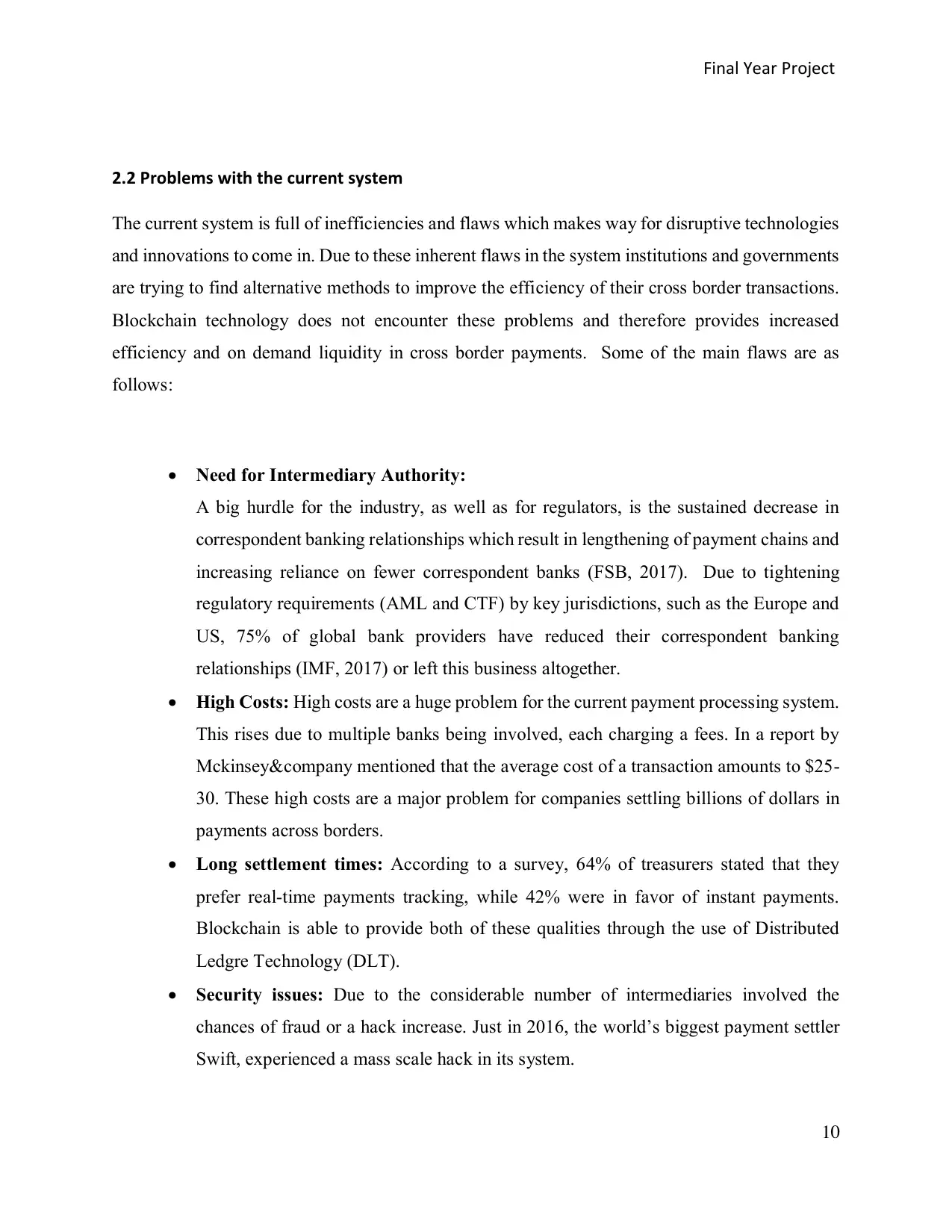
Final Year Project
10
2.2 Problems with the current system
The current system is full of inefficiencies and flaws which makes way for disruptive technologies
and innovations to come in. Due to these inherent flaws in the system institutions and governments
are trying to find alternative methods to improve the efficiency of their cross border transactions.
Blockchain technology does not encounter these problems and therefore provides increased
efficiency and on demand liquidity in cross border payments. Some of the main flaws are as
follows:
• Need for Intermediary Authority:
A big hurdle for the industry, as well as for regulators, is the sustained decrease in
correspondent banking relationships which result in lengthening of payment chains and
increasing reliance on fewer correspondent banks (FSB, 2017). Due to tightening
regulatory requirements (AML and CTF) by key jurisdictions, such as the Europe and
US, 75% of global bank providers have reduced their correspondent banking
relationships (IMF, 2017) or left this business altogether.
• High Costs: High costs are a huge problem for the current payment processing system.
This rises due to multiple banks being involved, each charging a fees. In a report by
Mckinsey&company mentioned that the average cost of a transaction amounts to $25-
30. These high costs are a major problem for companies settling billions of dollars in
payments across borders.
• Long settlement times: According to a survey, 64% of treasurers stated that they
prefer real-time payments tracking, while 42% were in favor of instant payments.
Blockchain is able to provide both of these qualities through the use of Distributed
Ledgre Technology (DLT).
• Security issues: Due to the considerable number of intermediaries involved the
chances of fraud or a hack increase. Just in 2016, the world’s biggest payment settler
Swift, experienced a mass scale hack in its system.
10
2.2 Problems with the current system
The current system is full of inefficiencies and flaws which makes way for disruptive technologies
and innovations to come in. Due to these inherent flaws in the system institutions and governments
are trying to find alternative methods to improve the efficiency of their cross border transactions.
Blockchain technology does not encounter these problems and therefore provides increased
efficiency and on demand liquidity in cross border payments. Some of the main flaws are as
follows:
• Need for Intermediary Authority:
A big hurdle for the industry, as well as for regulators, is the sustained decrease in
correspondent banking relationships which result in lengthening of payment chains and
increasing reliance on fewer correspondent banks (FSB, 2017). Due to tightening
regulatory requirements (AML and CTF) by key jurisdictions, such as the Europe and
US, 75% of global bank providers have reduced their correspondent banking
relationships (IMF, 2017) or left this business altogether.
• High Costs: High costs are a huge problem for the current payment processing system.
This rises due to multiple banks being involved, each charging a fees. In a report by
Mckinsey&company mentioned that the average cost of a transaction amounts to $25-
30. These high costs are a major problem for companies settling billions of dollars in
payments across borders.
• Long settlement times: According to a survey, 64% of treasurers stated that they
prefer real-time payments tracking, while 42% were in favor of instant payments.
Blockchain is able to provide both of these qualities through the use of Distributed
Ledgre Technology (DLT).
• Security issues: Due to the considerable number of intermediaries involved the
chances of fraud or a hack increase. Just in 2016, the world’s biggest payment settler
Swift, experienced a mass scale hack in its system.
Secure Best Marks with AI Grader
Need help grading? Try our AI Grader for instant feedback on your assignments.

Final Year Project
11
2.3 History of Blockchain
Milton Friedman, a Nobel prize winning economist (1999) said,
“the one thing that’s missing is a reliable e-cash, whereby on the internet you can transfer funds from
A to B without A knowing B or B knowing A”.
Digital payments are similar to payments processed through digital means, for example, the
transactions between a cash register and an electronic wallet or through digital money. (Staykova,
K.S., and Dalsgaard, J, 2015). The Cryptographic Mailing List published a report titled, “Bitcoin:
A Peer-to-Peer Electronic Cash System”. The report focuses mainly on a digital currency that does
not require the use of a mediator or a third party. This is evident from the beginning sentence of
the document: “A purely peer-to-peer version of electronic cash would allow online payments to
be sent directly from one party to another without going through a financial institution”
(Nakamoto, 2008).
However, this was not the first time in history that digital payments were mentioned, as in 1970
David Chaum in two publications introduced the concept of a digital currency. After the report a
small amount of institutions made several attempts to introduce digital currencies like e-gold and
e-cash. (Frisby, 2014).
Nakamoto (2008) introduced Blockchain technology was mainly to bypass intermediaries or third
partys such as financial institutions by allowing the participants to conduct peer-to-peer
transactions directly. To accomplish this, Nakamoto developed a peer-to-peer distributed ledger.
By using this distributed ledger, the payee and the payer can exchange and correspond directly
over the network, using consensus mechanisms and encryption (Guo & Liang, 2016; Tsai, Blower,
Zhu, & Yu, 2016; Zhu & Zhou, 2016) to render these transactions to be immune to tampering as
any change to the historical data record is traceable and detectable by the blockchain network
nodes that are participating (B. Lee & Lee, 2017; Tapscott & Tapscott, 2017). The transactions
based on the distributed ledger allow for transaction to be processed quickly and seamlessly, while
also minimizing the potential drawbacks of a trust based model.
11
2.3 History of Blockchain
Milton Friedman, a Nobel prize winning economist (1999) said,
“the one thing that’s missing is a reliable e-cash, whereby on the internet you can transfer funds from
A to B without A knowing B or B knowing A”.
Digital payments are similar to payments processed through digital means, for example, the
transactions between a cash register and an electronic wallet or through digital money. (Staykova,
K.S., and Dalsgaard, J, 2015). The Cryptographic Mailing List published a report titled, “Bitcoin:
A Peer-to-Peer Electronic Cash System”. The report focuses mainly on a digital currency that does
not require the use of a mediator or a third party. This is evident from the beginning sentence of
the document: “A purely peer-to-peer version of electronic cash would allow online payments to
be sent directly from one party to another without going through a financial institution”
(Nakamoto, 2008).
However, this was not the first time in history that digital payments were mentioned, as in 1970
David Chaum in two publications introduced the concept of a digital currency. After the report a
small amount of institutions made several attempts to introduce digital currencies like e-gold and
e-cash. (Frisby, 2014).
Nakamoto (2008) introduced Blockchain technology was mainly to bypass intermediaries or third
partys such as financial institutions by allowing the participants to conduct peer-to-peer
transactions directly. To accomplish this, Nakamoto developed a peer-to-peer distributed ledger.
By using this distributed ledger, the payee and the payer can exchange and correspond directly
over the network, using consensus mechanisms and encryption (Guo & Liang, 2016; Tsai, Blower,
Zhu, & Yu, 2016; Zhu & Zhou, 2016) to render these transactions to be immune to tampering as
any change to the historical data record is traceable and detectable by the blockchain network
nodes that are participating (B. Lee & Lee, 2017; Tapscott & Tapscott, 2017). The transactions
based on the distributed ledger allow for transaction to be processed quickly and seamlessly, while
also minimizing the potential drawbacks of a trust based model.
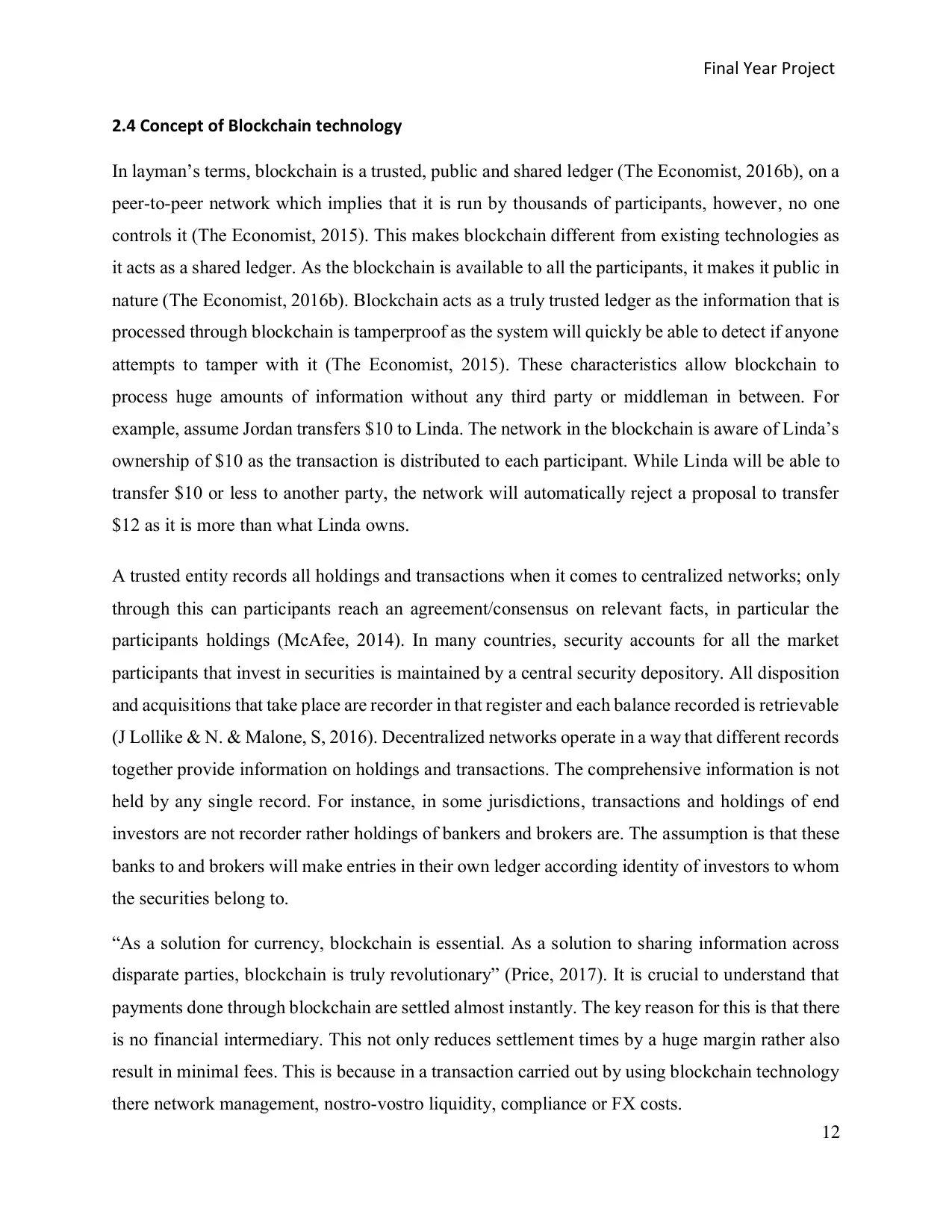
Final Year Project
12
2.4 Concept of Blockchain technology
In layman’s terms, blockchain is a trusted, public and shared ledger (The Economist, 2016b), on a
peer-to-peer network which implies that it is run by thousands of participants, however, no one
controls it (The Economist, 2015). This makes blockchain different from existing technologies as
it acts as a shared ledger. As the blockchain is available to all the participants, it makes it public in
nature (The Economist, 2016b). Blockchain acts as a truly trusted ledger as the information that is
processed through blockchain is tamperproof as the system will quickly be able to detect if anyone
attempts to tamper with it (The Economist, 2015). These characteristics allow blockchain to
process huge amounts of information without any third party or middleman in between. For
example, assume Jordan transfers $10 to Linda. The network in the blockchain is aware of Linda’s
ownership of $10 as the transaction is distributed to each participant. While Linda will be able to
transfer $10 or less to another party, the network will automatically reject a proposal to transfer
$12 as it is more than what Linda owns.
A trusted entity records all holdings and transactions when it comes to centralized networks; only
through this can participants reach an agreement/consensus on relevant facts, in particular the
participants holdings (McAfee, 2014). In many countries, security accounts for all the market
participants that invest in securities is maintained by a central security depository. All disposition
and acquisitions that take place are recorder in that register and each balance recorded is retrievable
(J Lollike & N. & Malone, S, 2016). Decentralized networks operate in a way that different records
together provide information on holdings and transactions. The comprehensive information is not
held by any single record. For instance, in some jurisdictions, transactions and holdings of end
investors are not recorder rather holdings of bankers and brokers are. The assumption is that these
banks to and brokers will make entries in their own ledger according identity of investors to whom
the securities belong to.
“As a solution for currency, blockchain is essential. As a solution to sharing information across
disparate parties, blockchain is truly revolutionary” (Price, 2017). It is crucial to understand that
payments done through blockchain are settled almost instantly. The key reason for this is that there
is no financial intermediary. This not only reduces settlement times by a huge margin rather also
result in minimal fees. This is because in a transaction carried out by using blockchain technology
there network management, nostro-vostro liquidity, compliance or FX costs.
12
2.4 Concept of Blockchain technology
In layman’s terms, blockchain is a trusted, public and shared ledger (The Economist, 2016b), on a
peer-to-peer network which implies that it is run by thousands of participants, however, no one
controls it (The Economist, 2015). This makes blockchain different from existing technologies as
it acts as a shared ledger. As the blockchain is available to all the participants, it makes it public in
nature (The Economist, 2016b). Blockchain acts as a truly trusted ledger as the information that is
processed through blockchain is tamperproof as the system will quickly be able to detect if anyone
attempts to tamper with it (The Economist, 2015). These characteristics allow blockchain to
process huge amounts of information without any third party or middleman in between. For
example, assume Jordan transfers $10 to Linda. The network in the blockchain is aware of Linda’s
ownership of $10 as the transaction is distributed to each participant. While Linda will be able to
transfer $10 or less to another party, the network will automatically reject a proposal to transfer
$12 as it is more than what Linda owns.
A trusted entity records all holdings and transactions when it comes to centralized networks; only
through this can participants reach an agreement/consensus on relevant facts, in particular the
participants holdings (McAfee, 2014). In many countries, security accounts for all the market
participants that invest in securities is maintained by a central security depository. All disposition
and acquisitions that take place are recorder in that register and each balance recorded is retrievable
(J Lollike & N. & Malone, S, 2016). Decentralized networks operate in a way that different records
together provide information on holdings and transactions. The comprehensive information is not
held by any single record. For instance, in some jurisdictions, transactions and holdings of end
investors are not recorder rather holdings of bankers and brokers are. The assumption is that these
banks to and brokers will make entries in their own ledger according identity of investors to whom
the securities belong to.
“As a solution for currency, blockchain is essential. As a solution to sharing information across
disparate parties, blockchain is truly revolutionary” (Price, 2017). It is crucial to understand that
payments done through blockchain are settled almost instantly. The key reason for this is that there
is no financial intermediary. This not only reduces settlement times by a huge margin rather also
result in minimal fees. This is because in a transaction carried out by using blockchain technology
there network management, nostro-vostro liquidity, compliance or FX costs.
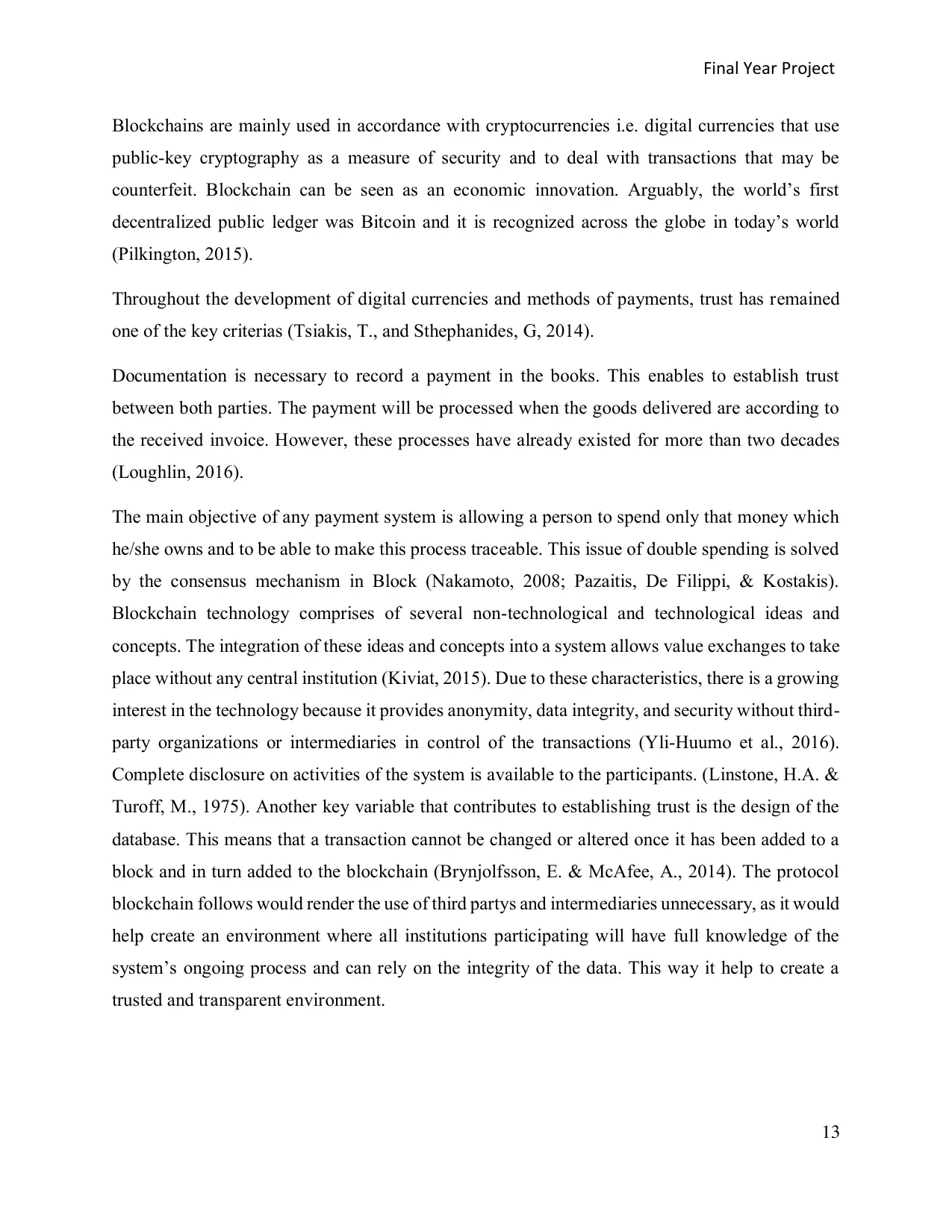
Final Year Project
13
Blockchains are mainly used in accordance with cryptocurrencies i.e. digital currencies that use
public-key cryptography as a measure of security and to deal with transactions that may be
counterfeit. Blockchain can be seen as an economic innovation. Arguably, the world’s first
decentralized public ledger was Bitcoin and it is recognized across the globe in today’s world
(Pilkington, 2015).
Throughout the development of digital currencies and methods of payments, trust has remained
one of the key criterias (Tsiakis, T., and Sthephanides, G, 2014).
Documentation is necessary to record a payment in the books. This enables to establish trust
between both parties. The payment will be processed when the goods delivered are according to
the received invoice. However, these processes have already existed for more than two decades
(Loughlin, 2016).
The main objective of any payment system is allowing a person to spend only that money which
he/she owns and to be able to make this process traceable. This issue of double spending is solved
by the consensus mechanism in Block (Nakamoto, 2008; Pazaitis, De Filippi, & Kostakis).
Blockchain technology comprises of several non-technological and technological ideas and
concepts. The integration of these ideas and concepts into a system allows value exchanges to take
place without any central institution (Kiviat, 2015). Due to these characteristics, there is a growing
interest in the technology because it provides anonymity, data integrity, and security without third-
party organizations or intermediaries in control of the transactions (Yli-Huumo et al., 2016).
Complete disclosure on activities of the system is available to the participants. (Linstone, H.A. &
Turoff, M., 1975). Another key variable that contributes to establishing trust is the design of the
database. This means that a transaction cannot be changed or altered once it has been added to a
block and in turn added to the blockchain (Brynjolfsson, E. & McAfee, A., 2014). The protocol
blockchain follows would render the use of third partys and intermediaries unnecessary, as it would
help create an environment where all institutions participating will have full knowledge of the
system’s ongoing process and can rely on the integrity of the data. This way it help to create a
trusted and transparent environment.
13
Blockchains are mainly used in accordance with cryptocurrencies i.e. digital currencies that use
public-key cryptography as a measure of security and to deal with transactions that may be
counterfeit. Blockchain can be seen as an economic innovation. Arguably, the world’s first
decentralized public ledger was Bitcoin and it is recognized across the globe in today’s world
(Pilkington, 2015).
Throughout the development of digital currencies and methods of payments, trust has remained
one of the key criterias (Tsiakis, T., and Sthephanides, G, 2014).
Documentation is necessary to record a payment in the books. This enables to establish trust
between both parties. The payment will be processed when the goods delivered are according to
the received invoice. However, these processes have already existed for more than two decades
(Loughlin, 2016).
The main objective of any payment system is allowing a person to spend only that money which
he/she owns and to be able to make this process traceable. This issue of double spending is solved
by the consensus mechanism in Block (Nakamoto, 2008; Pazaitis, De Filippi, & Kostakis).
Blockchain technology comprises of several non-technological and technological ideas and
concepts. The integration of these ideas and concepts into a system allows value exchanges to take
place without any central institution (Kiviat, 2015). Due to these characteristics, there is a growing
interest in the technology because it provides anonymity, data integrity, and security without third-
party organizations or intermediaries in control of the transactions (Yli-Huumo et al., 2016).
Complete disclosure on activities of the system is available to the participants. (Linstone, H.A. &
Turoff, M., 1975). Another key variable that contributes to establishing trust is the design of the
database. This means that a transaction cannot be changed or altered once it has been added to a
block and in turn added to the blockchain (Brynjolfsson, E. & McAfee, A., 2014). The protocol
blockchain follows would render the use of third partys and intermediaries unnecessary, as it would
help create an environment where all institutions participating will have full knowledge of the
system’s ongoing process and can rely on the integrity of the data. This way it help to create a
trusted and transparent environment.
Paraphrase This Document
Need a fresh take? Get an instant paraphrase of this document with our AI Paraphraser
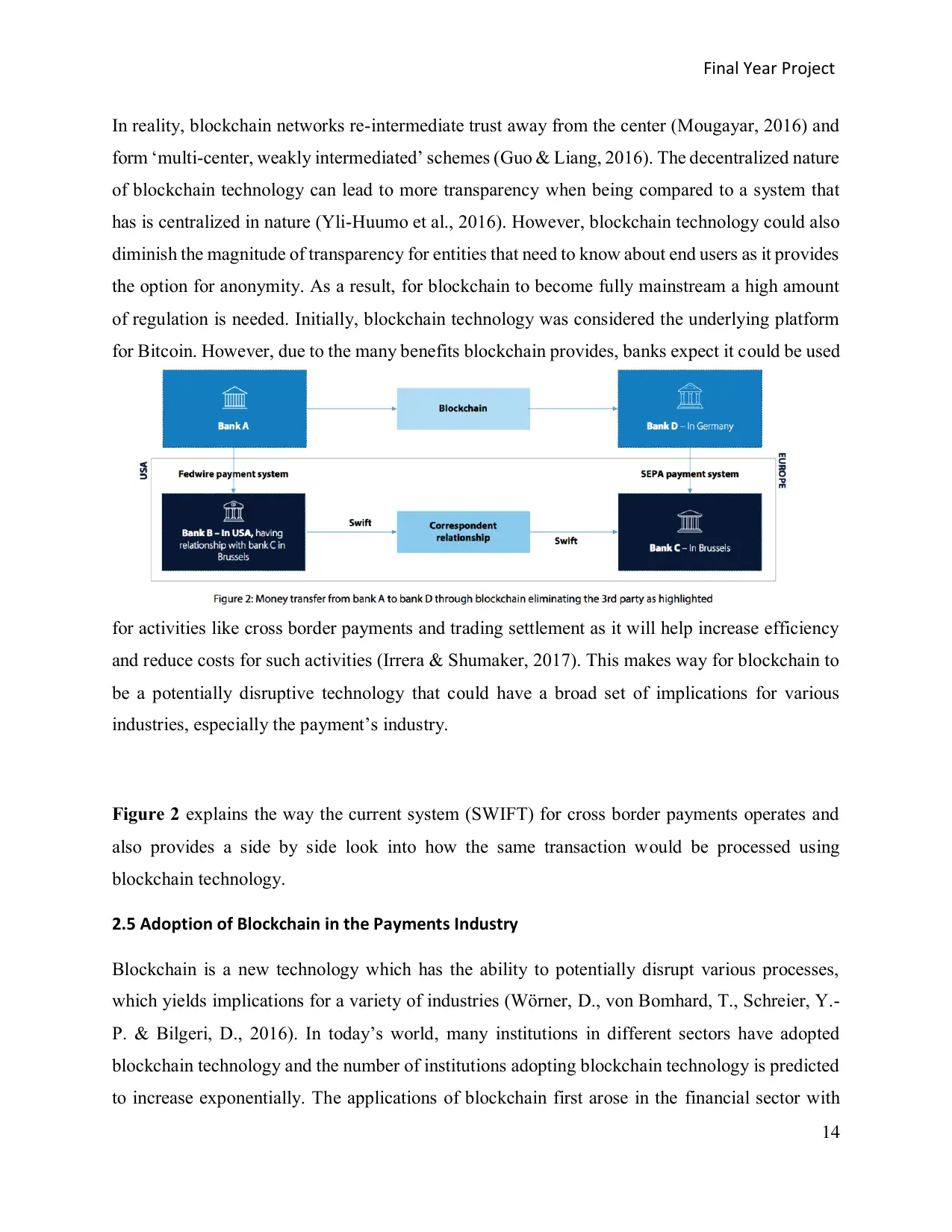
Final Year Project
14
In reality, blockchain networks re-intermediate trust away from the center (Mougayar, 2016) and
form ‘multi-center, weakly intermediated’ schemes (Guo & Liang, 2016). The decentralized nature
of blockchain technology can lead to more transparency when being compared to a system that
has is centralized in nature (Yli-Huumo et al., 2016). However, blockchain technology could also
diminish the magnitude of transparency for entities that need to know about end users as it provides
the option for anonymity. As a result, for blockchain to become fully mainstream a high amount
of regulation is needed. Initially, blockchain technology was considered the underlying platform
for Bitcoin. However, due to the many benefits blockchain provides, banks expect it could be used
for activities like cross border payments and trading settlement as it will help increase efficiency
and reduce costs for such activities (Irrera & Shumaker, 2017). This makes way for blockchain to
be a potentially disruptive technology that could have a broad set of implications for various
industries, especially the payment’s industry.
Figure 2 explains the way the current system (SWIFT) for cross border payments operates and
also provides a side by side look into how the same transaction would be processed using
blockchain technology.
2.5 Adoption of Blockchain in the Payments Industry
Blockchain is a new technology which has the ability to potentially disrupt various processes,
which yields implications for a variety of industries (Wörner, D., von Bomhard, T., Schreier, Y.-
P. & Bilgeri, D., 2016). In today’s world, many institutions in different sectors have adopted
blockchain technology and the number of institutions adopting blockchain technology is predicted
to increase exponentially. The applications of blockchain first arose in the financial sector with
14
In reality, blockchain networks re-intermediate trust away from the center (Mougayar, 2016) and
form ‘multi-center, weakly intermediated’ schemes (Guo & Liang, 2016). The decentralized nature
of blockchain technology can lead to more transparency when being compared to a system that
has is centralized in nature (Yli-Huumo et al., 2016). However, blockchain technology could also
diminish the magnitude of transparency for entities that need to know about end users as it provides
the option for anonymity. As a result, for blockchain to become fully mainstream a high amount
of regulation is needed. Initially, blockchain technology was considered the underlying platform
for Bitcoin. However, due to the many benefits blockchain provides, banks expect it could be used
for activities like cross border payments and trading settlement as it will help increase efficiency
and reduce costs for such activities (Irrera & Shumaker, 2017). This makes way for blockchain to
be a potentially disruptive technology that could have a broad set of implications for various
industries, especially the payment’s industry.
Figure 2 explains the way the current system (SWIFT) for cross border payments operates and
also provides a side by side look into how the same transaction would be processed using
blockchain technology.
2.5 Adoption of Blockchain in the Payments Industry
Blockchain is a new technology which has the ability to potentially disrupt various processes,
which yields implications for a variety of industries (Wörner, D., von Bomhard, T., Schreier, Y.-
P. & Bilgeri, D., 2016). In today’s world, many institutions in different sectors have adopted
blockchain technology and the number of institutions adopting blockchain technology is predicted
to increase exponentially. The applications of blockchain first arose in the financial sector with
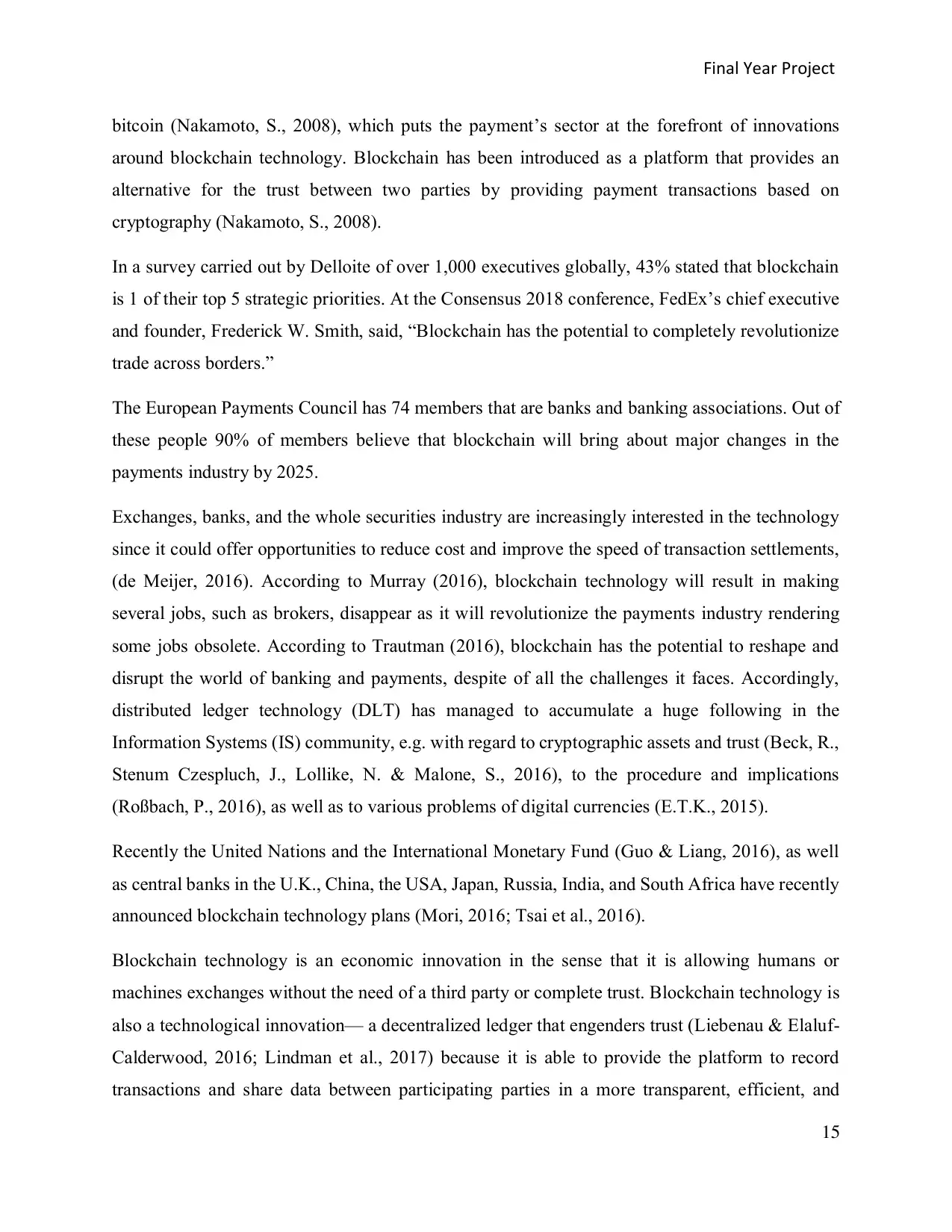
Final Year Project
15
bitcoin (Nakamoto, S., 2008), which puts the payment’s sector at the forefront of innovations
around blockchain technology. Blockchain has been introduced as a platform that provides an
alternative for the trust between two parties by providing payment transactions based on
cryptography (Nakamoto, S., 2008).
In a survey carried out by Delloite of over 1,000 executives globally, 43% stated that blockchain
is 1 of their top 5 strategic priorities. At the Consensus 2018 conference, FedEx’s chief executive
and founder, Frederick W. Smith, said, “Blockchain has the potential to completely revolutionize
trade across borders.”
The European Payments Council has 74 members that are banks and banking associations. Out of
these people 90% of members believe that blockchain will bring about major changes in the
payments industry by 2025.
Exchanges, banks, and the whole securities industry are increasingly interested in the technology
since it could offer opportunities to reduce cost and improve the speed of transaction settlements,
(de Meijer, 2016). According to Murray (2016), blockchain technology will result in making
several jobs, such as brokers, disappear as it will revolutionize the payments industry rendering
some jobs obsolete. According to Trautman (2016), blockchain has the potential to reshape and
disrupt the world of banking and payments, despite of all the challenges it faces. Accordingly,
distributed ledger technology (DLT) has managed to accumulate a huge following in the
Information Systems (IS) community, e.g. with regard to cryptographic assets and trust (Beck, R.,
Stenum Czespluch, J., Lollike, N. & Malone, S., 2016), to the procedure and implications
(Roßbach, P., 2016), as well as to various problems of digital currencies (E.T.K., 2015).
Recently the United Nations and the International Monetary Fund (Guo & Liang, 2016), as well
as central banks in the U.K., China, the USA, Japan, Russia, India, and South Africa have recently
announced blockchain technology plans (Mori, 2016; Tsai et al., 2016).
Blockchain technology is an economic innovation in the sense that it is allowing humans or
machines exchanges without the need of a third party or complete trust. Blockchain technology is
also a technological innovation— a decentralized ledger that engenders trust (Liebenau & Elaluf-
Calderwood, 2016; Lindman et al., 2017) because it is able to provide the platform to record
transactions and share data between participating parties in a more transparent, efficient, and
15
bitcoin (Nakamoto, S., 2008), which puts the payment’s sector at the forefront of innovations
around blockchain technology. Blockchain has been introduced as a platform that provides an
alternative for the trust between two parties by providing payment transactions based on
cryptography (Nakamoto, S., 2008).
In a survey carried out by Delloite of over 1,000 executives globally, 43% stated that blockchain
is 1 of their top 5 strategic priorities. At the Consensus 2018 conference, FedEx’s chief executive
and founder, Frederick W. Smith, said, “Blockchain has the potential to completely revolutionize
trade across borders.”
The European Payments Council has 74 members that are banks and banking associations. Out of
these people 90% of members believe that blockchain will bring about major changes in the
payments industry by 2025.
Exchanges, banks, and the whole securities industry are increasingly interested in the technology
since it could offer opportunities to reduce cost and improve the speed of transaction settlements,
(de Meijer, 2016). According to Murray (2016), blockchain technology will result in making
several jobs, such as brokers, disappear as it will revolutionize the payments industry rendering
some jobs obsolete. According to Trautman (2016), blockchain has the potential to reshape and
disrupt the world of banking and payments, despite of all the challenges it faces. Accordingly,
distributed ledger technology (DLT) has managed to accumulate a huge following in the
Information Systems (IS) community, e.g. with regard to cryptographic assets and trust (Beck, R.,
Stenum Czespluch, J., Lollike, N. & Malone, S., 2016), to the procedure and implications
(Roßbach, P., 2016), as well as to various problems of digital currencies (E.T.K., 2015).
Recently the United Nations and the International Monetary Fund (Guo & Liang, 2016), as well
as central banks in the U.K., China, the USA, Japan, Russia, India, and South Africa have recently
announced blockchain technology plans (Mori, 2016; Tsai et al., 2016).
Blockchain technology is an economic innovation in the sense that it is allowing humans or
machines exchanges without the need of a third party or complete trust. Blockchain technology is
also a technological innovation— a decentralized ledger that engenders trust (Liebenau & Elaluf-
Calderwood, 2016; Lindman et al., 2017) because it is able to provide the platform to record
transactions and share data between participating parties in a more transparent, efficient, and
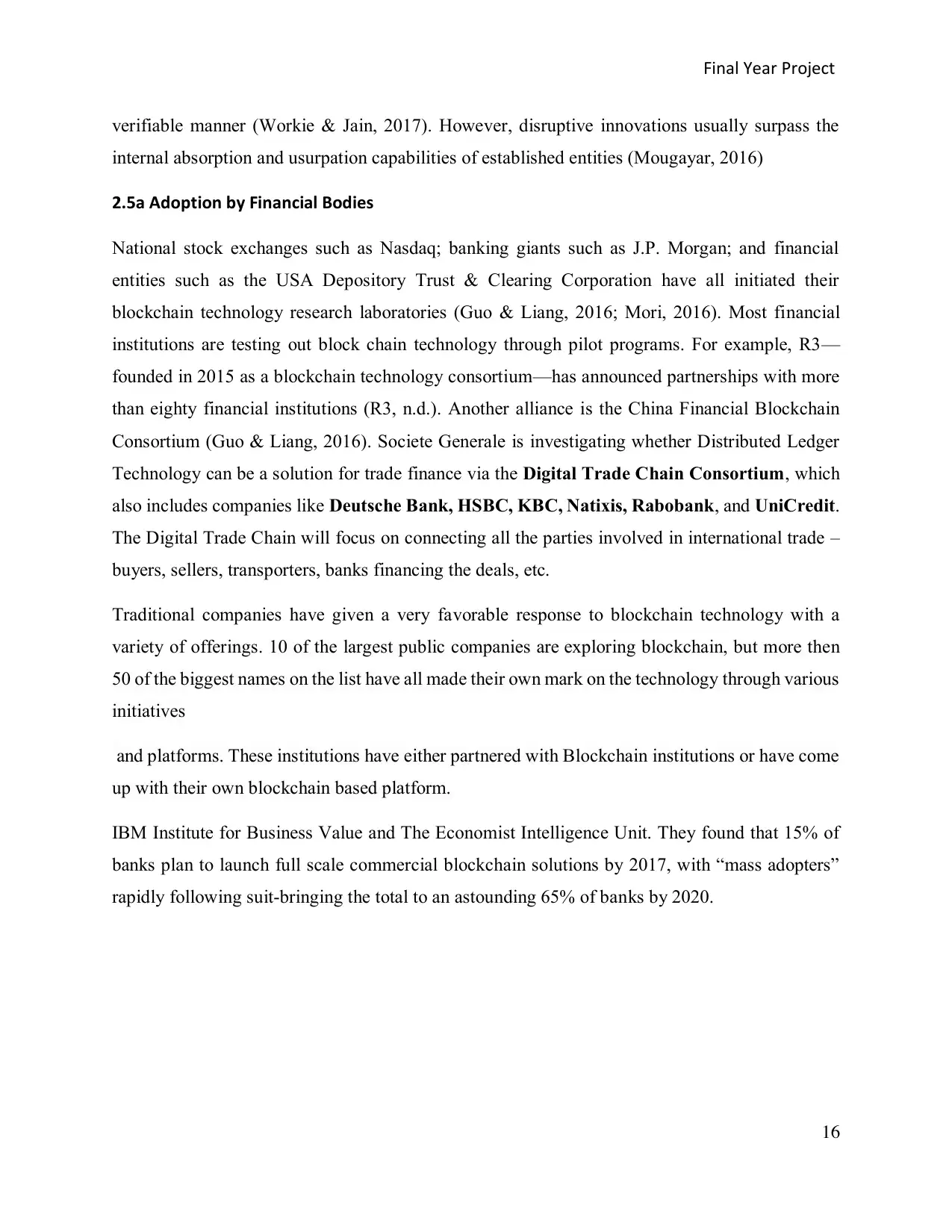
Final Year Project
16
verifiable manner (Workie & Jain, 2017). However, disruptive innovations usually surpass the
internal absorption and usurpation capabilities of established entities (Mougayar, 2016)
2.5a Adoption by Financial Bodies
National stock exchanges such as Nasdaq; banking giants such as J.P. Morgan; and financial
entities such as the USA Depository Trust & Clearing Corporation have all initiated their
blockchain technology research laboratories (Guo & Liang, 2016; Mori, 2016). Most financial
institutions are testing out block chain technology through pilot programs. For example, R3—
founded in 2015 as a blockchain technology consortium—has announced partnerships with more
than eighty financial institutions (R3, n.d.). Another alliance is the China Financial Blockchain
Consortium (Guo & Liang, 2016). Societe Generale is investigating whether Distributed Ledger
Technology can be a solution for trade finance via the Digital Trade Chain Consortium, which
also includes companies like Deutsche Bank, HSBC, KBC, Natixis, Rabobank, and UniCredit.
The Digital Trade Chain will focus on connecting all the parties involved in international trade –
buyers, sellers, transporters, banks financing the deals, etc.
Traditional companies have given a very favorable response to blockchain technology with a
variety of offerings. 10 of the largest public companies are exploring blockchain, but more then
50 of the biggest names on the list have all made their own mark on the technology through various
initiatives
and platforms. These institutions have either partnered with Blockchain institutions or have come
up with their own blockchain based platform.
IBM Institute for Business Value and The Economist Intelligence Unit. They found that 15% of
banks plan to launch full scale commercial blockchain solutions by 2017, with “mass adopters”
rapidly following suit-bringing the total to an astounding 65% of banks by 2020.
16
verifiable manner (Workie & Jain, 2017). However, disruptive innovations usually surpass the
internal absorption and usurpation capabilities of established entities (Mougayar, 2016)
2.5a Adoption by Financial Bodies
National stock exchanges such as Nasdaq; banking giants such as J.P. Morgan; and financial
entities such as the USA Depository Trust & Clearing Corporation have all initiated their
blockchain technology research laboratories (Guo & Liang, 2016; Mori, 2016). Most financial
institutions are testing out block chain technology through pilot programs. For example, R3—
founded in 2015 as a blockchain technology consortium—has announced partnerships with more
than eighty financial institutions (R3, n.d.). Another alliance is the China Financial Blockchain
Consortium (Guo & Liang, 2016). Societe Generale is investigating whether Distributed Ledger
Technology can be a solution for trade finance via the Digital Trade Chain Consortium, which
also includes companies like Deutsche Bank, HSBC, KBC, Natixis, Rabobank, and UniCredit.
The Digital Trade Chain will focus on connecting all the parties involved in international trade –
buyers, sellers, transporters, banks financing the deals, etc.
Traditional companies have given a very favorable response to blockchain technology with a
variety of offerings. 10 of the largest public companies are exploring blockchain, but more then
50 of the biggest names on the list have all made their own mark on the technology through various
initiatives
and platforms. These institutions have either partnered with Blockchain institutions or have come
up with their own blockchain based platform.
IBM Institute for Business Value and The Economist Intelligence Unit. They found that 15% of
banks plan to launch full scale commercial blockchain solutions by 2017, with “mass adopters”
rapidly following suit-bringing the total to an astounding 65% of banks by 2020.
Secure Best Marks with AI Grader
Need help grading? Try our AI Grader for instant feedback on your assignments.

Final Year Project
17
2.5b Adoption in UK
The huge investments of Banco Santander in Ripple (Novoa, 2015), BBVA Coin base (Rizzo,
2015) makes it clear that banks are becoming increasingly inclined towards exploring and adopting
blockchain technology. Santander predicts that by using blockchain technology, banks could
reduce their cost by as much as 12.8 Billion pounds a year. A number of Professors from Oxford
are nearing towards creating the world’s first “Blockchain University”. Research suggests that in
2017-18 alone more than 500 Million Pounds in investments were made in Blockchain Companies
in the UK.
The UK Government has also implemented a plan to invest 10 Million pounds in Blockchain
research. Furthermore, the new payment’s system of the UKs Central Bank, the Bank of England,
is blockchain friendly ie compatible with Blockchain tech forms.
2.5c Adoption in China
Even China has given a favorable response to Blockchain and its capabilities. China is the world
leader in relation to the number of Blockchain patents. Chinas central bank, The Peoples Bank of
China (PboC), is spearheading the development of a trade finance platform powered by
blockchain. This will help to streamline interbank payments. Recently The Bank of China has
revealed plans to aggressively invest in the development in the Blockchain space. The city of
Nanjing has started a $1.5 billion fund to promote Blockchain projects. The China Construction
Bank has introduced its own blockchain based platform and has already processed $2.5 billion in
transactions.
2.5d Adoption in America
MasterCard, a network that serves as the “rails” that many worldwide transactions run on, have
expressed their interest by filing patents in the blockchain space that would create blockchain—
powered B2B transactions, consist of extra layers of security to fight fraud when high—value
transactions are implemented, and facilitate real-time settlement.
There have been central instances where wall street has praised block chain technology. American
Express is using blockchain technology to make its popular rewards and loyalty programs efficient
and secure.
17
2.5b Adoption in UK
The huge investments of Banco Santander in Ripple (Novoa, 2015), BBVA Coin base (Rizzo,
2015) makes it clear that banks are becoming increasingly inclined towards exploring and adopting
blockchain technology. Santander predicts that by using blockchain technology, banks could
reduce their cost by as much as 12.8 Billion pounds a year. A number of Professors from Oxford
are nearing towards creating the world’s first “Blockchain University”. Research suggests that in
2017-18 alone more than 500 Million Pounds in investments were made in Blockchain Companies
in the UK.
The UK Government has also implemented a plan to invest 10 Million pounds in Blockchain
research. Furthermore, the new payment’s system of the UKs Central Bank, the Bank of England,
is blockchain friendly ie compatible with Blockchain tech forms.
2.5c Adoption in China
Even China has given a favorable response to Blockchain and its capabilities. China is the world
leader in relation to the number of Blockchain patents. Chinas central bank, The Peoples Bank of
China (PboC), is spearheading the development of a trade finance platform powered by
blockchain. This will help to streamline interbank payments. Recently The Bank of China has
revealed plans to aggressively invest in the development in the Blockchain space. The city of
Nanjing has started a $1.5 billion fund to promote Blockchain projects. The China Construction
Bank has introduced its own blockchain based platform and has already processed $2.5 billion in
transactions.
2.5d Adoption in America
MasterCard, a network that serves as the “rails” that many worldwide transactions run on, have
expressed their interest by filing patents in the blockchain space that would create blockchain—
powered B2B transactions, consist of extra layers of security to fight fraud when high—value
transactions are implemented, and facilitate real-time settlement.
There have been central instances where wall street has praised block chain technology. American
Express is using blockchain technology to make its popular rewards and loyalty programs efficient
and secure.
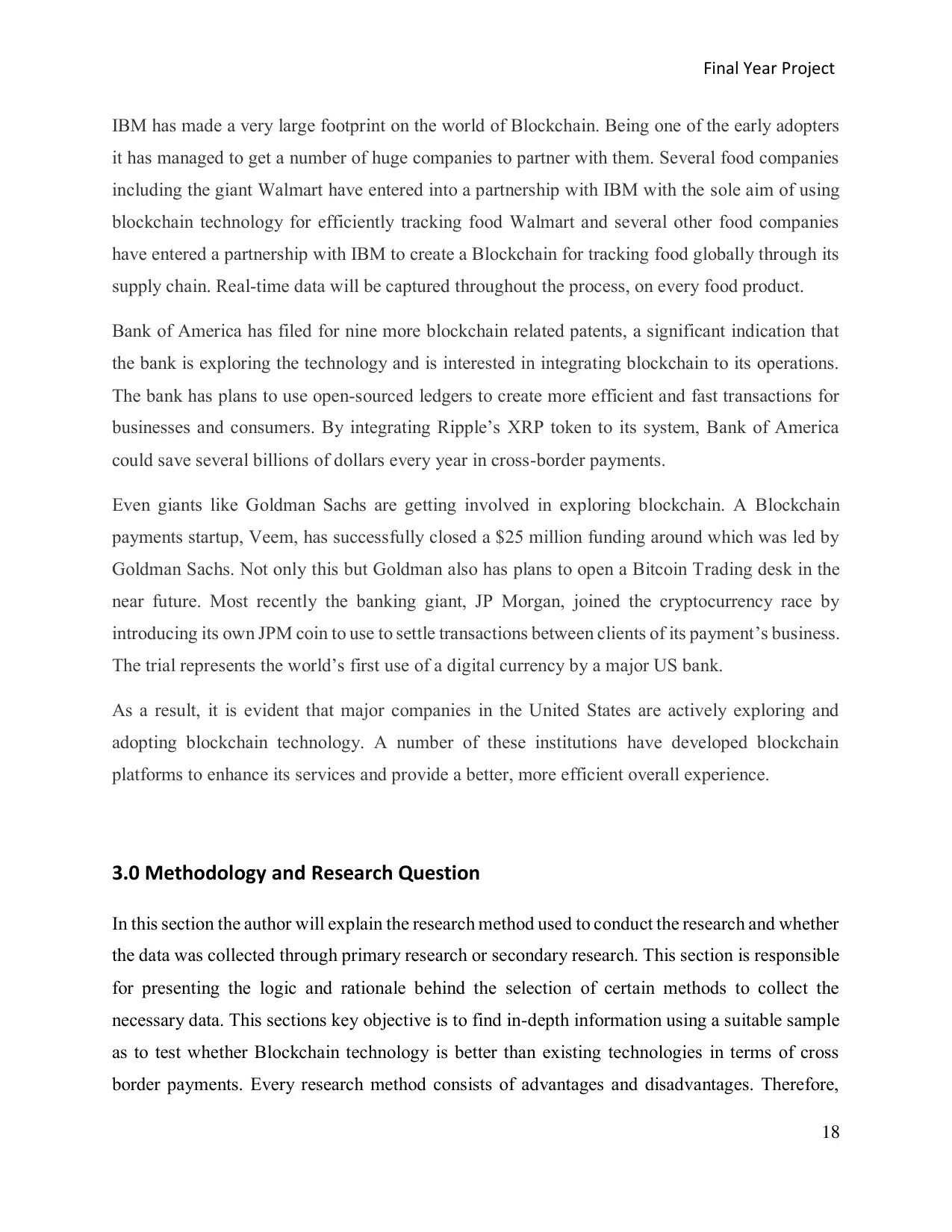
Final Year Project
18
IBM has made a very large footprint on the world of Blockchain. Being one of the early adopters
it has managed to get a number of huge companies to partner with them. Several food companies
including the giant Walmart have entered into a partnership with IBM with the sole aim of using
blockchain technology for efficiently tracking food Walmart and several other food companies
have entered a partnership with IBM to create a Blockchain for tracking food globally through its
supply chain. Real-time data will be captured throughout the process, on every food product.
Bank of America has filed for nine more blockchain related patents, a significant indication that
the bank is exploring the technology and is interested in integrating blockchain to its operations.
The bank has plans to use open-sourced ledgers to create more efficient and fast transactions for
businesses and consumers. By integrating Ripple’s XRP token to its system, Bank of America
could save several billions of dollars every year in cross-border payments.
Even giants like Goldman Sachs are getting involved in exploring blockchain. A Blockchain
payments startup, Veem, has successfully closed a $25 million funding around which was led by
Goldman Sachs. Not only this but Goldman also has plans to open a Bitcoin Trading desk in the
near future. Most recently the banking giant, JP Morgan, joined the cryptocurrency race by
introducing its own JPM coin to use to settle transactions between clients of its payment’s business.
The trial represents the world’s first use of a digital currency by a major US bank.
As a result, it is evident that major companies in the United States are actively exploring and
adopting blockchain technology. A number of these institutions have developed blockchain
platforms to enhance its services and provide a better, more efficient overall experience.
3.0 Methodology and Research Question
In this section the author will explain the research method used to conduct the research and whether
the data was collected through primary research or secondary research. This section is responsible
for presenting the logic and rationale behind the selection of certain methods to collect the
necessary data. This sections key objective is to find in-depth information using a suitable sample
as to test whether Blockchain technology is better than existing technologies in terms of cross
border payments. Every research method consists of advantages and disadvantages. Therefore,
18
IBM has made a very large footprint on the world of Blockchain. Being one of the early adopters
it has managed to get a number of huge companies to partner with them. Several food companies
including the giant Walmart have entered into a partnership with IBM with the sole aim of using
blockchain technology for efficiently tracking food Walmart and several other food companies
have entered a partnership with IBM to create a Blockchain for tracking food globally through its
supply chain. Real-time data will be captured throughout the process, on every food product.
Bank of America has filed for nine more blockchain related patents, a significant indication that
the bank is exploring the technology and is interested in integrating blockchain to its operations.
The bank has plans to use open-sourced ledgers to create more efficient and fast transactions for
businesses and consumers. By integrating Ripple’s XRP token to its system, Bank of America
could save several billions of dollars every year in cross-border payments.
Even giants like Goldman Sachs are getting involved in exploring blockchain. A Blockchain
payments startup, Veem, has successfully closed a $25 million funding around which was led by
Goldman Sachs. Not only this but Goldman also has plans to open a Bitcoin Trading desk in the
near future. Most recently the banking giant, JP Morgan, joined the cryptocurrency race by
introducing its own JPM coin to use to settle transactions between clients of its payment’s business.
The trial represents the world’s first use of a digital currency by a major US bank.
As a result, it is evident that major companies in the United States are actively exploring and
adopting blockchain technology. A number of these institutions have developed blockchain
platforms to enhance its services and provide a better, more efficient overall experience.
3.0 Methodology and Research Question
In this section the author will explain the research method used to conduct the research and whether
the data was collected through primary research or secondary research. This section is responsible
for presenting the logic and rationale behind the selection of certain methods to collect the
necessary data. This sections key objective is to find in-depth information using a suitable sample
as to test whether Blockchain technology is better than existing technologies in terms of cross
border payments. Every research method consists of advantages and disadvantages. Therefore,
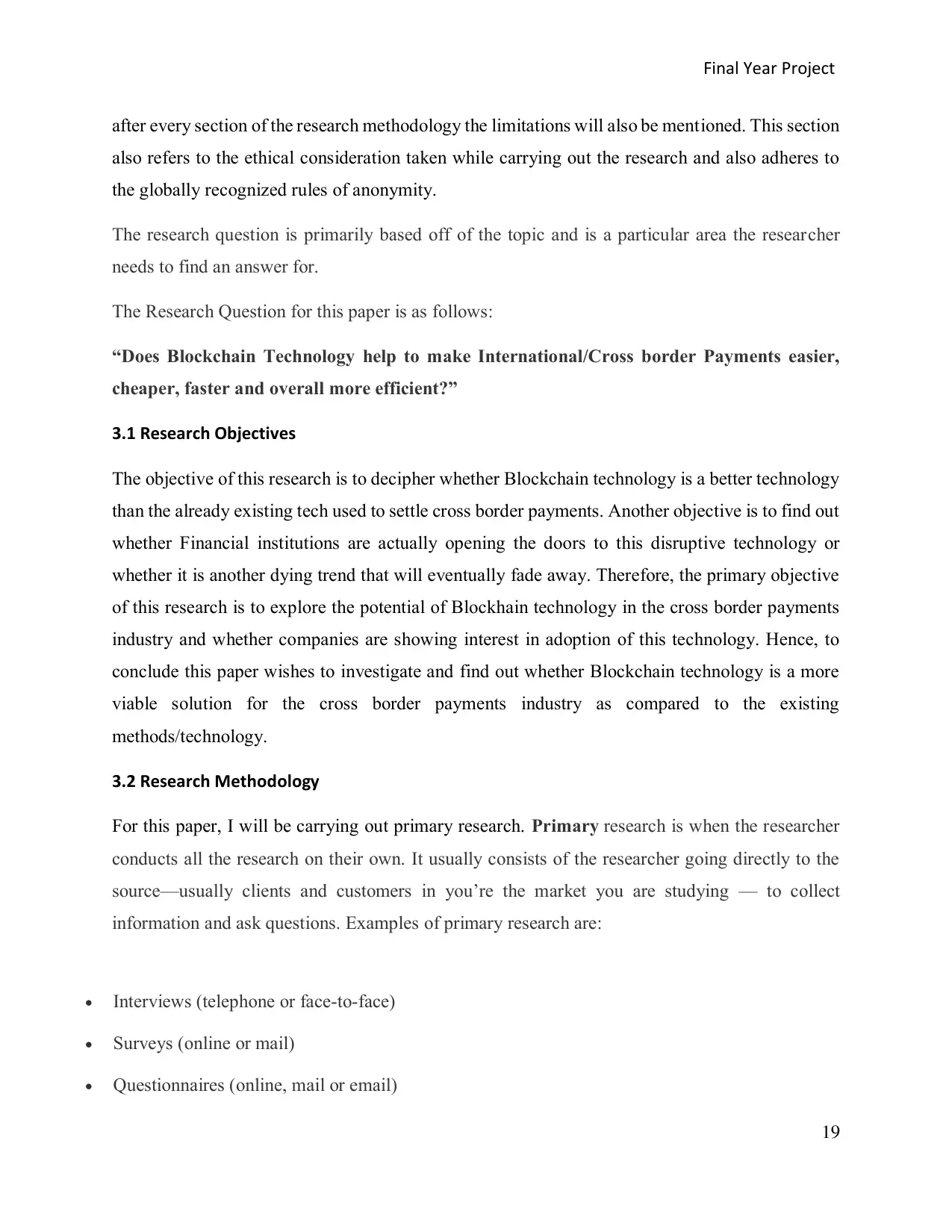
Final Year Project
19
after every section of the research methodology the limitations will also be mentioned. This section
also refers to the ethical consideration taken while carrying out the research and also adheres to
the globally recognized rules of anonymity.
The research question is primarily based off of the topic and is a particular area the researcher
needs to find an answer for.
The Research Question for this paper is as follows:
“Does Blockchain Technology help to make International/Cross border Payments easier,
cheaper, faster and overall more efficient?”
3.1 Research Objectives
The objective of this research is to decipher whether Blockchain technology is a better technology
than the already existing tech used to settle cross border payments. Another objective is to find out
whether Financial institutions are actually opening the doors to this disruptive technology or
whether it is another dying trend that will eventually fade away. Therefore, the primary objective
of this research is to explore the potential of Blockhain technology in the cross border payments
industry and whether companies are showing interest in adoption of this technology. Hence, to
conclude this paper wishes to investigate and find out whether Blockchain technology is a more
viable solution for the cross border payments industry as compared to the existing
methods/technology.
3.2 Research Methodology
For this paper, I will be carrying out primary research. Primary research is when the researcher
conducts all the research on their own. It usually consists of the researcher going directly to the
source—usually clients and customers in you’re the market you are studying — to collect
information and ask questions. Examples of primary research are:
• Interviews (telephone or face-to-face)
• Surveys (online or mail)
• Questionnaires (online, mail or email)
19
after every section of the research methodology the limitations will also be mentioned. This section
also refers to the ethical consideration taken while carrying out the research and also adheres to
the globally recognized rules of anonymity.
The research question is primarily based off of the topic and is a particular area the researcher
needs to find an answer for.
The Research Question for this paper is as follows:
“Does Blockchain Technology help to make International/Cross border Payments easier,
cheaper, faster and overall more efficient?”
3.1 Research Objectives
The objective of this research is to decipher whether Blockchain technology is a better technology
than the already existing tech used to settle cross border payments. Another objective is to find out
whether Financial institutions are actually opening the doors to this disruptive technology or
whether it is another dying trend that will eventually fade away. Therefore, the primary objective
of this research is to explore the potential of Blockhain technology in the cross border payments
industry and whether companies are showing interest in adoption of this technology. Hence, to
conclude this paper wishes to investigate and find out whether Blockchain technology is a more
viable solution for the cross border payments industry as compared to the existing
methods/technology.
3.2 Research Methodology
For this paper, I will be carrying out primary research. Primary research is when the researcher
conducts all the research on their own. It usually consists of the researcher going directly to the
source—usually clients and customers in you’re the market you are studying — to collect
information and ask questions. Examples of primary research are:
• Interviews (telephone or face-to-face)
• Surveys (online or mail)
• Questionnaires (online, mail or email)
Paraphrase This Document
Need a fresh take? Get an instant paraphrase of this document with our AI Paraphraser
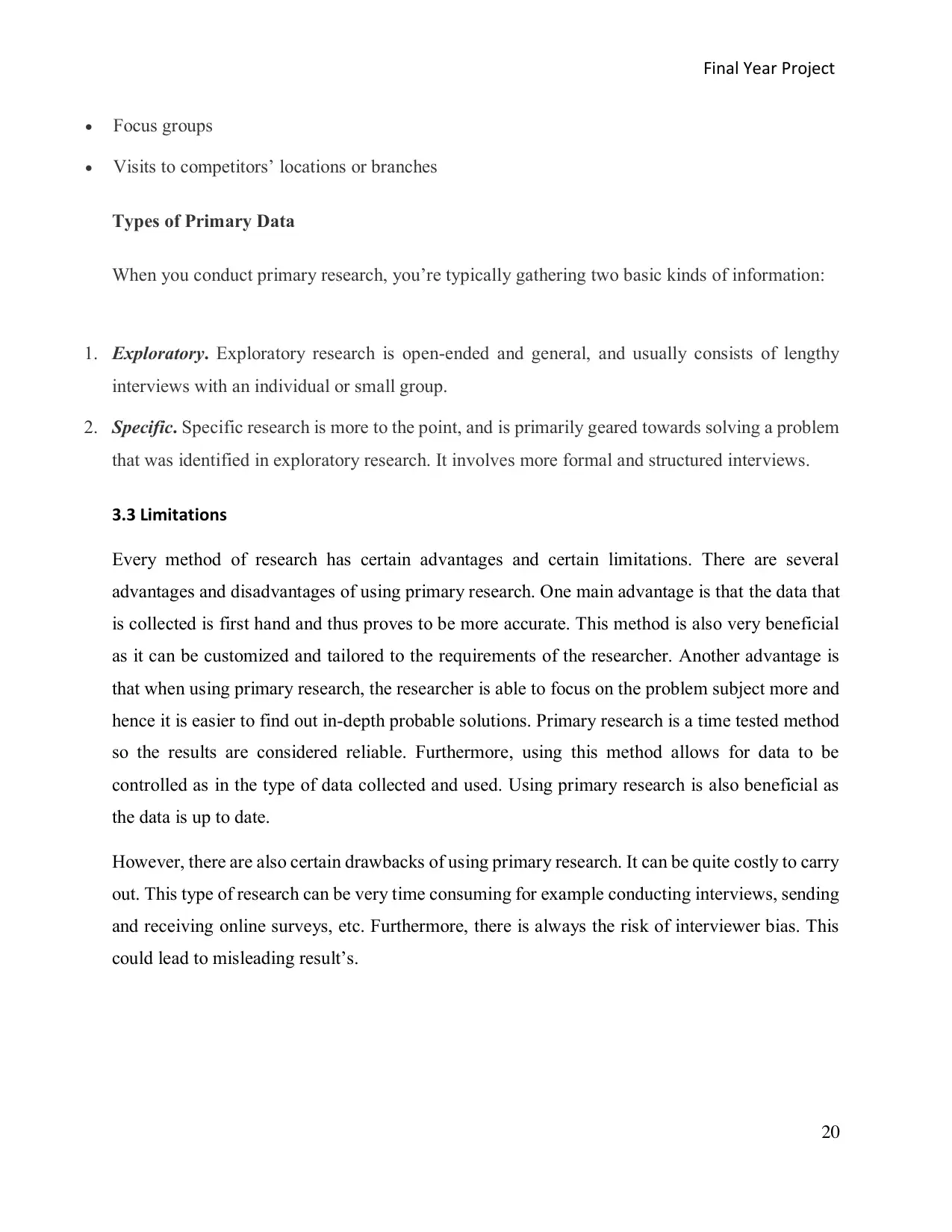
Final Year Project
20
• Focus groups
• Visits to competitors’ locations or branches
Types of Primary Data
When you conduct primary research, you’re typically gathering two basic kinds of information:
1. Exploratory. Exploratory research is open-ended and general, and usually consists of lengthy
interviews with an individual or small group.
2. Specific. Specific research is more to the point, and is primarily geared towards solving a problem
that was identified in exploratory research. It involves more formal and structured interviews.
3.3 Limitations
Every method of research has certain advantages and certain limitations. There are several
advantages and disadvantages of using primary research. One main advantage is that the data that
is collected is first hand and thus proves to be more accurate. This method is also very beneficial
as it can be customized and tailored to the requirements of the researcher. Another advantage is
that when using primary research, the researcher is able to focus on the problem subject more and
hence it is easier to find out in-depth probable solutions. Primary research is a time tested method
so the results are considered reliable. Furthermore, using this method allows for data to be
controlled as in the type of data collected and used. Using primary research is also beneficial as
the data is up to date.
However, there are also certain drawbacks of using primary research. It can be quite costly to carry
out. This type of research can be very time consuming for example conducting interviews, sending
and receiving online surveys, etc. Furthermore, there is always the risk of interviewer bias. This
could lead to misleading result’s.
20
• Focus groups
• Visits to competitors’ locations or branches
Types of Primary Data
When you conduct primary research, you’re typically gathering two basic kinds of information:
1. Exploratory. Exploratory research is open-ended and general, and usually consists of lengthy
interviews with an individual or small group.
2. Specific. Specific research is more to the point, and is primarily geared towards solving a problem
that was identified in exploratory research. It involves more formal and structured interviews.
3.3 Limitations
Every method of research has certain advantages and certain limitations. There are several
advantages and disadvantages of using primary research. One main advantage is that the data that
is collected is first hand and thus proves to be more accurate. This method is also very beneficial
as it can be customized and tailored to the requirements of the researcher. Another advantage is
that when using primary research, the researcher is able to focus on the problem subject more and
hence it is easier to find out in-depth probable solutions. Primary research is a time tested method
so the results are considered reliable. Furthermore, using this method allows for data to be
controlled as in the type of data collected and used. Using primary research is also beneficial as
the data is up to date.
However, there are also certain drawbacks of using primary research. It can be quite costly to carry
out. This type of research can be very time consuming for example conducting interviews, sending
and receiving online surveys, etc. Furthermore, there is always the risk of interviewer bias. This
could lead to misleading result’s.
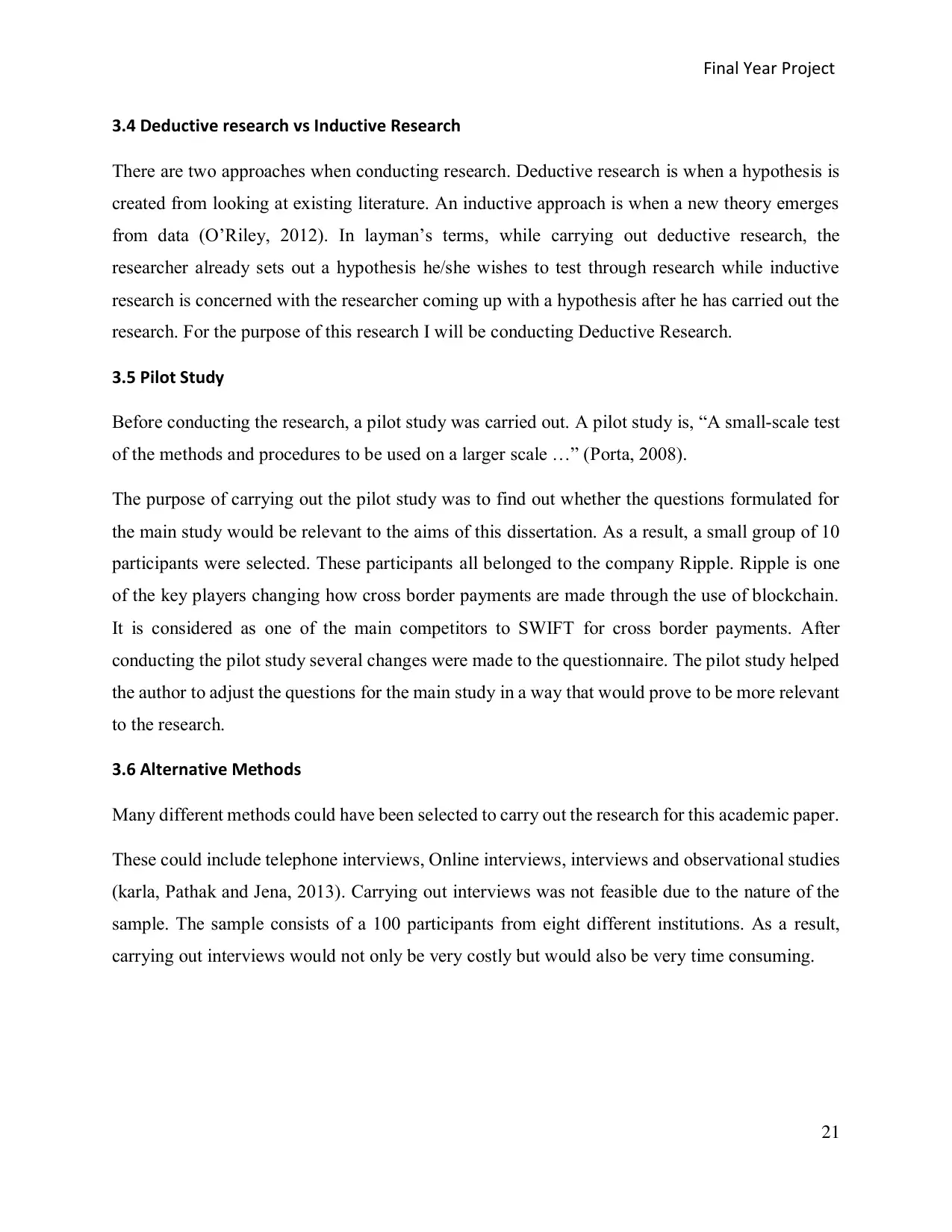
Final Year Project
21
3.4 Deductive research vs Inductive Research
There are two approaches when conducting research. Deductive research is when a hypothesis is
created from looking at existing literature. An inductive approach is when a new theory emerges
from data (O’Riley, 2012). In layman’s terms, while carrying out deductive research, the
researcher already sets out a hypothesis he/she wishes to test through research while inductive
research is concerned with the researcher coming up with a hypothesis after he has carried out the
research. For the purpose of this research I will be conducting Deductive Research.
3.5 Pilot Study
Before conducting the research, a pilot study was carried out. A pilot study is, “A small-scale test
of the methods and procedures to be used on a larger scale …” (Porta, 2008).
The purpose of carrying out the pilot study was to find out whether the questions formulated for
the main study would be relevant to the aims of this dissertation. As a result, a small group of 10
participants were selected. These participants all belonged to the company Ripple. Ripple is one
of the key players changing how cross border payments are made through the use of blockchain.
It is considered as one of the main competitors to SWIFT for cross border payments. After
conducting the pilot study several changes were made to the questionnaire. The pilot study helped
the author to adjust the questions for the main study in a way that would prove to be more relevant
to the research.
3.6 Alternative Methods
Many different methods could have been selected to carry out the research for this academic paper.
These could include telephone interviews, Online interviews, interviews and observational studies
(karla, Pathak and Jena, 2013). Carrying out interviews was not feasible due to the nature of the
sample. The sample consists of a 100 participants from eight different institutions. As a result,
carrying out interviews would not only be very costly but would also be very time consuming.
21
3.4 Deductive research vs Inductive Research
There are two approaches when conducting research. Deductive research is when a hypothesis is
created from looking at existing literature. An inductive approach is when a new theory emerges
from data (O’Riley, 2012). In layman’s terms, while carrying out deductive research, the
researcher already sets out a hypothesis he/she wishes to test through research while inductive
research is concerned with the researcher coming up with a hypothesis after he has carried out the
research. For the purpose of this research I will be conducting Deductive Research.
3.5 Pilot Study
Before conducting the research, a pilot study was carried out. A pilot study is, “A small-scale test
of the methods and procedures to be used on a larger scale …” (Porta, 2008).
The purpose of carrying out the pilot study was to find out whether the questions formulated for
the main study would be relevant to the aims of this dissertation. As a result, a small group of 10
participants were selected. These participants all belonged to the company Ripple. Ripple is one
of the key players changing how cross border payments are made through the use of blockchain.
It is considered as one of the main competitors to SWIFT for cross border payments. After
conducting the pilot study several changes were made to the questionnaire. The pilot study helped
the author to adjust the questions for the main study in a way that would prove to be more relevant
to the research.
3.6 Alternative Methods
Many different methods could have been selected to carry out the research for this academic paper.
These could include telephone interviews, Online interviews, interviews and observational studies
(karla, Pathak and Jena, 2013). Carrying out interviews was not feasible due to the nature of the
sample. The sample consists of a 100 participants from eight different institutions. As a result,
carrying out interviews would not only be very costly but would also be very time consuming.
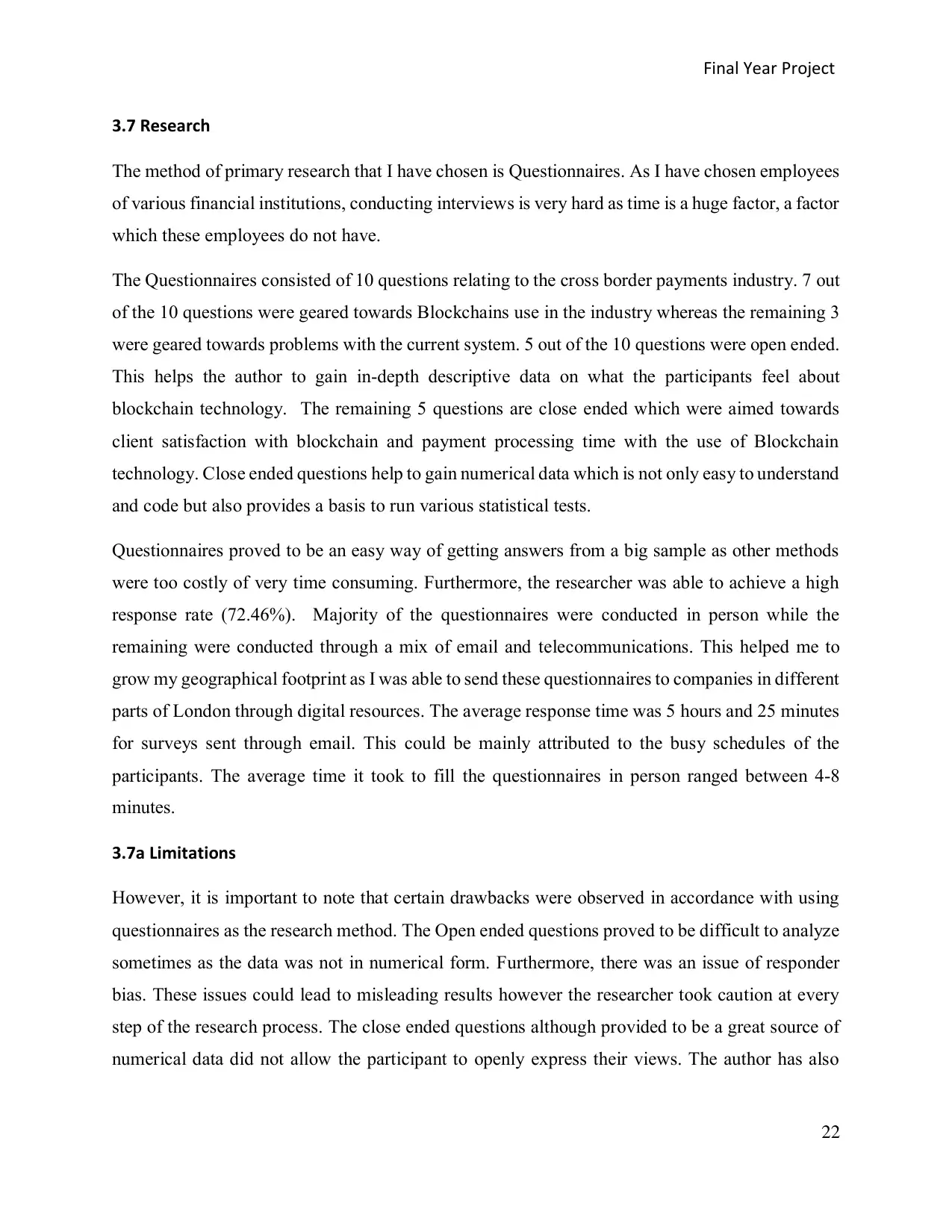
Final Year Project
22
3.7 Research
The method of primary research that I have chosen is Questionnaires. As I have chosen employees
of various financial institutions, conducting interviews is very hard as time is a huge factor, a factor
which these employees do not have.
The Questionnaires consisted of 10 questions relating to the cross border payments industry. 7 out
of the 10 questions were geared towards Blockchains use in the industry whereas the remaining 3
were geared towards problems with the current system. 5 out of the 10 questions were open ended.
This helps the author to gain in-depth descriptive data on what the participants feel about
blockchain technology. The remaining 5 questions are close ended which were aimed towards
client satisfaction with blockchain and payment processing time with the use of Blockchain
technology. Close ended questions help to gain numerical data which is not only easy to understand
and code but also provides a basis to run various statistical tests.
Questionnaires proved to be an easy way of getting answers from a big sample as other methods
were too costly of very time consuming. Furthermore, the researcher was able to achieve a high
response rate (72.46%). Majority of the questionnaires were conducted in person while the
remaining were conducted through a mix of email and telecommunications. This helped me to
grow my geographical footprint as I was able to send these questionnaires to companies in different
parts of London through digital resources. The average response time was 5 hours and 25 minutes
for surveys sent through email. This could be mainly attributed to the busy schedules of the
participants. The average time it took to fill the questionnaires in person ranged between 4-8
minutes.
3.7a Limitations
However, it is important to note that certain drawbacks were observed in accordance with using
questionnaires as the research method. The Open ended questions proved to be difficult to analyze
sometimes as the data was not in numerical form. Furthermore, there was an issue of responder
bias. These issues could lead to misleading results however the researcher took caution at every
step of the research process. The close ended questions although provided to be a great source of
numerical data did not allow the participant to openly express their views. The author has also
22
3.7 Research
The method of primary research that I have chosen is Questionnaires. As I have chosen employees
of various financial institutions, conducting interviews is very hard as time is a huge factor, a factor
which these employees do not have.
The Questionnaires consisted of 10 questions relating to the cross border payments industry. 7 out
of the 10 questions were geared towards Blockchains use in the industry whereas the remaining 3
were geared towards problems with the current system. 5 out of the 10 questions were open ended.
This helps the author to gain in-depth descriptive data on what the participants feel about
blockchain technology. The remaining 5 questions are close ended which were aimed towards
client satisfaction with blockchain and payment processing time with the use of Blockchain
technology. Close ended questions help to gain numerical data which is not only easy to understand
and code but also provides a basis to run various statistical tests.
Questionnaires proved to be an easy way of getting answers from a big sample as other methods
were too costly of very time consuming. Furthermore, the researcher was able to achieve a high
response rate (72.46%). Majority of the questionnaires were conducted in person while the
remaining were conducted through a mix of email and telecommunications. This helped me to
grow my geographical footprint as I was able to send these questionnaires to companies in different
parts of London through digital resources. The average response time was 5 hours and 25 minutes
for surveys sent through email. This could be mainly attributed to the busy schedules of the
participants. The average time it took to fill the questionnaires in person ranged between 4-8
minutes.
3.7a Limitations
However, it is important to note that certain drawbacks were observed in accordance with using
questionnaires as the research method. The Open ended questions proved to be difficult to analyze
sometimes as the data was not in numerical form. Furthermore, there was an issue of responder
bias. These issues could lead to misleading results however the researcher took caution at every
step of the research process. The close ended questions although provided to be a great source of
numerical data did not allow the participant to openly express their views. The author has also
Secure Best Marks with AI Grader
Need help grading? Try our AI Grader for instant feedback on your assignments.
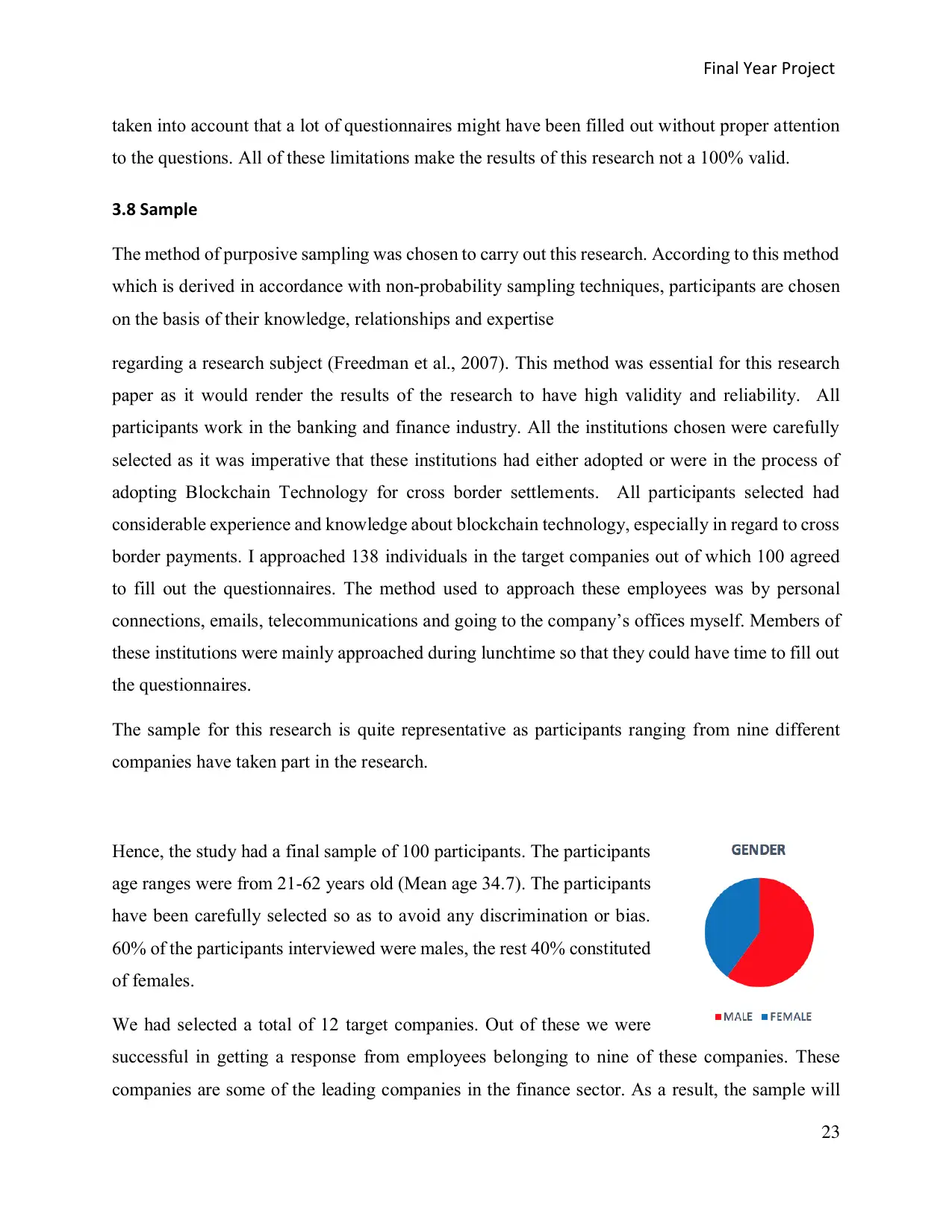
Final Year Project
23
taken into account that a lot of questionnaires might have been filled out without proper attention
to the questions. All of these limitations make the results of this research not a 100% valid.
3.8 Sample
The method of purposive sampling was chosen to carry out this research. According to this method
which is derived in accordance with non-probability sampling techniques, participants are chosen
on the basis of their knowledge, relationships and expertise
regarding a research subject (Freedman et al., 2007). This method was essential for this research
paper as it would render the results of the research to have high validity and reliability. All
participants work in the banking and finance industry. All the institutions chosen were carefully
selected as it was imperative that these institutions had either adopted or were in the process of
adopting Blockchain Technology for cross border settlements. All participants selected had
considerable experience and knowledge about blockchain technology, especially in regard to cross
border payments. I approached 138 individuals in the target companies out of which 100 agreed
to fill out the questionnaires. The method used to approach these employees was by personal
connections, emails, telecommunications and going to the company’s offices myself. Members of
these institutions were mainly approached during lunchtime so that they could have time to fill out
the questionnaires.
The sample for this research is quite representative as participants ranging from nine different
companies have taken part in the research.
Hence, the study had a final sample of 100 participants. The participants
age ranges were from 21-62 years old (Mean age 34.7). The participants
have been carefully selected so as to avoid any discrimination or bias.
60% of the participants interviewed were males, the rest 40% constituted
of females.
We had selected a total of 12 target companies. Out of these we were
successful in getting a response from employees belonging to nine of these companies. These
companies are some of the leading companies in the finance sector. As a result, the sample will
23
taken into account that a lot of questionnaires might have been filled out without proper attention
to the questions. All of these limitations make the results of this research not a 100% valid.
3.8 Sample
The method of purposive sampling was chosen to carry out this research. According to this method
which is derived in accordance with non-probability sampling techniques, participants are chosen
on the basis of their knowledge, relationships and expertise
regarding a research subject (Freedman et al., 2007). This method was essential for this research
paper as it would render the results of the research to have high validity and reliability. All
participants work in the banking and finance industry. All the institutions chosen were carefully
selected as it was imperative that these institutions had either adopted or were in the process of
adopting Blockchain Technology for cross border settlements. All participants selected had
considerable experience and knowledge about blockchain technology, especially in regard to cross
border payments. I approached 138 individuals in the target companies out of which 100 agreed
to fill out the questionnaires. The method used to approach these employees was by personal
connections, emails, telecommunications and going to the company’s offices myself. Members of
these institutions were mainly approached during lunchtime so that they could have time to fill out
the questionnaires.
The sample for this research is quite representative as participants ranging from nine different
companies have taken part in the research.
Hence, the study had a final sample of 100 participants. The participants
age ranges were from 21-62 years old (Mean age 34.7). The participants
have been carefully selected so as to avoid any discrimination or bias.
60% of the participants interviewed were males, the rest 40% constituted
of females.
We had selected a total of 12 target companies. Out of these we were
successful in getting a response from employees belonging to nine of these companies. These
companies are some of the leading companies in the finance sector. As a result, the sample will
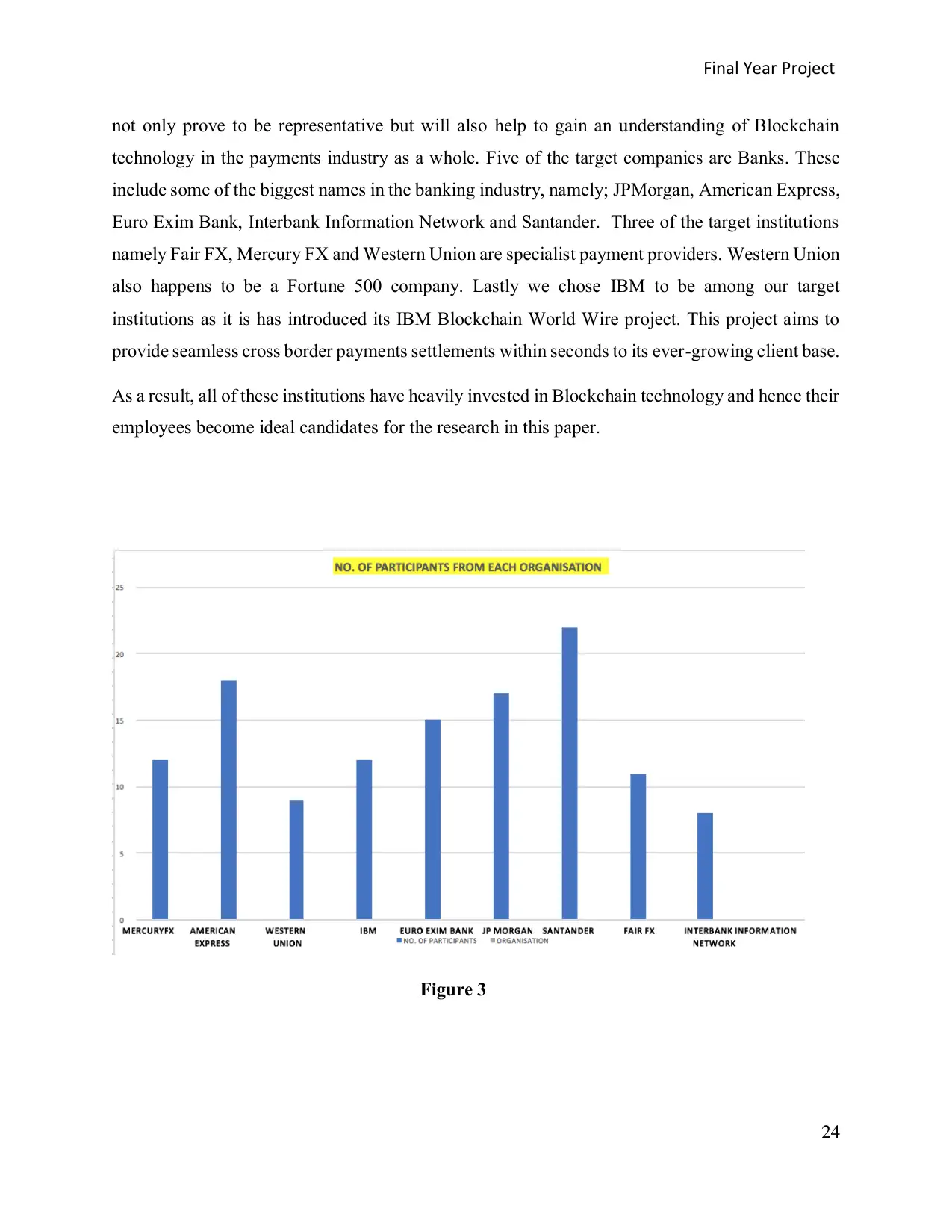
Final Year Project
24
not only prove to be representative but will also help to gain an understanding of Blockchain
technology in the payments industry as a whole. Five of the target companies are Banks. These
include some of the biggest names in the banking industry, namely; JPMorgan, American Express,
Euro Exim Bank, Interbank Information Network and Santander. Three of the target institutions
namely Fair FX, Mercury FX and Western Union are specialist payment providers. Western Union
also happens to be a Fortune 500 company. Lastly we chose IBM to be among our target
institutions as it is has introduced its IBM Blockchain World Wire project. This project aims to
provide seamless cross border payments settlements within seconds to its ever-growing client base.
As a result, all of these institutions have heavily invested in Blockchain technology and hence their
employees become ideal candidates for the research in this paper.
Figure 3
24
not only prove to be representative but will also help to gain an understanding of Blockchain
technology in the payments industry as a whole. Five of the target companies are Banks. These
include some of the biggest names in the banking industry, namely; JPMorgan, American Express,
Euro Exim Bank, Interbank Information Network and Santander. Three of the target institutions
namely Fair FX, Mercury FX and Western Union are specialist payment providers. Western Union
also happens to be a Fortune 500 company. Lastly we chose IBM to be among our target
institutions as it is has introduced its IBM Blockchain World Wire project. This project aims to
provide seamless cross border payments settlements within seconds to its ever-growing client base.
As a result, all of these institutions have heavily invested in Blockchain technology and hence their
employees become ideal candidates for the research in this paper.
Figure 3
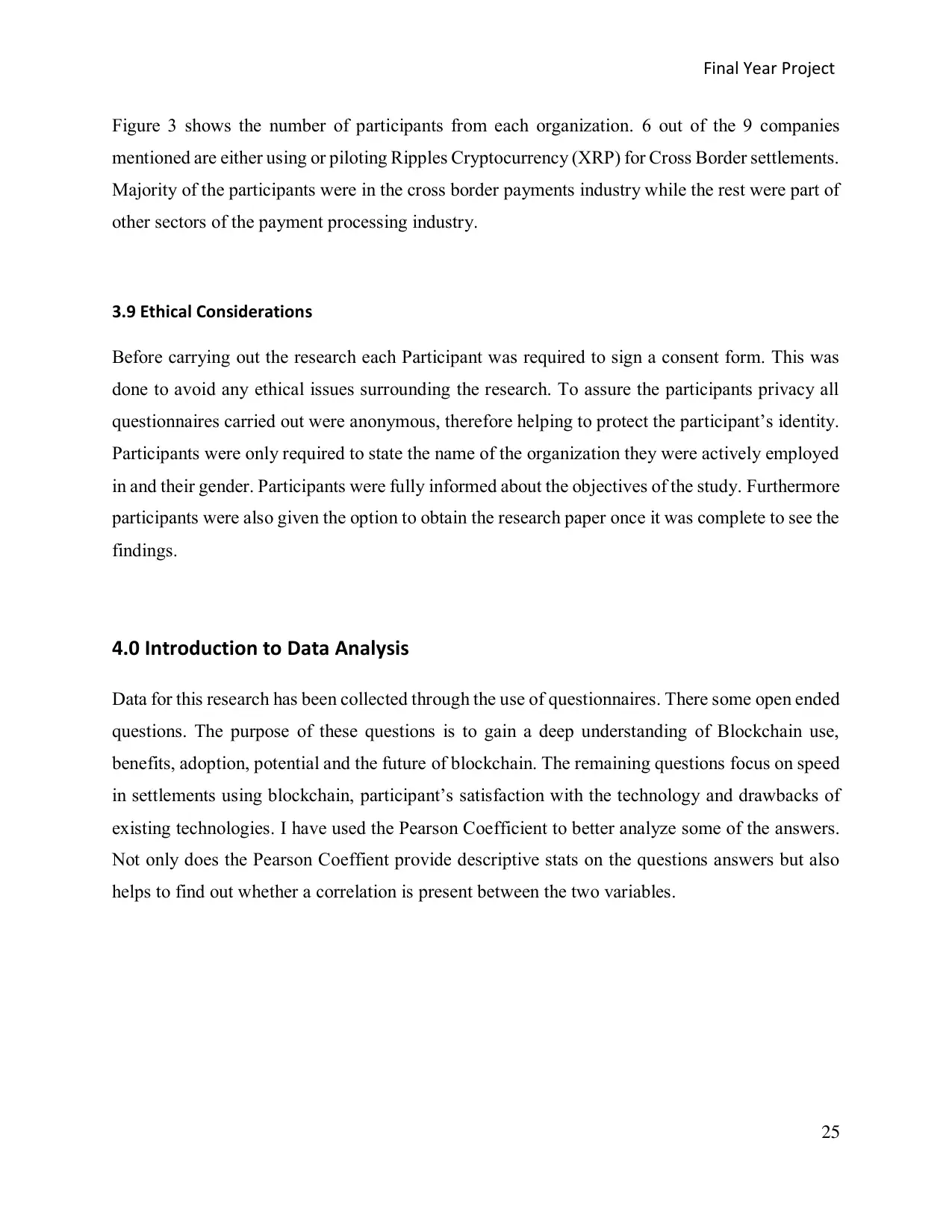
Final Year Project
25
Figure 3 shows the number of participants from each organization. 6 out of the 9 companies
mentioned are either using or piloting Ripples Cryptocurrency (XRP) for Cross Border settlements.
Majority of the participants were in the cross border payments industry while the rest were part of
other sectors of the payment processing industry.
3.9 Ethical Considerations
Before carrying out the research each Participant was required to sign a consent form. This was
done to avoid any ethical issues surrounding the research. To assure the participants privacy all
questionnaires carried out were anonymous, therefore helping to protect the participant’s identity.
Participants were only required to state the name of the organization they were actively employed
in and their gender. Participants were fully informed about the objectives of the study. Furthermore
participants were also given the option to obtain the research paper once it was complete to see the
findings.
4.0 Introduction to Data Analysis
Data for this research has been collected through the use of questionnaires. There some open ended
questions. The purpose of these questions is to gain a deep understanding of Blockchain use,
benefits, adoption, potential and the future of blockchain. The remaining questions focus on speed
in settlements using blockchain, participant’s satisfaction with the technology and drawbacks of
existing technologies. I have used the Pearson Coefficient to better analyze some of the answers.
Not only does the Pearson Coeffient provide descriptive stats on the questions answers but also
helps to find out whether a correlation is present between the two variables.
25
Figure 3 shows the number of participants from each organization. 6 out of the 9 companies
mentioned are either using or piloting Ripples Cryptocurrency (XRP) for Cross Border settlements.
Majority of the participants were in the cross border payments industry while the rest were part of
other sectors of the payment processing industry.
3.9 Ethical Considerations
Before carrying out the research each Participant was required to sign a consent form. This was
done to avoid any ethical issues surrounding the research. To assure the participants privacy all
questionnaires carried out were anonymous, therefore helping to protect the participant’s identity.
Participants were only required to state the name of the organization they were actively employed
in and their gender. Participants were fully informed about the objectives of the study. Furthermore
participants were also given the option to obtain the research paper once it was complete to see the
findings.
4.0 Introduction to Data Analysis
Data for this research has been collected through the use of questionnaires. There some open ended
questions. The purpose of these questions is to gain a deep understanding of Blockchain use,
benefits, adoption, potential and the future of blockchain. The remaining questions focus on speed
in settlements using blockchain, participant’s satisfaction with the technology and drawbacks of
existing technologies. I have used the Pearson Coefficient to better analyze some of the answers.
Not only does the Pearson Coeffient provide descriptive stats on the questions answers but also
helps to find out whether a correlation is present between the two variables.
Paraphrase This Document
Need a fresh take? Get an instant paraphrase of this document with our AI Paraphraser
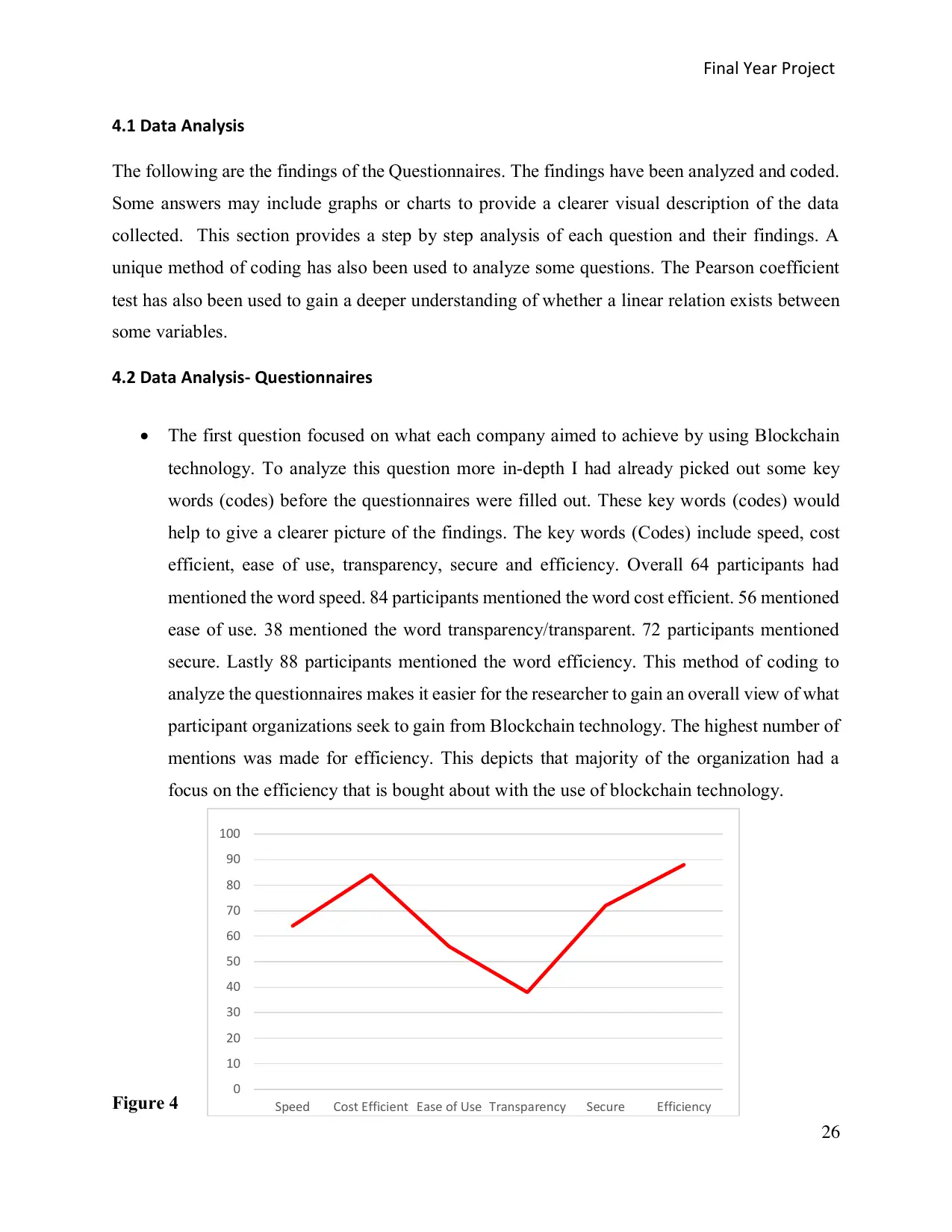
Final Year Project
26
4.1 Data Analysis
The following are the findings of the Questionnaires. The findings have been analyzed and coded.
Some answers may include graphs or charts to provide a clearer visual description of the data
collected. This section provides a step by step analysis of each question and their findings. A
unique method of coding has also been used to analyze some questions. The Pearson coefficient
test has also been used to gain a deeper understanding of whether a linear relation exists between
some variables.
4.2 Data Analysis- Questionnaires
• The first question focused on what each company aimed to achieve by using Blockchain
technology. To analyze this question more in-depth I had already picked out some key
words (codes) before the questionnaires were filled out. These key words (codes) would
help to give a clearer picture of the findings. The key words (Codes) include speed, cost
efficient, ease of use, transparency, secure and efficiency. Overall 64 participants had
mentioned the word speed. 84 participants mentioned the word cost efficient. 56 mentioned
ease of use. 38 mentioned the word transparency/transparent. 72 participants mentioned
secure. Lastly 88 participants mentioned the word efficiency. This method of coding to
analyze the questionnaires makes it easier for the researcher to gain an overall view of what
participant organizations seek to gain from Blockchain technology. The highest number of
mentions was made for efficiency. This depicts that majority of the organization had a
focus on the efficiency that is bought about with the use of blockchain technology.
Figure 4 0
10
20
30
40
50
60
70
80
90
100
Speed Cost Efficient Ease of Use Transparency Secure Efficiency
26
4.1 Data Analysis
The following are the findings of the Questionnaires. The findings have been analyzed and coded.
Some answers may include graphs or charts to provide a clearer visual description of the data
collected. This section provides a step by step analysis of each question and their findings. A
unique method of coding has also been used to analyze some questions. The Pearson coefficient
test has also been used to gain a deeper understanding of whether a linear relation exists between
some variables.
4.2 Data Analysis- Questionnaires
• The first question focused on what each company aimed to achieve by using Blockchain
technology. To analyze this question more in-depth I had already picked out some key
words (codes) before the questionnaires were filled out. These key words (codes) would
help to give a clearer picture of the findings. The key words (Codes) include speed, cost
efficient, ease of use, transparency, secure and efficiency. Overall 64 participants had
mentioned the word speed. 84 participants mentioned the word cost efficient. 56 mentioned
ease of use. 38 mentioned the word transparency/transparent. 72 participants mentioned
secure. Lastly 88 participants mentioned the word efficiency. This method of coding to
analyze the questionnaires makes it easier for the researcher to gain an overall view of what
participant organizations seek to gain from Blockchain technology. The highest number of
mentions was made for efficiency. This depicts that majority of the organization had a
focus on the efficiency that is bought about with the use of blockchain technology.
Figure 4 0
10
20
30
40
50
60
70
80
90
100
Speed Cost Efficient Ease of Use Transparency Secure Efficiency

Final Year Project
27
Figure 4 provides a visual view of the findings gained in question 1. Efficiency was mentioned the
highest times (88) whereas Transparency was mentioned the lowest (38).
• The second question is an open ended question focusing on whether the participant believes
Blockchain is bringing about a financial revolution. Participants are required to choose
either yes or no and then give reasoning for their answers. Out of the 100 participants, 84
answered yes. The remaining 16 answered no. The main reasons provided for saying yes
were based upon the efficiency of blockchain as compared to the existing system and its
potential to disrupt the financial world. For the participants who said no, the main reason
was centered around the absence of regulatory measures and a regulatory framework for
blockchain technology. This way, they argued, Blockchain would never be able to become
mainstream.
• In question 3 participants were asked how Blockchain has helped their company in the
cross border payments sector. This was a close ended question and the participants were
given 6 options. The options given were:
• More secure
• More Transparent
• Higher speed of settlements and transactions
• More cost efficient
• Has not made any changes
• Previous system was better
The participants were allowed to choose more than one option. Out of the 100 participants there
were 74 who chose More cost efficient. 91 of the participants chose higher speed of settlements
and transactions. 88 out of the 100 participants chose more secure. 72 participants out of the sample
chose more transparent. An important finding was that none out of the 100 participants chose did
not make any changes or previous system was better. This finding is very important to the nature
of this study as it proves that every participant in the sample was of the view that Blockchain has
improved some metric in their cross border settlement process.
27
Figure 4 provides a visual view of the findings gained in question 1. Efficiency was mentioned the
highest times (88) whereas Transparency was mentioned the lowest (38).
• The second question is an open ended question focusing on whether the participant believes
Blockchain is bringing about a financial revolution. Participants are required to choose
either yes or no and then give reasoning for their answers. Out of the 100 participants, 84
answered yes. The remaining 16 answered no. The main reasons provided for saying yes
were based upon the efficiency of blockchain as compared to the existing system and its
potential to disrupt the financial world. For the participants who said no, the main reason
was centered around the absence of regulatory measures and a regulatory framework for
blockchain technology. This way, they argued, Blockchain would never be able to become
mainstream.
• In question 3 participants were asked how Blockchain has helped their company in the
cross border payments sector. This was a close ended question and the participants were
given 6 options. The options given were:
• More secure
• More Transparent
• Higher speed of settlements and transactions
• More cost efficient
• Has not made any changes
• Previous system was better
The participants were allowed to choose more than one option. Out of the 100 participants there
were 74 who chose More cost efficient. 91 of the participants chose higher speed of settlements
and transactions. 88 out of the 100 participants chose more secure. 72 participants out of the sample
chose more transparent. An important finding was that none out of the 100 participants chose did
not make any changes or previous system was better. This finding is very important to the nature
of this study as it proves that every participant in the sample was of the view that Blockchain has
improved some metric in their cross border settlement process.
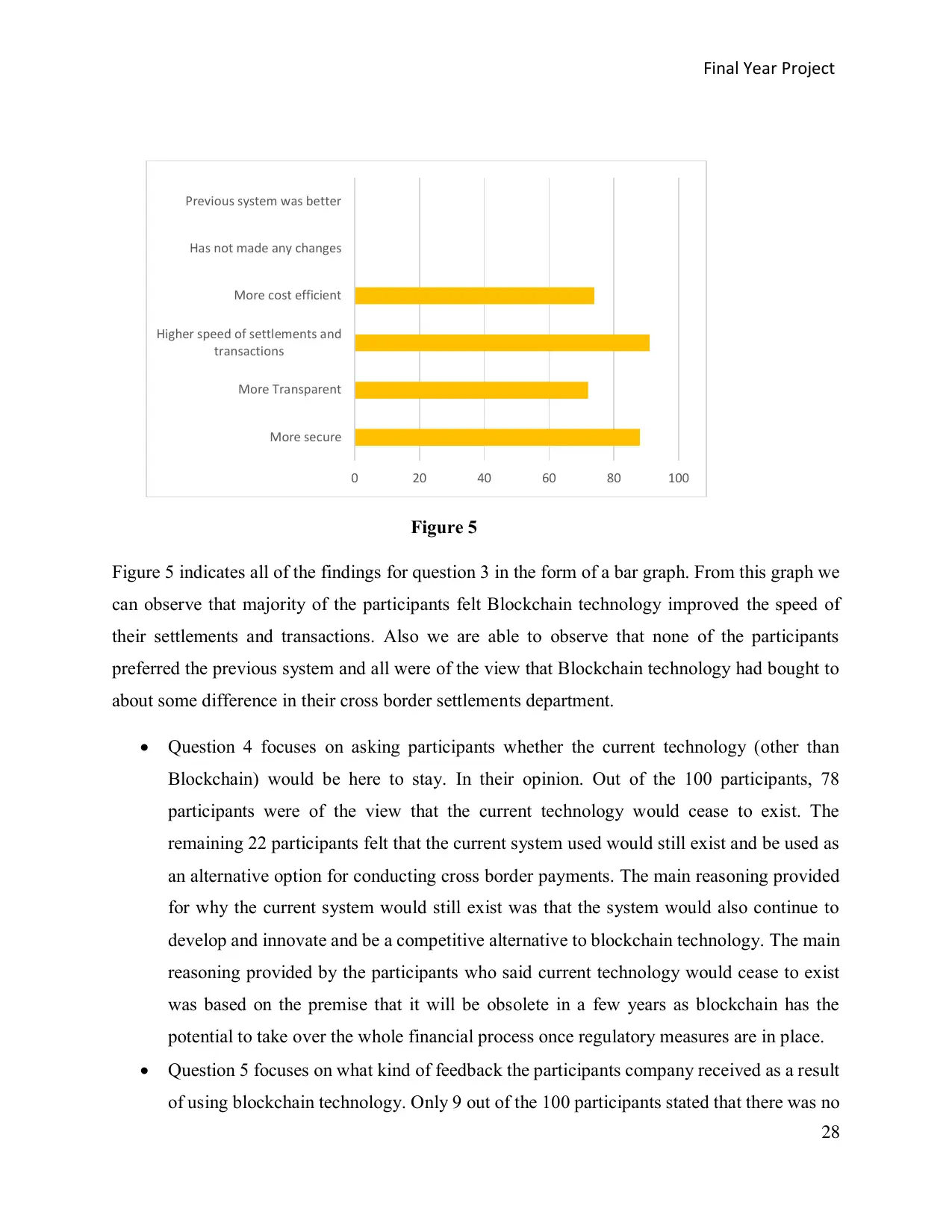
Final Year Project
28
Figure 5
Figure 5 indicates all of the findings for question 3 in the form of a bar graph. From this graph we
can observe that majority of the participants felt Blockchain technology improved the speed of
their settlements and transactions. Also we are able to observe that none of the participants
preferred the previous system and all were of the view that Blockchain technology had bought to
about some difference in their cross border settlements department.
• Question 4 focuses on asking participants whether the current technology (other than
Blockchain) would be here to stay. In their opinion. Out of the 100 participants, 78
participants were of the view that the current technology would cease to exist. The
remaining 22 participants felt that the current system used would still exist and be used as
an alternative option for conducting cross border payments. The main reasoning provided
for why the current system would still exist was that the system would also continue to
develop and innovate and be a competitive alternative to blockchain technology. The main
reasoning provided by the participants who said current technology would cease to exist
was based on the premise that it will be obsolete in a few years as blockchain has the
potential to take over the whole financial process once regulatory measures are in place.
• Question 5 focuses on what kind of feedback the participants company received as a result
of using blockchain technology. Only 9 out of the 100 participants stated that there was no
0 20 40 60 80 100
More secure
More Transparent
Higher speed of settlements and
transactions
More cost efficient
Has not made any changes
Previous system was better
28
Figure 5
Figure 5 indicates all of the findings for question 3 in the form of a bar graph. From this graph we
can observe that majority of the participants felt Blockchain technology improved the speed of
their settlements and transactions. Also we are able to observe that none of the participants
preferred the previous system and all were of the view that Blockchain technology had bought to
about some difference in their cross border settlements department.
• Question 4 focuses on asking participants whether the current technology (other than
Blockchain) would be here to stay. In their opinion. Out of the 100 participants, 78
participants were of the view that the current technology would cease to exist. The
remaining 22 participants felt that the current system used would still exist and be used as
an alternative option for conducting cross border payments. The main reasoning provided
for why the current system would still exist was that the system would also continue to
develop and innovate and be a competitive alternative to blockchain technology. The main
reasoning provided by the participants who said current technology would cease to exist
was based on the premise that it will be obsolete in a few years as blockchain has the
potential to take over the whole financial process once regulatory measures are in place.
• Question 5 focuses on what kind of feedback the participants company received as a result
of using blockchain technology. Only 9 out of the 100 participants stated that there was no
0 20 40 60 80 100
More secure
More Transparent
Higher speed of settlements and
transactions
More cost efficient
Has not made any changes
Previous system was better
Secure Best Marks with AI Grader
Need help grading? Try our AI Grader for instant feedback on your assignments.
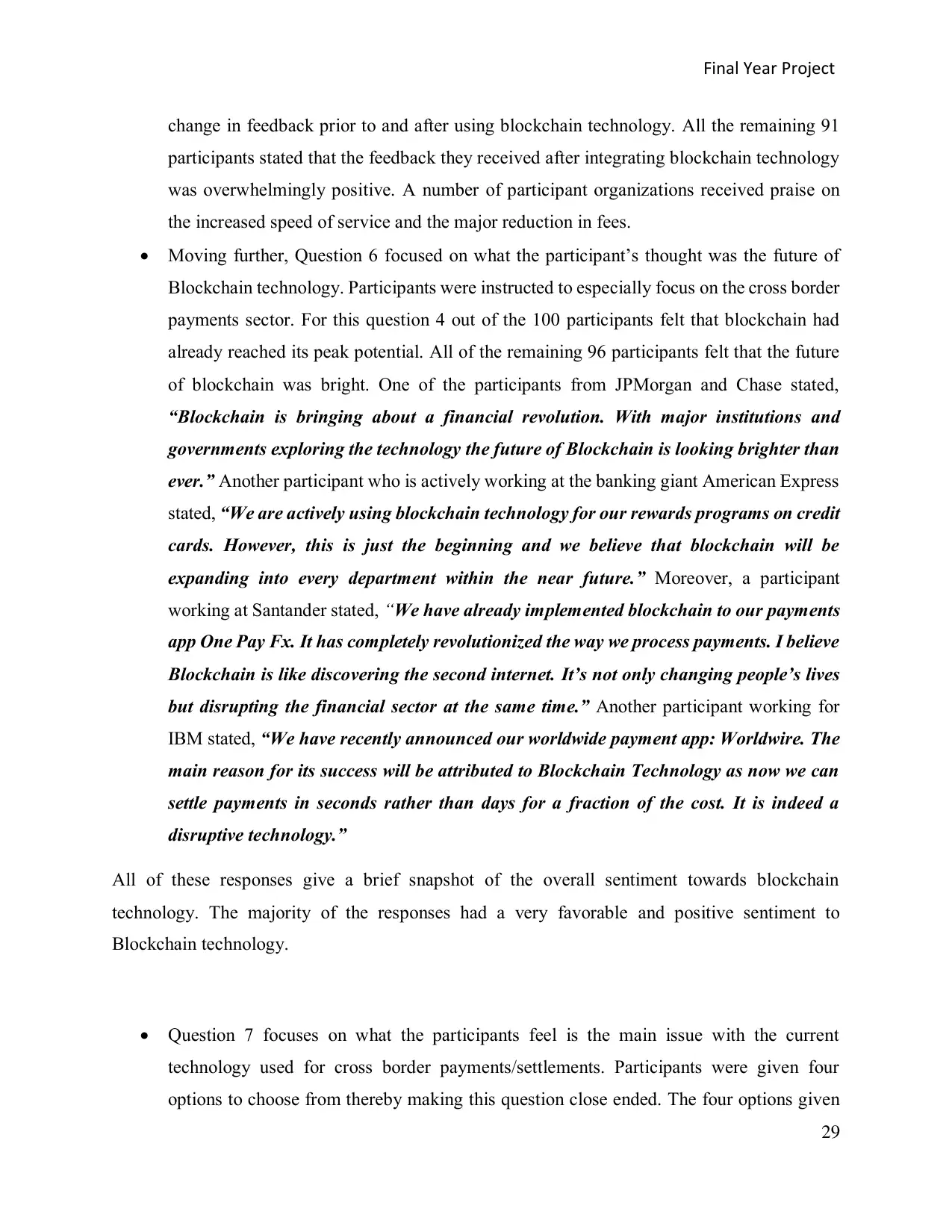
Final Year Project
29
change in feedback prior to and after using blockchain technology. All the remaining 91
participants stated that the feedback they received after integrating blockchain technology
was overwhelmingly positive. A number of participant organizations received praise on
the increased speed of service and the major reduction in fees.
• Moving further, Question 6 focused on what the participant’s thought was the future of
Blockchain technology. Participants were instructed to especially focus on the cross border
payments sector. For this question 4 out of the 100 participants felt that blockchain had
already reached its peak potential. All of the remaining 96 participants felt that the future
of blockchain was bright. One of the participants from JPMorgan and Chase stated,
“Blockchain is bringing about a financial revolution. With major institutions and
governments exploring the technology the future of Blockchain is looking brighter than
ever.” Another participant who is actively working at the banking giant American Express
stated, “We are actively using blockchain technology for our rewards programs on credit
cards. However, this is just the beginning and we believe that blockchain will be
expanding into every department within the near future.” Moreover, a participant
working at Santander stated, “We have already implemented blockchain to our payments
app One Pay Fx. It has completely revolutionized the way we process payments. I believe
Blockchain is like discovering the second internet. It’s not only changing people’s lives
but disrupting the financial sector at the same time.” Another participant working for
IBM stated, “We have recently announced our worldwide payment app: Worldwire. The
main reason for its success will be attributed to Blockchain Technology as now we can
settle payments in seconds rather than days for a fraction of the cost. It is indeed a
disruptive technology.”
All of these responses give a brief snapshot of the overall sentiment towards blockchain
technology. The majority of the responses had a very favorable and positive sentiment to
Blockchain technology.
• Question 7 focuses on what the participants feel is the main issue with the current
technology used for cross border payments/settlements. Participants were given four
options to choose from thereby making this question close ended. The four options given
29
change in feedback prior to and after using blockchain technology. All the remaining 91
participants stated that the feedback they received after integrating blockchain technology
was overwhelmingly positive. A number of participant organizations received praise on
the increased speed of service and the major reduction in fees.
• Moving further, Question 6 focused on what the participant’s thought was the future of
Blockchain technology. Participants were instructed to especially focus on the cross border
payments sector. For this question 4 out of the 100 participants felt that blockchain had
already reached its peak potential. All of the remaining 96 participants felt that the future
of blockchain was bright. One of the participants from JPMorgan and Chase stated,
“Blockchain is bringing about a financial revolution. With major institutions and
governments exploring the technology the future of Blockchain is looking brighter than
ever.” Another participant who is actively working at the banking giant American Express
stated, “We are actively using blockchain technology for our rewards programs on credit
cards. However, this is just the beginning and we believe that blockchain will be
expanding into every department within the near future.” Moreover, a participant
working at Santander stated, “We have already implemented blockchain to our payments
app One Pay Fx. It has completely revolutionized the way we process payments. I believe
Blockchain is like discovering the second internet. It’s not only changing people’s lives
but disrupting the financial sector at the same time.” Another participant working for
IBM stated, “We have recently announced our worldwide payment app: Worldwire. The
main reason for its success will be attributed to Blockchain Technology as now we can
settle payments in seconds rather than days for a fraction of the cost. It is indeed a
disruptive technology.”
All of these responses give a brief snapshot of the overall sentiment towards blockchain
technology. The majority of the responses had a very favorable and positive sentiment to
Blockchain technology.
• Question 7 focuses on what the participants feel is the main issue with the current
technology used for cross border payments/settlements. Participants were given four
options to choose from thereby making this question close ended. The four options given

Final Year Project
30
are some of the most widespread problems with the current system as researched by the
author. The following is the data collected for this question. 44 participants chose Slow
processing speed as the main issue. 24 chose high costs as the main issue. 12 of the
participants chose need for intermediary authority whereas the remaining 20 participants
chose Security issues as the main problem with the current system.
• For Question 8 the author inquired whether the participants felt that blockchain will have
mass adoption in the business world. This question was close ended and had two options:
Yes, and No. This question would help to gauge whether financial professionals in the real
business world think that blockchain technology would have mass adoption. In this
question 91 participants opted for the option yes. The remaining 9 opted for the option no.
This is an interesting finding as 91% of the participants agree that blockchain technology
will have mass adoption.
• Question 9 focuses on the rating participants would give based on the speed of blockchain
technology in terms of payments as compared to the current system. A scale ranging from
1-10 was provided in this question. This question is important for research into blockchain
technology as one of the main factors businesses are interested in relating to blockchain
technology is the speed in transactions. For this question we calculated the mean from a
set of 100 scores given by the participants. The mean was calculated as 7.93. This shows
that majority of the participants were very satisfied with the speed of transactions
blockchain technology provides.
• For Question 10, the author decided to include another close ended question based on the
rating scale. In this question participants were asked how satisfied they were with use of
blockchain technology in payments as compared to the existing system. The same 1-10
rating scale was applied as it was done in the previous question. After obtaining the filled
in questionnaires the author decided to calculate the mean of the 100 scores received. The
mean was calculated to be 7.83. This again was a very positive result in the favor of
blockchain technology.
We decided to run further tests to find out whether the results from Question 9 correlated with the
results from Question 10. For this we chose to run the numbers through a Pearson coefficient test.
This coefficient is denoted by the letter r. Its sole aim is to find out the strength of a linear
association between two variables. The values that can be found out through this tests range from
30
are some of the most widespread problems with the current system as researched by the
author. The following is the data collected for this question. 44 participants chose Slow
processing speed as the main issue. 24 chose high costs as the main issue. 12 of the
participants chose need for intermediary authority whereas the remaining 20 participants
chose Security issues as the main problem with the current system.
• For Question 8 the author inquired whether the participants felt that blockchain will have
mass adoption in the business world. This question was close ended and had two options:
Yes, and No. This question would help to gauge whether financial professionals in the real
business world think that blockchain technology would have mass adoption. In this
question 91 participants opted for the option yes. The remaining 9 opted for the option no.
This is an interesting finding as 91% of the participants agree that blockchain technology
will have mass adoption.
• Question 9 focuses on the rating participants would give based on the speed of blockchain
technology in terms of payments as compared to the current system. A scale ranging from
1-10 was provided in this question. This question is important for research into blockchain
technology as one of the main factors businesses are interested in relating to blockchain
technology is the speed in transactions. For this question we calculated the mean from a
set of 100 scores given by the participants. The mean was calculated as 7.93. This shows
that majority of the participants were very satisfied with the speed of transactions
blockchain technology provides.
• For Question 10, the author decided to include another close ended question based on the
rating scale. In this question participants were asked how satisfied they were with use of
blockchain technology in payments as compared to the existing system. The same 1-10
rating scale was applied as it was done in the previous question. After obtaining the filled
in questionnaires the author decided to calculate the mean of the 100 scores received. The
mean was calculated to be 7.83. This again was a very positive result in the favor of
blockchain technology.
We decided to run further tests to find out whether the results from Question 9 correlated with the
results from Question 10. For this we chose to run the numbers through a Pearson coefficient test.
This coefficient is denoted by the letter r. Its sole aim is to find out the strength of a linear
association between two variables. The values that can be found out through this tests range from
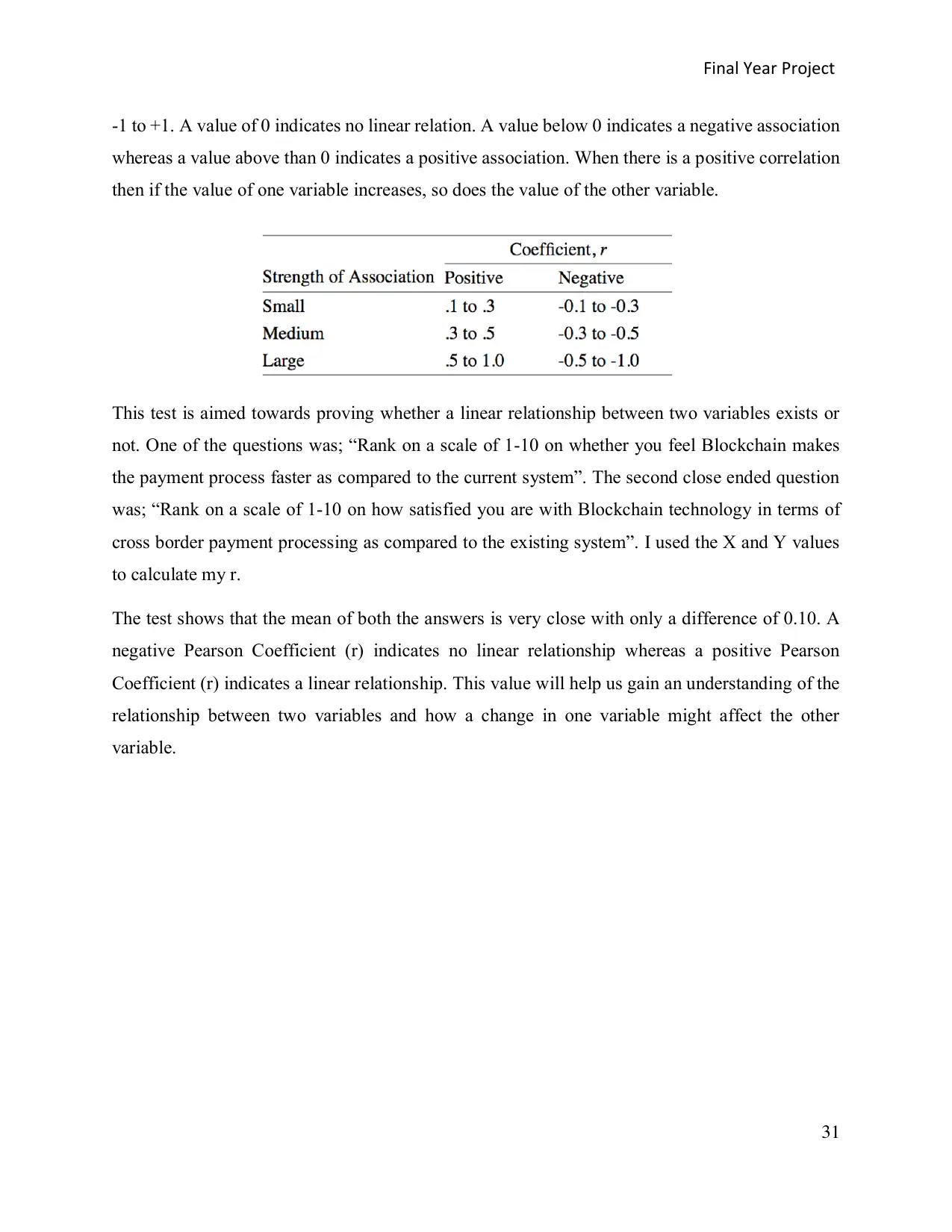
Final Year Project
31
-1 to +1. A value of 0 indicates no linear relation. A value below 0 indicates a negative association
whereas a value above than 0 indicates a positive association. When there is a positive correlation
then if the value of one variable increases, so does the value of the other variable.
This test is aimed towards proving whether a linear relationship between two variables exists or
not. One of the questions was; “Rank on a scale of 1-10 on whether you feel Blockchain makes
the payment process faster as compared to the current system”. The second close ended question
was; “Rank on a scale of 1-10 on how satisfied you are with Blockchain technology in terms of
cross border payment processing as compared to the existing system”. I used the X and Y values
to calculate my r.
The test shows that the mean of both the answers is very close with only a difference of 0.10. A
negative Pearson Coefficient (r) indicates no linear relationship whereas a positive Pearson
Coefficient (r) indicates a linear relationship. This value will help us gain an understanding of the
relationship between two variables and how a change in one variable might affect the other
variable.
31
-1 to +1. A value of 0 indicates no linear relation. A value below 0 indicates a negative association
whereas a value above than 0 indicates a positive association. When there is a positive correlation
then if the value of one variable increases, so does the value of the other variable.
This test is aimed towards proving whether a linear relationship between two variables exists or
not. One of the questions was; “Rank on a scale of 1-10 on whether you feel Blockchain makes
the payment process faster as compared to the current system”. The second close ended question
was; “Rank on a scale of 1-10 on how satisfied you are with Blockchain technology in terms of
cross border payment processing as compared to the existing system”. I used the X and Y values
to calculate my r.
The test shows that the mean of both the answers is very close with only a difference of 0.10. A
negative Pearson Coefficient (r) indicates no linear relationship whereas a positive Pearson
Coefficient (r) indicates a linear relationship. This value will help us gain an understanding of the
relationship between two variables and how a change in one variable might affect the other
variable.
Paraphrase This Document
Need a fresh take? Get an instant paraphrase of this document with our AI Paraphraser
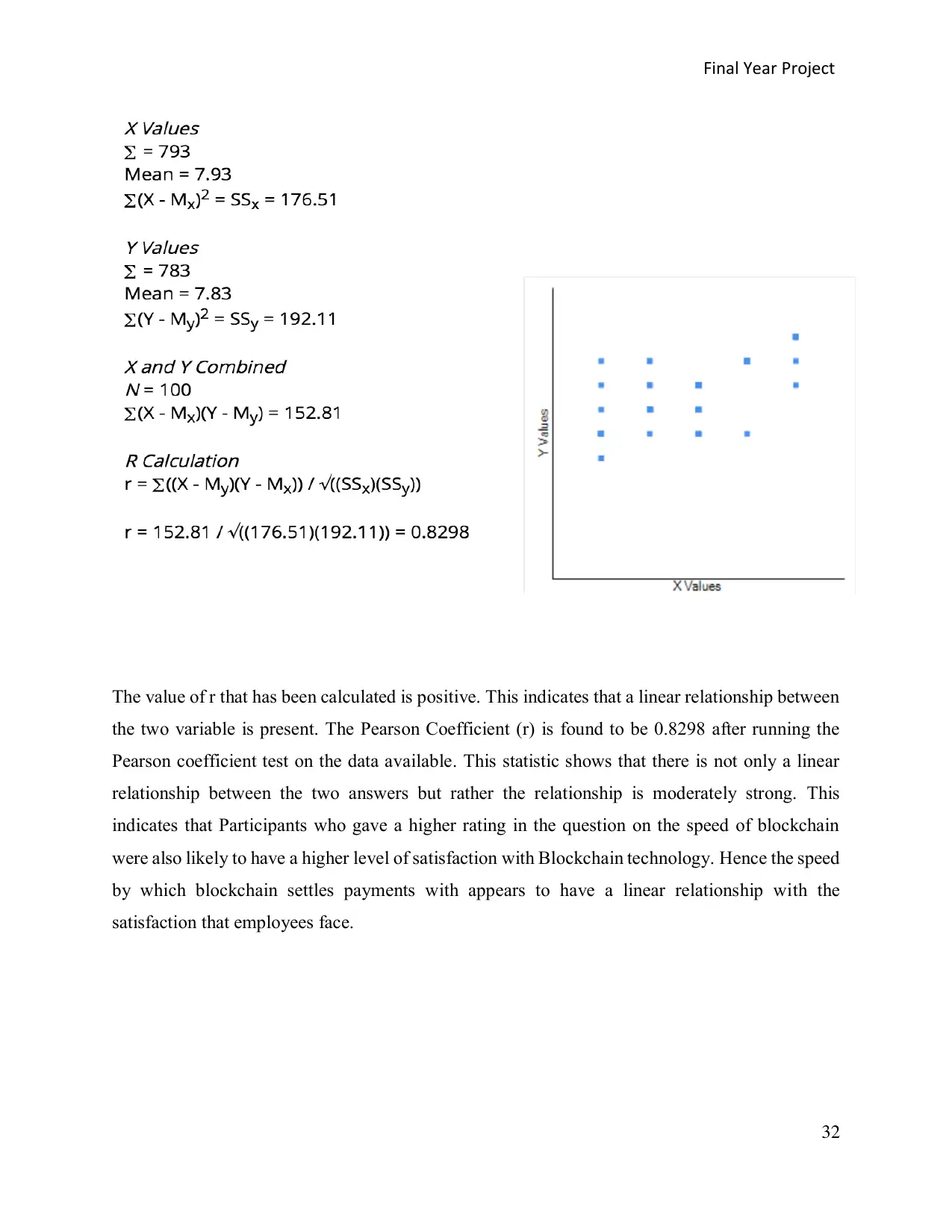
Final Year Project
32
The value of r that has been calculated is positive. This indicates that a linear relationship between
the two variable is present. The Pearson Coefficient (r) is found to be 0.8298 after running the
Pearson coefficient test on the data available. This statistic shows that there is not only a linear
relationship between the two answers but rather the relationship is moderately strong. This
indicates that Participants who gave a higher rating in the question on the speed of blockchain
were also likely to have a higher level of satisfaction with Blockchain technology. Hence the speed
by which blockchain settles payments with appears to have a linear relationship with the
satisfaction that employees face.
32
The value of r that has been calculated is positive. This indicates that a linear relationship between
the two variable is present. The Pearson Coefficient (r) is found to be 0.8298 after running the
Pearson coefficient test on the data available. This statistic shows that there is not only a linear
relationship between the two answers but rather the relationship is moderately strong. This
indicates that Participants who gave a higher rating in the question on the speed of blockchain
were also likely to have a higher level of satisfaction with Blockchain technology. Hence the speed
by which blockchain settles payments with appears to have a linear relationship with the
satisfaction that employees face.
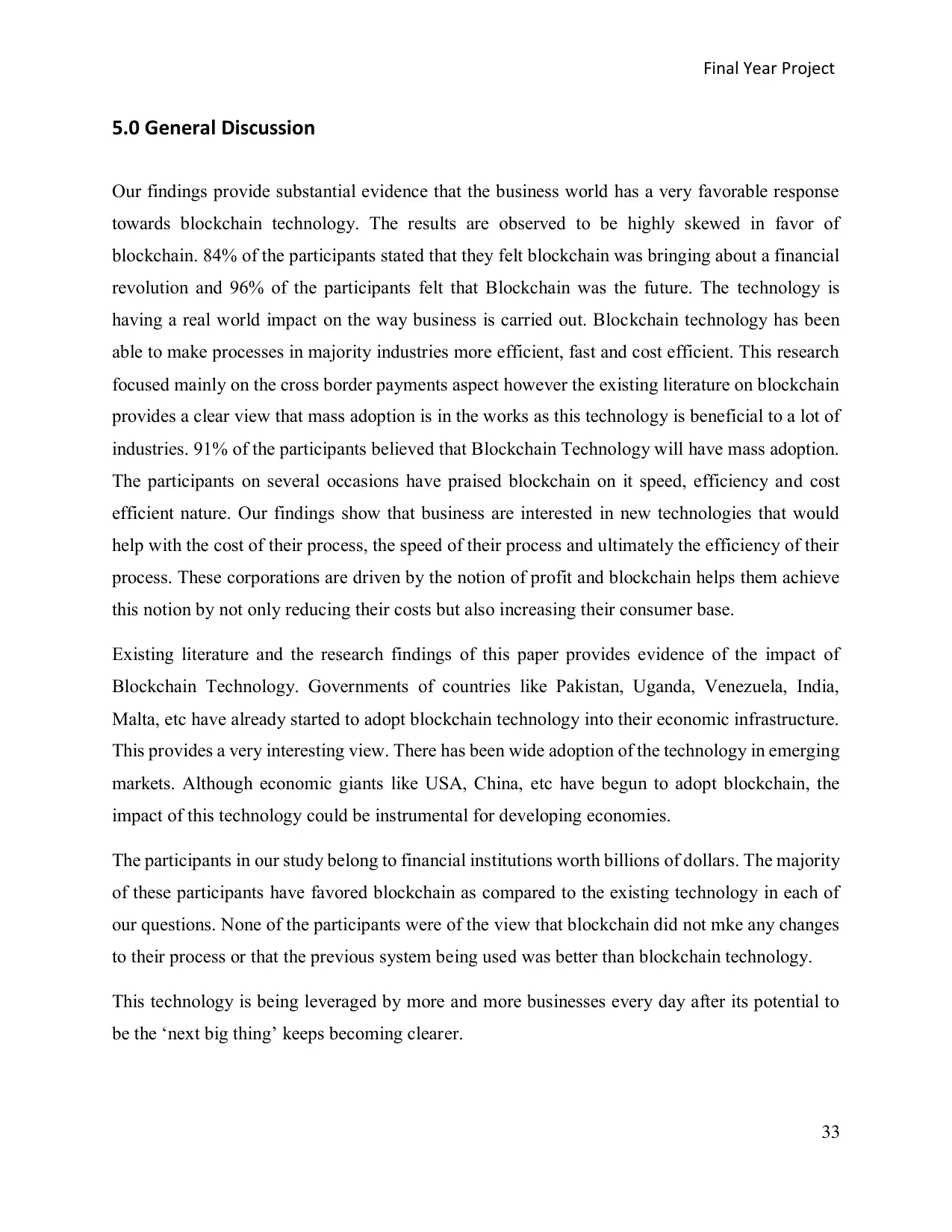
Final Year Project
33
5.0 General Discussion
Our findings provide substantial evidence that the business world has a very favorable response
towards blockchain technology. The results are observed to be highly skewed in favor of
blockchain. 84% of the participants stated that they felt blockchain was bringing about a financial
revolution and 96% of the participants felt that Blockchain was the future. The technology is
having a real world impact on the way business is carried out. Blockchain technology has been
able to make processes in majority industries more efficient, fast and cost efficient. This research
focused mainly on the cross border payments aspect however the existing literature on blockchain
provides a clear view that mass adoption is in the works as this technology is beneficial to a lot of
industries. 91% of the participants believed that Blockchain Technology will have mass adoption.
The participants on several occasions have praised blockchain on it speed, efficiency and cost
efficient nature. Our findings show that business are interested in new technologies that would
help with the cost of their process, the speed of their process and ultimately the efficiency of their
process. These corporations are driven by the notion of profit and blockchain helps them achieve
this notion by not only reducing their costs but also increasing their consumer base.
Existing literature and the research findings of this paper provides evidence of the impact of
Blockchain Technology. Governments of countries like Pakistan, Uganda, Venezuela, India,
Malta, etc have already started to adopt blockchain technology into their economic infrastructure.
This provides a very interesting view. There has been wide adoption of the technology in emerging
markets. Although economic giants like USA, China, etc have begun to adopt blockchain, the
impact of this technology could be instrumental for developing economies.
The participants in our study belong to financial institutions worth billions of dollars. The majority
of these participants have favored blockchain as compared to the existing technology in each of
our questions. None of the participants were of the view that blockchain did not mke any changes
to their process or that the previous system being used was better than blockchain technology.
This technology is being leveraged by more and more businesses every day after its potential to
be the ‘next big thing’ keeps becoming clearer.
33
5.0 General Discussion
Our findings provide substantial evidence that the business world has a very favorable response
towards blockchain technology. The results are observed to be highly skewed in favor of
blockchain. 84% of the participants stated that they felt blockchain was bringing about a financial
revolution and 96% of the participants felt that Blockchain was the future. The technology is
having a real world impact on the way business is carried out. Blockchain technology has been
able to make processes in majority industries more efficient, fast and cost efficient. This research
focused mainly on the cross border payments aspect however the existing literature on blockchain
provides a clear view that mass adoption is in the works as this technology is beneficial to a lot of
industries. 91% of the participants believed that Blockchain Technology will have mass adoption.
The participants on several occasions have praised blockchain on it speed, efficiency and cost
efficient nature. Our findings show that business are interested in new technologies that would
help with the cost of their process, the speed of their process and ultimately the efficiency of their
process. These corporations are driven by the notion of profit and blockchain helps them achieve
this notion by not only reducing their costs but also increasing their consumer base.
Existing literature and the research findings of this paper provides evidence of the impact of
Blockchain Technology. Governments of countries like Pakistan, Uganda, Venezuela, India,
Malta, etc have already started to adopt blockchain technology into their economic infrastructure.
This provides a very interesting view. There has been wide adoption of the technology in emerging
markets. Although economic giants like USA, China, etc have begun to adopt blockchain, the
impact of this technology could be instrumental for developing economies.
The participants in our study belong to financial institutions worth billions of dollars. The majority
of these participants have favored blockchain as compared to the existing technology in each of
our questions. None of the participants were of the view that blockchain did not mke any changes
to their process or that the previous system being used was better than blockchain technology.
This technology is being leveraged by more and more businesses every day after its potential to
be the ‘next big thing’ keeps becoming clearer.
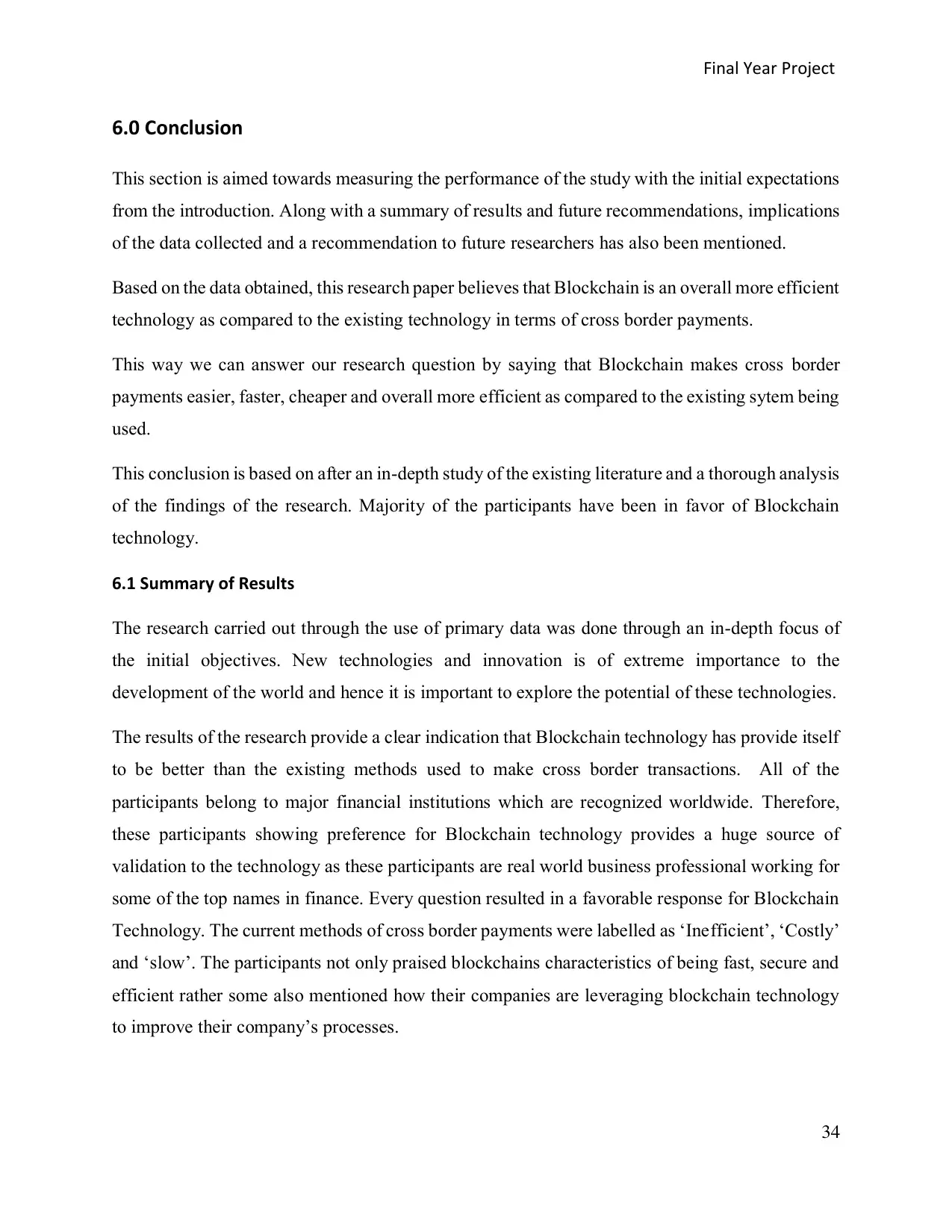
Final Year Project
34
6.0 Conclusion
This section is aimed towards measuring the performance of the study with the initial expectations
from the introduction. Along with a summary of results and future recommendations, implications
of the data collected and a recommendation to future researchers has also been mentioned.
Based on the data obtained, this research paper believes that Blockchain is an overall more efficient
technology as compared to the existing technology in terms of cross border payments.
This way we can answer our research question by saying that Blockchain makes cross border
payments easier, faster, cheaper and overall more efficient as compared to the existing sytem being
used.
This conclusion is based on after an in-depth study of the existing literature and a thorough analysis
of the findings of the research. Majority of the participants have been in favor of Blockchain
technology.
6.1 Summary of Results
The research carried out through the use of primary data was done through an in-depth focus of
the initial objectives. New technologies and innovation is of extreme importance to the
development of the world and hence it is important to explore the potential of these technologies.
The results of the research provide a clear indication that Blockchain technology has provide itself
to be better than the existing methods used to make cross border transactions. All of the
participants belong to major financial institutions which are recognized worldwide. Therefore,
these participants showing preference for Blockchain technology provides a huge source of
validation to the technology as these participants are real world business professional working for
some of the top names in finance. Every question resulted in a favorable response for Blockchain
Technology. The current methods of cross border payments were labelled as ‘Inefficient’, ‘Costly’
and ‘slow’. The participants not only praised blockchains characteristics of being fast, secure and
efficient rather some also mentioned how their companies are leveraging blockchain technology
to improve their company’s processes.
34
6.0 Conclusion
This section is aimed towards measuring the performance of the study with the initial expectations
from the introduction. Along with a summary of results and future recommendations, implications
of the data collected and a recommendation to future researchers has also been mentioned.
Based on the data obtained, this research paper believes that Blockchain is an overall more efficient
technology as compared to the existing technology in terms of cross border payments.
This way we can answer our research question by saying that Blockchain makes cross border
payments easier, faster, cheaper and overall more efficient as compared to the existing sytem being
used.
This conclusion is based on after an in-depth study of the existing literature and a thorough analysis
of the findings of the research. Majority of the participants have been in favor of Blockchain
technology.
6.1 Summary of Results
The research carried out through the use of primary data was done through an in-depth focus of
the initial objectives. New technologies and innovation is of extreme importance to the
development of the world and hence it is important to explore the potential of these technologies.
The results of the research provide a clear indication that Blockchain technology has provide itself
to be better than the existing methods used to make cross border transactions. All of the
participants belong to major financial institutions which are recognized worldwide. Therefore,
these participants showing preference for Blockchain technology provides a huge source of
validation to the technology as these participants are real world business professional working for
some of the top names in finance. Every question resulted in a favorable response for Blockchain
Technology. The current methods of cross border payments were labelled as ‘Inefficient’, ‘Costly’
and ‘slow’. The participants not only praised blockchains characteristics of being fast, secure and
efficient rather some also mentioned how their companies are leveraging blockchain technology
to improve their company’s processes.
Secure Best Marks with AI Grader
Need help grading? Try our AI Grader for instant feedback on your assignments.
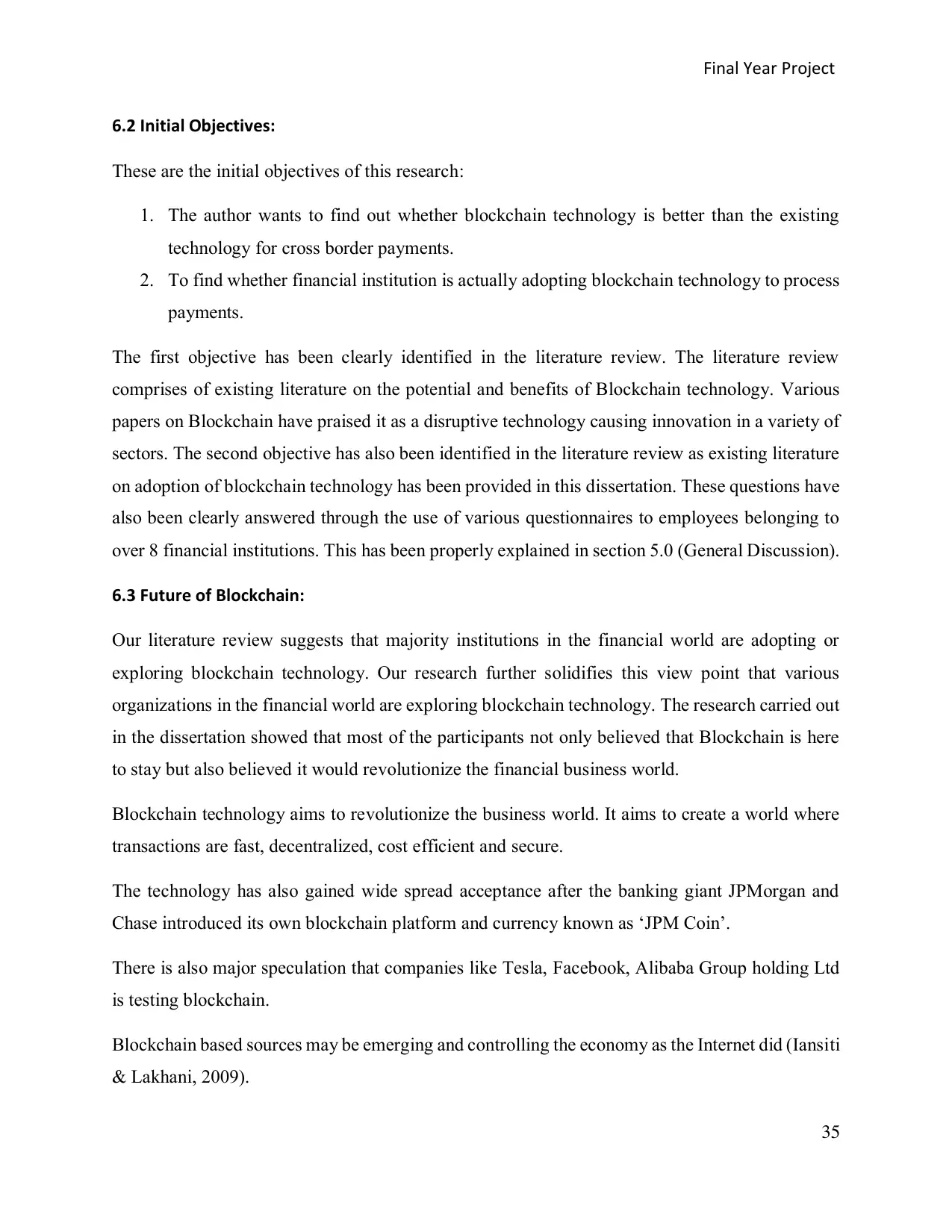
Final Year Project
35
6.2 Initial Objectives:
These are the initial objectives of this research:
1. The author wants to find out whether blockchain technology is better than the existing
technology for cross border payments.
2. To find whether financial institution is actually adopting blockchain technology to process
payments.
The first objective has been clearly identified in the literature review. The literature review
comprises of existing literature on the potential and benefits of Blockchain technology. Various
papers on Blockchain have praised it as a disruptive technology causing innovation in a variety of
sectors. The second objective has also been identified in the literature review as existing literature
on adoption of blockchain technology has been provided in this dissertation. These questions have
also been clearly answered through the use of various questionnaires to employees belonging to
over 8 financial institutions. This has been properly explained in section 5.0 (General Discussion).
6.3 Future of Blockchain:
Our literature review suggests that majority institutions in the financial world are adopting or
exploring blockchain technology. Our research further solidifies this view point that various
organizations in the financial world are exploring blockchain technology. The research carried out
in the dissertation showed that most of the participants not only believed that Blockchain is here
to stay but also believed it would revolutionize the financial business world.
Blockchain technology aims to revolutionize the business world. It aims to create a world where
transactions are fast, decentralized, cost efficient and secure.
The technology has also gained wide spread acceptance after the banking giant JPMorgan and
Chase introduced its own blockchain platform and currency known as ‘JPM Coin’.
There is also major speculation that companies like Tesla, Facebook, Alibaba Group holding Ltd
is testing blockchain.
Blockchain based sources may be emerging and controlling the economy as the Internet did (Iansiti
& Lakhani, 2009).
35
6.2 Initial Objectives:
These are the initial objectives of this research:
1. The author wants to find out whether blockchain technology is better than the existing
technology for cross border payments.
2. To find whether financial institution is actually adopting blockchain technology to process
payments.
The first objective has been clearly identified in the literature review. The literature review
comprises of existing literature on the potential and benefits of Blockchain technology. Various
papers on Blockchain have praised it as a disruptive technology causing innovation in a variety of
sectors. The second objective has also been identified in the literature review as existing literature
on adoption of blockchain technology has been provided in this dissertation. These questions have
also been clearly answered through the use of various questionnaires to employees belonging to
over 8 financial institutions. This has been properly explained in section 5.0 (General Discussion).
6.3 Future of Blockchain:
Our literature review suggests that majority institutions in the financial world are adopting or
exploring blockchain technology. Our research further solidifies this view point that various
organizations in the financial world are exploring blockchain technology. The research carried out
in the dissertation showed that most of the participants not only believed that Blockchain is here
to stay but also believed it would revolutionize the financial business world.
Blockchain technology aims to revolutionize the business world. It aims to create a world where
transactions are fast, decentralized, cost efficient and secure.
The technology has also gained wide spread acceptance after the banking giant JPMorgan and
Chase introduced its own blockchain platform and currency known as ‘JPM Coin’.
There is also major speculation that companies like Tesla, Facebook, Alibaba Group holding Ltd
is testing blockchain.
Blockchain based sources may be emerging and controlling the economy as the Internet did (Iansiti
& Lakhani, 2009).
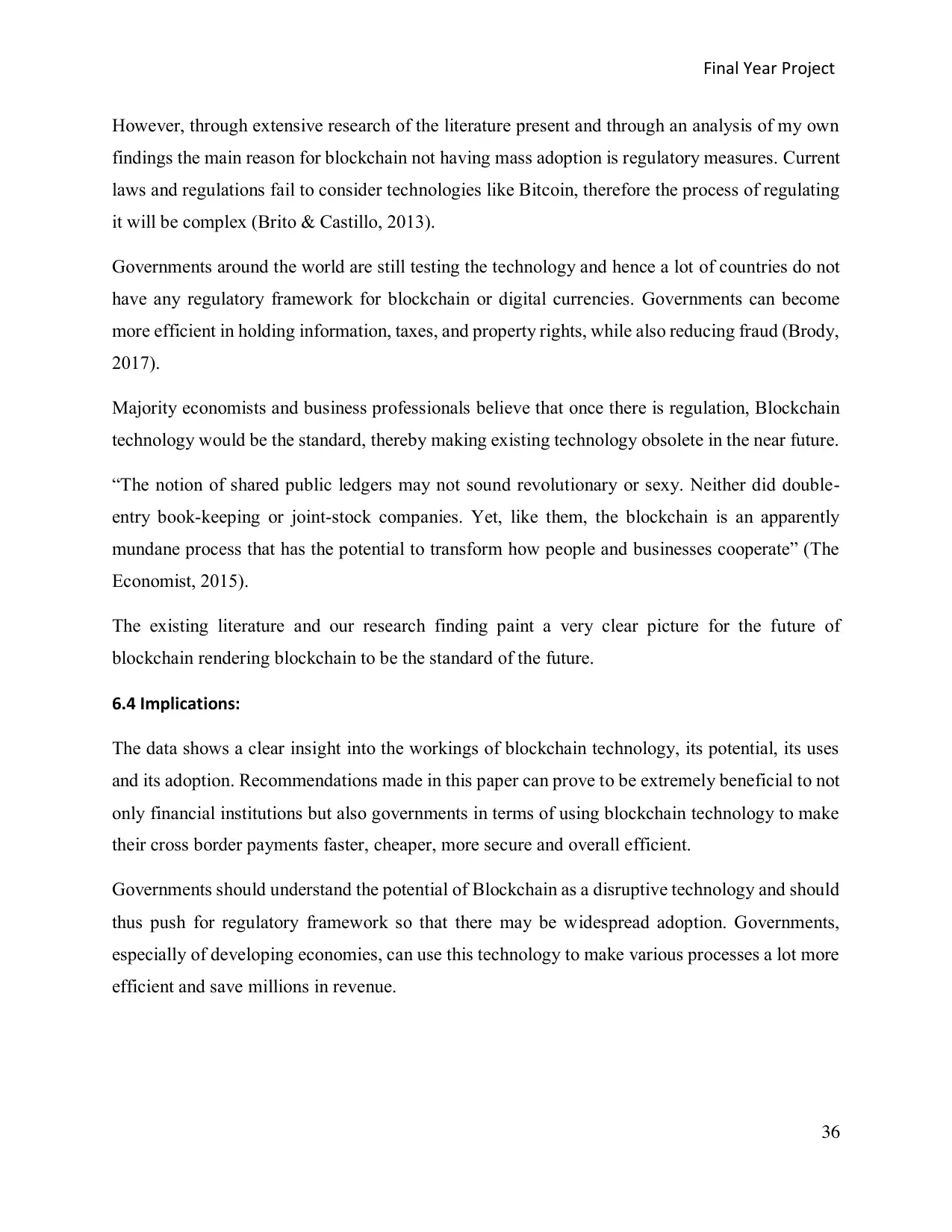
Final Year Project
36
However, through extensive research of the literature present and through an analysis of my own
findings the main reason for blockchain not having mass adoption is regulatory measures. Current
laws and regulations fail to consider technologies like Bitcoin, therefore the process of regulating
it will be complex (Brito & Castillo, 2013).
Governments around the world are still testing the technology and hence a lot of countries do not
have any regulatory framework for blockchain or digital currencies. Governments can become
more efficient in holding information, taxes, and property rights, while also reducing fraud (Brody,
2017).
Majority economists and business professionals believe that once there is regulation, Blockchain
technology would be the standard, thereby making existing technology obsolete in the near future.
“The notion of shared public ledgers may not sound revolutionary or sexy. Neither did double-
entry book-keeping or joint-stock companies. Yet, like them, the blockchain is an apparently
mundane process that has the potential to transform how people and businesses cooperate” (The
Economist, 2015).
The existing literature and our research finding paint a very clear picture for the future of
blockchain rendering blockchain to be the standard of the future.
6.4 Implications:
The data shows a clear insight into the workings of blockchain technology, its potential, its uses
and its adoption. Recommendations made in this paper can prove to be extremely beneficial to not
only financial institutions but also governments in terms of using blockchain technology to make
their cross border payments faster, cheaper, more secure and overall efficient.
Governments should understand the potential of Blockchain as a disruptive technology and should
thus push for regulatory framework so that there may be widespread adoption. Governments,
especially of developing economies, can use this technology to make various processes a lot more
efficient and save millions in revenue.
36
However, through extensive research of the literature present and through an analysis of my own
findings the main reason for blockchain not having mass adoption is regulatory measures. Current
laws and regulations fail to consider technologies like Bitcoin, therefore the process of regulating
it will be complex (Brito & Castillo, 2013).
Governments around the world are still testing the technology and hence a lot of countries do not
have any regulatory framework for blockchain or digital currencies. Governments can become
more efficient in holding information, taxes, and property rights, while also reducing fraud (Brody,
2017).
Majority economists and business professionals believe that once there is regulation, Blockchain
technology would be the standard, thereby making existing technology obsolete in the near future.
“The notion of shared public ledgers may not sound revolutionary or sexy. Neither did double-
entry book-keeping or joint-stock companies. Yet, like them, the blockchain is an apparently
mundane process that has the potential to transform how people and businesses cooperate” (The
Economist, 2015).
The existing literature and our research finding paint a very clear picture for the future of
blockchain rendering blockchain to be the standard of the future.
6.4 Implications:
The data shows a clear insight into the workings of blockchain technology, its potential, its uses
and its adoption. Recommendations made in this paper can prove to be extremely beneficial to not
only financial institutions but also governments in terms of using blockchain technology to make
their cross border payments faster, cheaper, more secure and overall efficient.
Governments should understand the potential of Blockchain as a disruptive technology and should
thus push for regulatory framework so that there may be widespread adoption. Governments,
especially of developing economies, can use this technology to make various processes a lot more
efficient and save millions in revenue.

Final Year Project
37
6.5 Recommendations for future researchers:
Considering the current study, a number of recommendations can be made to future researchers.
Firstly, a larger sample involving government authorities should be used. This way the
government’s view can also be taken into account. Also, this research only focuses on financial
institutions whereas including Blockchain companies into the sample could have made the
research finding more vast and valid. Moreover, using companies opposed to blockchain adoption
might be beneficial as it will showcase their point of view as well. This way the researcher will be
able to make a unique contrast between companies opposed to blockchain as opposed to those
favoring blockchain.
The researcher should also aim to collect data from companies like SWIFT which is the main
competitor of Blockchain technology for cross border payments. This would help in getting
SWIFTs perspective on blockchain and a brief insight into how they plan to innovate their own
process to provide competition to blockchain technology.
37
6.5 Recommendations for future researchers:
Considering the current study, a number of recommendations can be made to future researchers.
Firstly, a larger sample involving government authorities should be used. This way the
government’s view can also be taken into account. Also, this research only focuses on financial
institutions whereas including Blockchain companies into the sample could have made the
research finding more vast and valid. Moreover, using companies opposed to blockchain adoption
might be beneficial as it will showcase their point of view as well. This way the researcher will be
able to make a unique contrast between companies opposed to blockchain as opposed to those
favoring blockchain.
The researcher should also aim to collect data from companies like SWIFT which is the main
competitor of Blockchain technology for cross border payments. This would help in getting
SWIFTs perspective on blockchain and a brief insight into how they plan to innovate their own
process to provide competition to blockchain technology.
Paraphrase This Document
Need a fresh take? Get an instant paraphrase of this document with our AI Paraphraser

Final Year Project
38
References
1. Basel Committee on Banking Supervision (2009) “Due diligence and transparency
regarding cover payment messages related to cross border wire transfers” . Available on
line at: https://www.bis.org/publ/bcbs154.pdf
2. Bech, M. Shimuzu, Y., Wong, P., (2017) “The quest for speed in payments” BIS Quarterly
Review, March 2017. Available on line at: https://www.bis.org/publ/qtrpdf/r_qt1703g.pdf
3. Böhme, R., Christin, N., Edelman, B., Moore, T. (2015): Bitcoin: economics, technology,
and governance. J. Econ. Perspect. 29, 213–238
4. Boston Consulting Group (2018) An Interactive Guide to Global Payments. Available on
line at: https://www.bcg.com/engb/publications/interactives/global-payments-interactive-
edition.aspx
5. Buterin, V. (2014). A next-generation smart contract and decentralized application
platform. white paper.
6. Cameron, A. (Lucy), & Trinh, K. (2017, November 13). Four factors driving the price of
Bitcoin. http://theconversation.com/four-factorsdriving-the-price-of-bitcoin-87244
7. Christidis, K., & Devetsikiotis, M. (2016). Blockchains and smart contracts for the internet
of things. IEEE Access, 4, 2292-2303.
8. Collins, R. (2016). Blockchain: A New Architecture for Digital Content. EContent100, 22-
23
9. Committee on Payments and Market Infrastructures (CPMI) (2016) “Correspondent
Banking” Bank for International Settlements (ISBN 978- 92-9197-616-4). Available on
line at: https://www.bis.org/cpmi/publ/d147.pdf
10. Fanning, K., & Centers, D. (2016, October 10). Blockchain and Its Coming Impact on
Financial Services. Wiley Periodicals, Inc. , pp. 53-57.
11. Financial Stability Board (FSB) (2018) “Progress Report on Correspondent Banking and
Remittances” March 2018.
12. Gartner: Hype Cycle for Emerging Technologies. http://www.gartner.com/newsroom/id/
3412017.
13. Greenspan, G. (2015): Avoiding the pointless blockchain project.
http://www.multichain.com/blog/ 2015/11/avoiding-pointless-blockchain-project/.
38
References
1. Basel Committee on Banking Supervision (2009) “Due diligence and transparency
regarding cover payment messages related to cross border wire transfers” . Available on
line at: https://www.bis.org/publ/bcbs154.pdf
2. Bech, M. Shimuzu, Y., Wong, P., (2017) “The quest for speed in payments” BIS Quarterly
Review, March 2017. Available on line at: https://www.bis.org/publ/qtrpdf/r_qt1703g.pdf
3. Böhme, R., Christin, N., Edelman, B., Moore, T. (2015): Bitcoin: economics, technology,
and governance. J. Econ. Perspect. 29, 213–238
4. Boston Consulting Group (2018) An Interactive Guide to Global Payments. Available on
line at: https://www.bcg.com/engb/publications/interactives/global-payments-interactive-
edition.aspx
5. Buterin, V. (2014). A next-generation smart contract and decentralized application
platform. white paper.
6. Cameron, A. (Lucy), & Trinh, K. (2017, November 13). Four factors driving the price of
Bitcoin. http://theconversation.com/four-factorsdriving-the-price-of-bitcoin-87244
7. Christidis, K., & Devetsikiotis, M. (2016). Blockchains and smart contracts for the internet
of things. IEEE Access, 4, 2292-2303.
8. Collins, R. (2016). Blockchain: A New Architecture for Digital Content. EContent100, 22-
23
9. Committee on Payments and Market Infrastructures (CPMI) (2016) “Correspondent
Banking” Bank for International Settlements (ISBN 978- 92-9197-616-4). Available on
line at: https://www.bis.org/cpmi/publ/d147.pdf
10. Fanning, K., & Centers, D. (2016, October 10). Blockchain and Its Coming Impact on
Financial Services. Wiley Periodicals, Inc. , pp. 53-57.
11. Financial Stability Board (FSB) (2018) “Progress Report on Correspondent Banking and
Remittances” March 2018.
12. Gartner: Hype Cycle for Emerging Technologies. http://www.gartner.com/newsroom/id/
3412017.
13. Greenspan, G. (2015): Avoiding the pointless blockchain project.
http://www.multichain.com/blog/ 2015/11/avoiding-pointless-blockchain-project/.
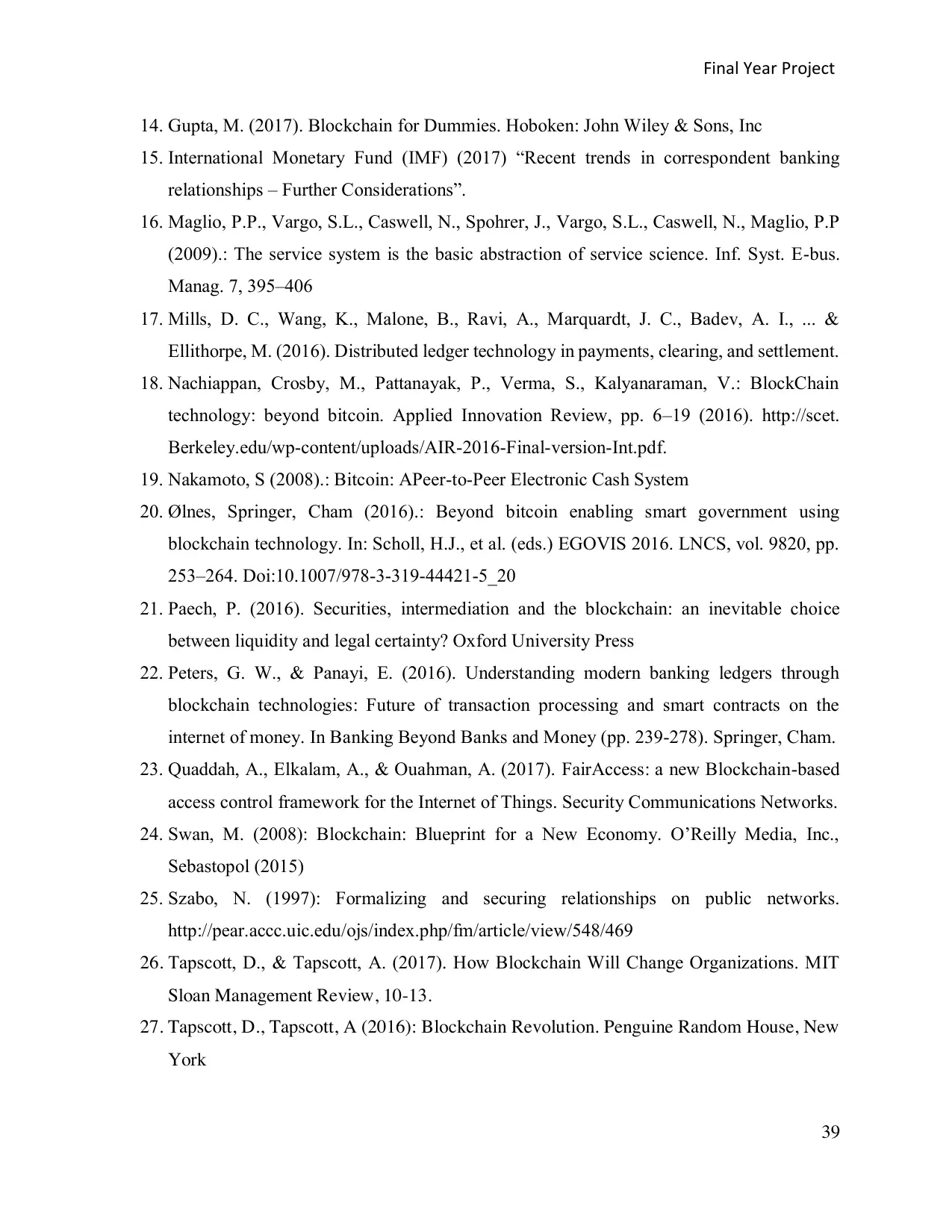
Final Year Project
39
14. Gupta, M. (2017). Blockchain for Dummies. Hoboken: John Wiley & Sons, Inc
15. International Monetary Fund (IMF) (2017) “Recent trends in correspondent banking
relationships – Further Considerations”.
16. Maglio, P.P., Vargo, S.L., Caswell, N., Spohrer, J., Vargo, S.L., Caswell, N., Maglio, P.P
(2009).: The service system is the basic abstraction of service science. Inf. Syst. E-bus.
Manag. 7, 395–406
17. Mills, D. C., Wang, K., Malone, B., Ravi, A., Marquardt, J. C., Badev, A. I., ... &
Ellithorpe, M. (2016). Distributed ledger technology in payments, clearing, and settlement.
18. Nachiappan, Crosby, M., Pattanayak, P., Verma, S., Kalyanaraman, V.: BlockChain
technology: beyond bitcoin. Applied Innovation Review, pp. 6–19 (2016). http://scet.
Berkeley.edu/wp-content/uploads/AIR-2016-Final-version-Int.pdf.
19. Nakamoto, S (2008).: Bitcoin: APeer-to-Peer Electronic Cash System
20. Ølnes, Springer, Cham (2016).: Beyond bitcoin enabling smart government using
blockchain technology. In: Scholl, H.J., et al. (eds.) EGOVIS 2016. LNCS, vol. 9820, pp.
253–264. Doi:10.1007/978-3-319-44421-5_20
21. Paech, P. (2016). Securities, intermediation and the blockchain: an inevitable choice
between liquidity and legal certainty? Oxford University Press
22. Peters, G. W., & Panayi, E. (2016). Understanding modern banking ledgers through
blockchain technologies: Future of transaction processing and smart contracts on the
internet of money. In Banking Beyond Banks and Money (pp. 239-278). Springer, Cham.
23. Quaddah, A., Elkalam, A., & Ouahman, A. (2017). FairAccess: a new Blockchain-based
access control framework for the Internet of Things. Security Communications Networks.
24. Swan, M. (2008): Blockchain: Blueprint for a New Economy. O’Reilly Media, Inc.,
Sebastopol (2015)
25. Szabo, N. (1997): Formalizing and securing relationships on public networks.
http://pear.accc.uic.edu/ojs/index.php/fm/article/view/548/469
26. Tapscott, D., & Tapscott, A. (2017). How Blockchain Will Change Organizations. MIT
Sloan Management Review, 10-13.
27. Tapscott, D., Tapscott, A (2016): Blockchain Revolution. Penguine Random House, New
York
39
14. Gupta, M. (2017). Blockchain for Dummies. Hoboken: John Wiley & Sons, Inc
15. International Monetary Fund (IMF) (2017) “Recent trends in correspondent banking
relationships – Further Considerations”.
16. Maglio, P.P., Vargo, S.L., Caswell, N., Spohrer, J., Vargo, S.L., Caswell, N., Maglio, P.P
(2009).: The service system is the basic abstraction of service science. Inf. Syst. E-bus.
Manag. 7, 395–406
17. Mills, D. C., Wang, K., Malone, B., Ravi, A., Marquardt, J. C., Badev, A. I., ... &
Ellithorpe, M. (2016). Distributed ledger technology in payments, clearing, and settlement.
18. Nachiappan, Crosby, M., Pattanayak, P., Verma, S., Kalyanaraman, V.: BlockChain
technology: beyond bitcoin. Applied Innovation Review, pp. 6–19 (2016). http://scet.
Berkeley.edu/wp-content/uploads/AIR-2016-Final-version-Int.pdf.
19. Nakamoto, S (2008).: Bitcoin: APeer-to-Peer Electronic Cash System
20. Ølnes, Springer, Cham (2016).: Beyond bitcoin enabling smart government using
blockchain technology. In: Scholl, H.J., et al. (eds.) EGOVIS 2016. LNCS, vol. 9820, pp.
253–264. Doi:10.1007/978-3-319-44421-5_20
21. Paech, P. (2016). Securities, intermediation and the blockchain: an inevitable choice
between liquidity and legal certainty? Oxford University Press
22. Peters, G. W., & Panayi, E. (2016). Understanding modern banking ledgers through
blockchain technologies: Future of transaction processing and smart contracts on the
internet of money. In Banking Beyond Banks and Money (pp. 239-278). Springer, Cham.
23. Quaddah, A., Elkalam, A., & Ouahman, A. (2017). FairAccess: a new Blockchain-based
access control framework for the Internet of Things. Security Communications Networks.
24. Swan, M. (2008): Blockchain: Blueprint for a New Economy. O’Reilly Media, Inc.,
Sebastopol (2015)
25. Szabo, N. (1997): Formalizing and securing relationships on public networks.
http://pear.accc.uic.edu/ojs/index.php/fm/article/view/548/469
26. Tapscott, D., & Tapscott, A. (2017). How Blockchain Will Change Organizations. MIT
Sloan Management Review, 10-13.
27. Tapscott, D., Tapscott, A (2016): Blockchain Revolution. Penguine Random House, New
York
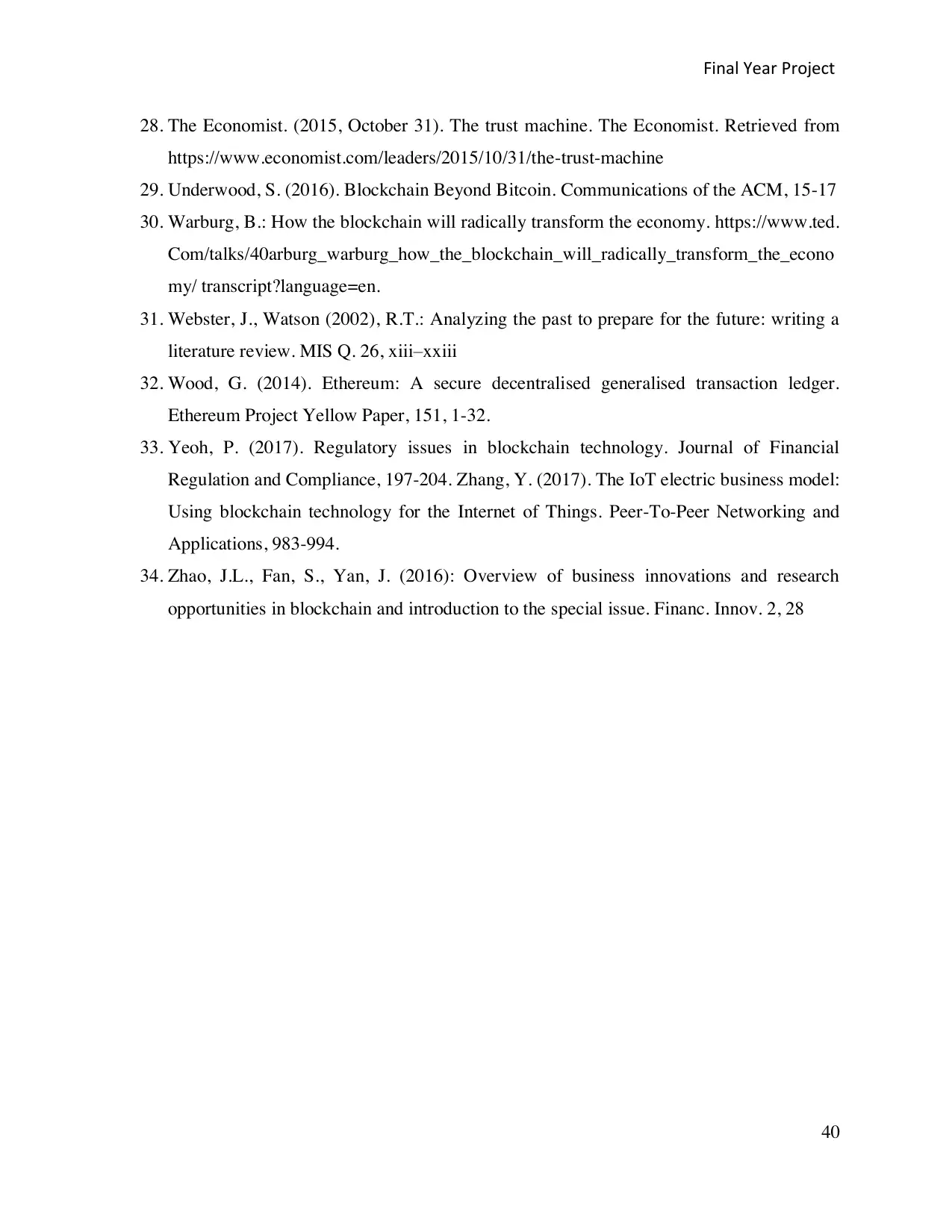
Final Year Project
40
28. The Economist. (2015, October 31). The trust machine. The Economist. Retrieved from
https://www.economist.com/leaders/2015/10/31/the-trust-machine
29. Underwood, S. (2016). Blockchain Beyond Bitcoin. Communications of the ACM, 15-17
30. Warburg, B.: How the blockchain will radically transform the economy. https://www.ted.
Com/talks/40arburg_warburg_how_the_blockchain_will_radically_transform_the_econo
my/ transcript?language=en.
31. Webster, J., Watson (2002), R.T.: Analyzing the past to prepare for the future: writing a
literature review. MIS Q. 26, xiii–xxiii
32. Wood, G. (2014). Ethereum: A secure decentralised generalised transaction ledger.
Ethereum Project Yellow Paper, 151, 1-32.
33. Yeoh, P. (2017). Regulatory issues in blockchain technology. Journal of Financial
Regulation and Compliance, 197-204. Zhang, Y. (2017). The IoT electric business model:
Using blockchain technology for the Internet of Things. Peer-To-Peer Networking and
Applications, 983-994.
34. Zhao, J.L., Fan, S., Yan, J. (2016): Overview of business innovations and research
opportunities in blockchain and introduction to the special issue. Financ. Innov. 2, 28
40
28. The Economist. (2015, October 31). The trust machine. The Economist. Retrieved from
https://www.economist.com/leaders/2015/10/31/the-trust-machine
29. Underwood, S. (2016). Blockchain Beyond Bitcoin. Communications of the ACM, 15-17
30. Warburg, B.: How the blockchain will radically transform the economy. https://www.ted.
Com/talks/40arburg_warburg_how_the_blockchain_will_radically_transform_the_econo
my/ transcript?language=en.
31. Webster, J., Watson (2002), R.T.: Analyzing the past to prepare for the future: writing a
literature review. MIS Q. 26, xiii–xxiii
32. Wood, G. (2014). Ethereum: A secure decentralised generalised transaction ledger.
Ethereum Project Yellow Paper, 151, 1-32.
33. Yeoh, P. (2017). Regulatory issues in blockchain technology. Journal of Financial
Regulation and Compliance, 197-204. Zhang, Y. (2017). The IoT electric business model:
Using blockchain technology for the Internet of Things. Peer-To-Peer Networking and
Applications, 983-994.
34. Zhao, J.L., Fan, S., Yan, J. (2016): Overview of business innovations and research
opportunities in blockchain and introduction to the special issue. Financ. Innov. 2, 28
Secure Best Marks with AI Grader
Need help grading? Try our AI Grader for instant feedback on your assignments.
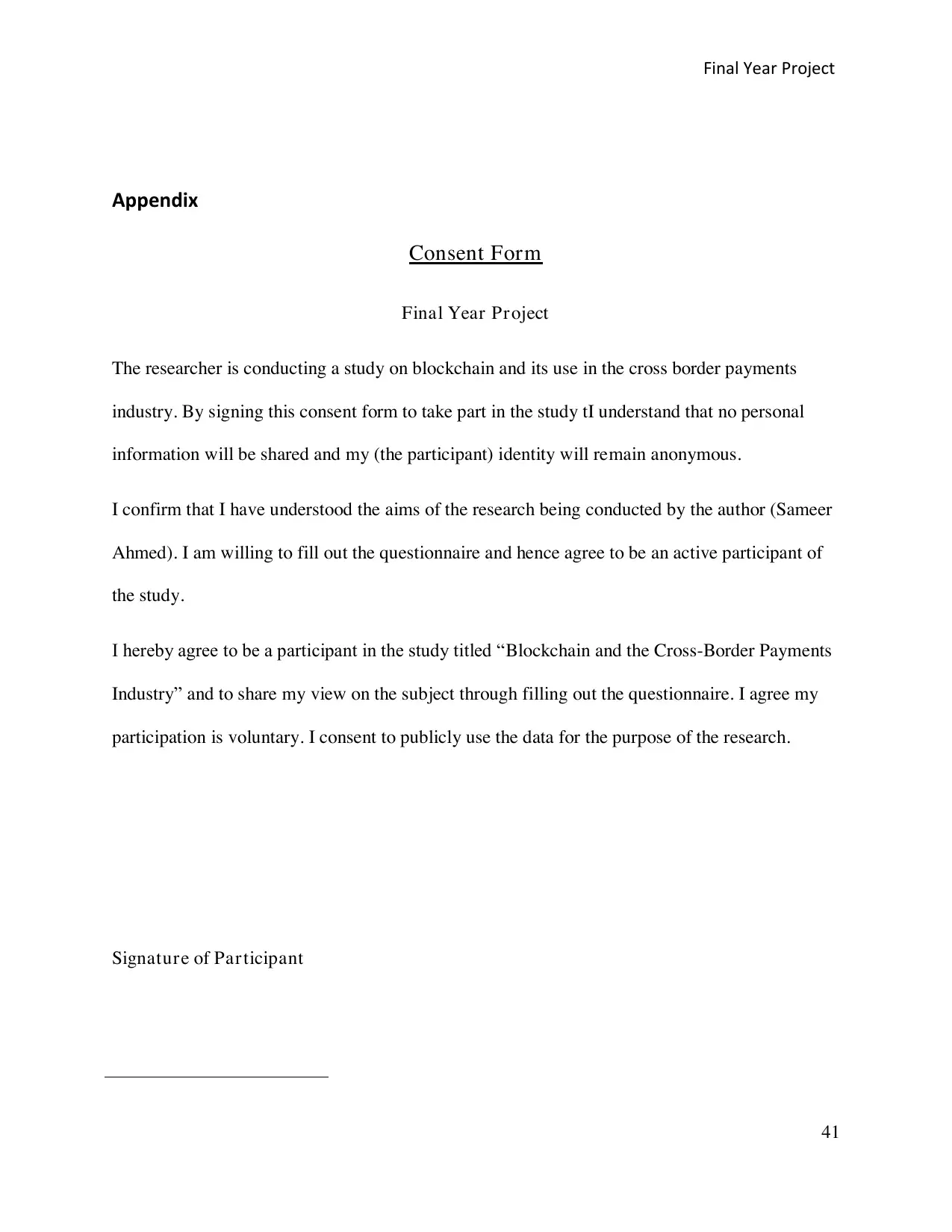
Final Year Project
41
Appendix
Consent Form
Final Year Project
The researcher is conducting a study on blockchain and its use in the cross border payments
industry. By signing this consent form to take part in the study tI understand that no personal
information will be shared and my (the participant) identity will remain anonymous.
I confirm that I have understood the aims of the research being conducted by the author (Sameer
Ahmed). I am willing to fill out the questionnaire and hence agree to be an active participant of
the study.
I hereby agree to be a participant in the study titled “Blockchain and the Cross-Border Payments
Industry” and to share my view on the subject through filling out the questionnaire. I agree my
participation is voluntary. I consent to publicly use the data for the purpose of the research.
Signature of Participant
41
Appendix
Consent Form
Final Year Project
The researcher is conducting a study on blockchain and its use in the cross border payments
industry. By signing this consent form to take part in the study tI understand that no personal
information will be shared and my (the participant) identity will remain anonymous.
I confirm that I have understood the aims of the research being conducted by the author (Sameer
Ahmed). I am willing to fill out the questionnaire and hence agree to be an active participant of
the study.
I hereby agree to be a participant in the study titled “Blockchain and the Cross-Border Payments
Industry” and to share my view on the subject through filling out the questionnaire. I agree my
participation is voluntary. I consent to publicly use the data for the purpose of the research.
Signature of Participant
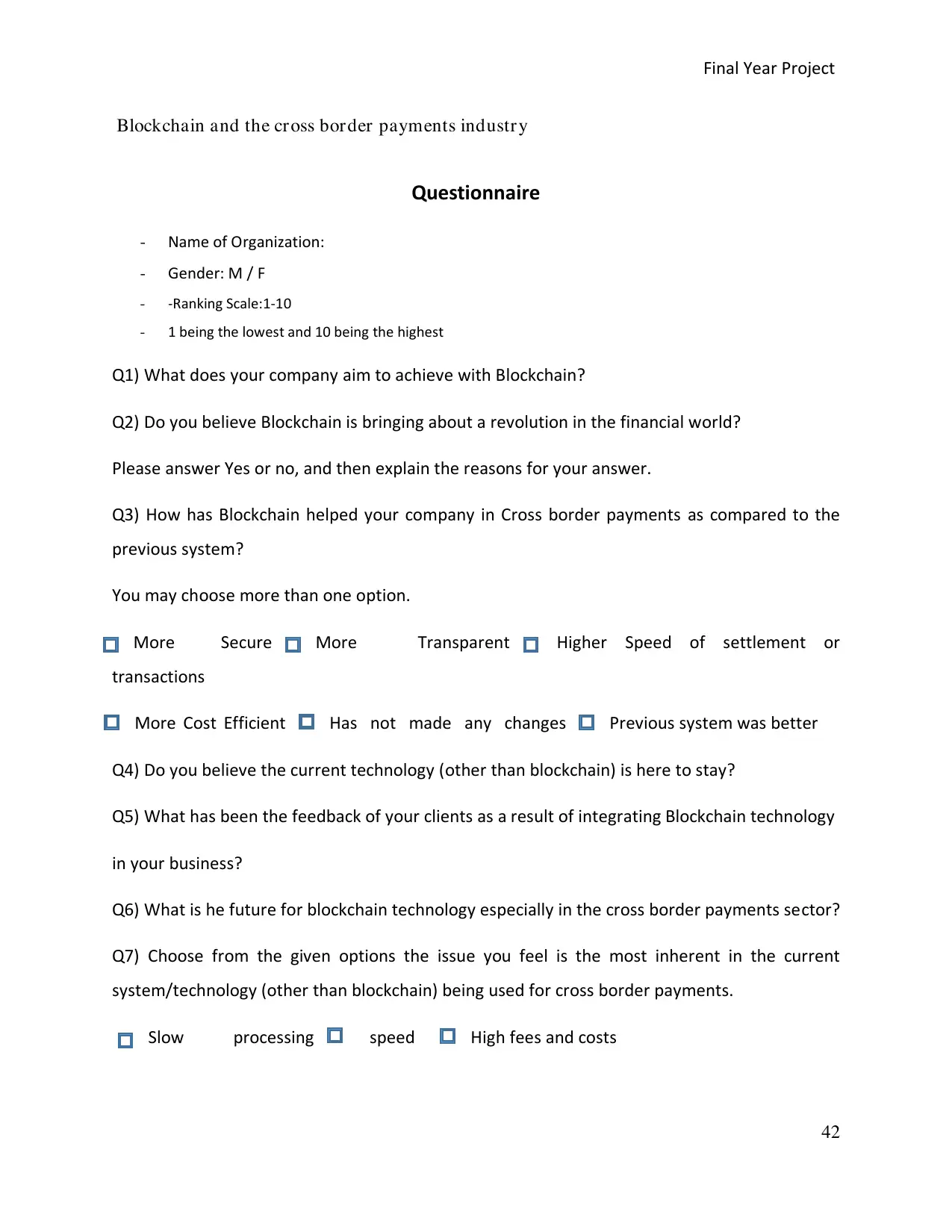
Final Year Project
42
Blockchain and the cross border payments industry
Questionnaire
- Name of Organization:
- Gender: M / F
- -Ranking Scale:1-10
- 1 being the lowest and 10 being the highest
Q1) What does your company aim to achieve with Blockchain?
Q2) Do you believe Blockchain is bringing about a revolution in the financial world?
Please answer Yes or no, and then explain the reasons for your answer.
Q3) How has Blockchain helped your company in Cross border payments as compared to the
previous system?
You may choose more than one option.
More Secure More Transparent Higher Speed of settlement or
transactions
More Cost Efficient Has not made any changes Previous system was better
Q4) Do you believe the current technology (other than blockchain) is here to stay?
Q5) What has been the feedback of your clients as a result of integrating Blockchain technology
in your business?
Q6) What is he future for blockchain technology especially in the cross border payments sector?
Q7) Choose from the given options the issue you feel is the most inherent in the current
system/technology (other than blockchain) being used for cross border payments.
Slow processing speed High fees and costs
42
Blockchain and the cross border payments industry
Questionnaire
- Name of Organization:
- Gender: M / F
- -Ranking Scale:1-10
- 1 being the lowest and 10 being the highest
Q1) What does your company aim to achieve with Blockchain?
Q2) Do you believe Blockchain is bringing about a revolution in the financial world?
Please answer Yes or no, and then explain the reasons for your answer.
Q3) How has Blockchain helped your company in Cross border payments as compared to the
previous system?
You may choose more than one option.
More Secure More Transparent Higher Speed of settlement or
transactions
More Cost Efficient Has not made any changes Previous system was better
Q4) Do you believe the current technology (other than blockchain) is here to stay?
Q5) What has been the feedback of your clients as a result of integrating Blockchain technology
in your business?
Q6) What is he future for blockchain technology especially in the cross border payments sector?
Q7) Choose from the given options the issue you feel is the most inherent in the current
system/technology (other than blockchain) being used for cross border payments.
Slow processing speed High fees and costs
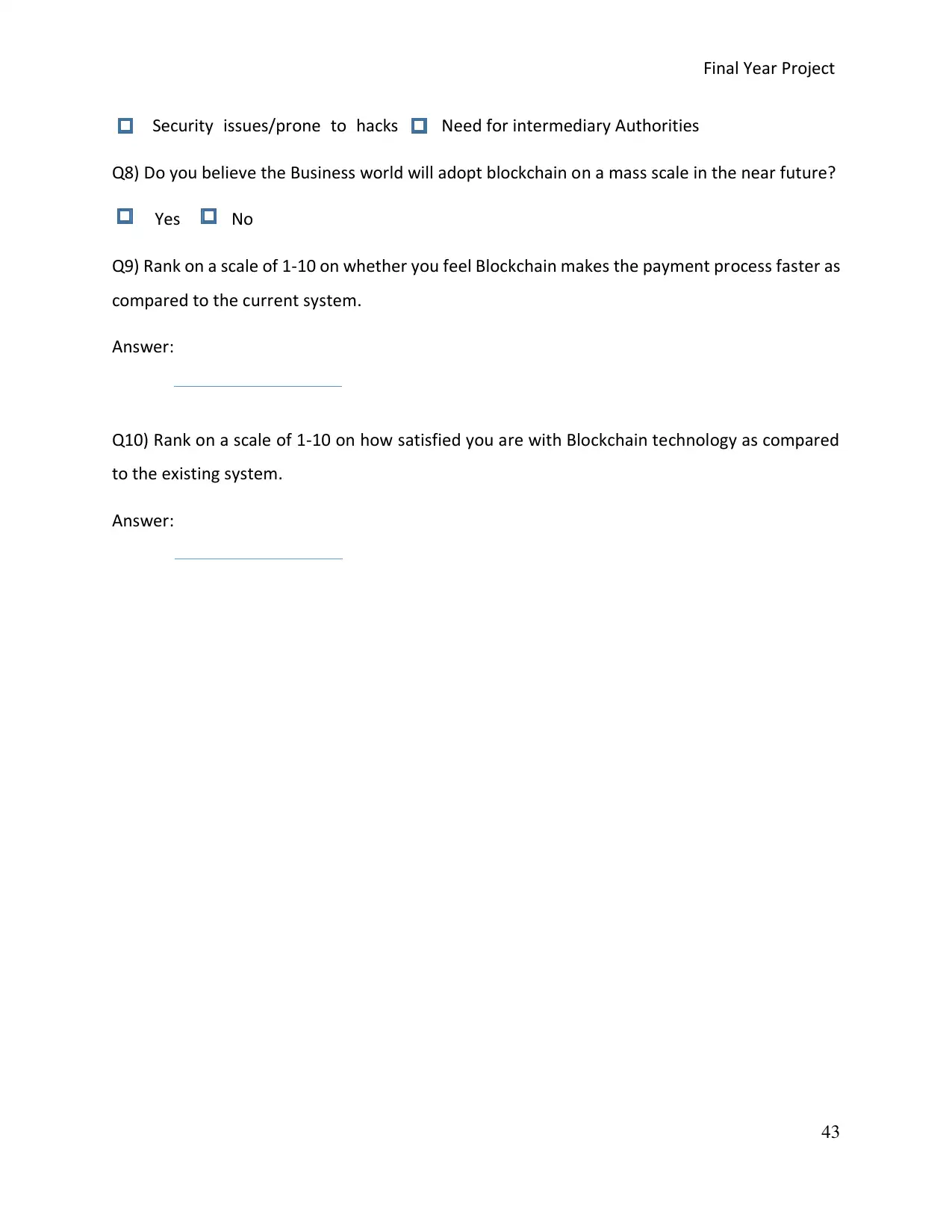
Final Year Project
43
Security issues/prone to hacks Need for intermediary Authorities
Q8) Do you believe the Business world will adopt blockchain on a mass scale in the near future?
Yes No
Q9) Rank on a scale of 1-10 on whether you feel Blockchain makes the payment process faster as
compared to the current system.
Answer:
Q10) Rank on a scale of 1-10 on how satisfied you are with Blockchain technology as compared
to the existing system.
Answer:
43
Security issues/prone to hacks Need for intermediary Authorities
Q8) Do you believe the Business world will adopt blockchain on a mass scale in the near future?
Yes No
Q9) Rank on a scale of 1-10 on whether you feel Blockchain makes the payment process faster as
compared to the current system.
Answer:
Q10) Rank on a scale of 1-10 on how satisfied you are with Blockchain technology as compared
to the existing system.
Answer:
1 out of 43
Related Documents
Your All-in-One AI-Powered Toolkit for Academic Success.
+13062052269
info@desklib.com
Available 24*7 on WhatsApp / Email
![[object Object]](/_next/static/media/star-bottom.7253800d.svg)
Unlock your academic potential
© 2024 | Zucol Services PVT LTD | All rights reserved.





